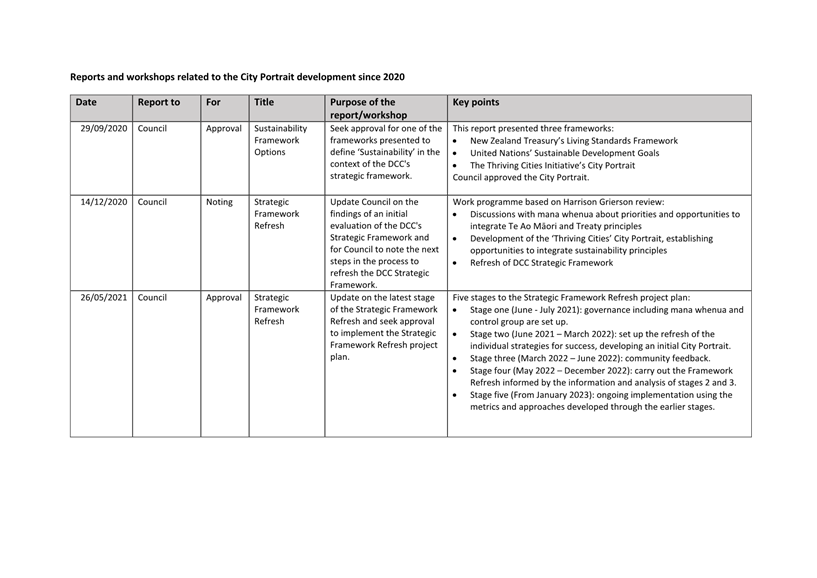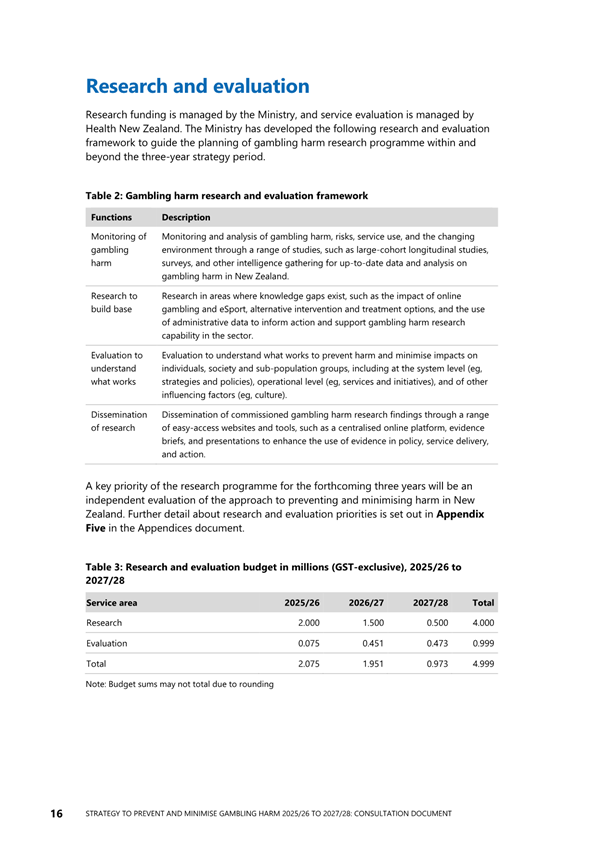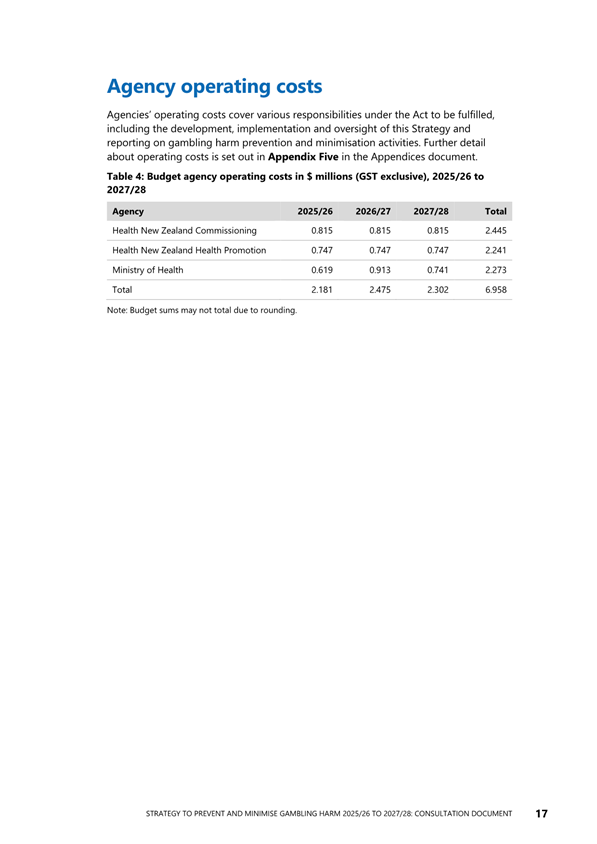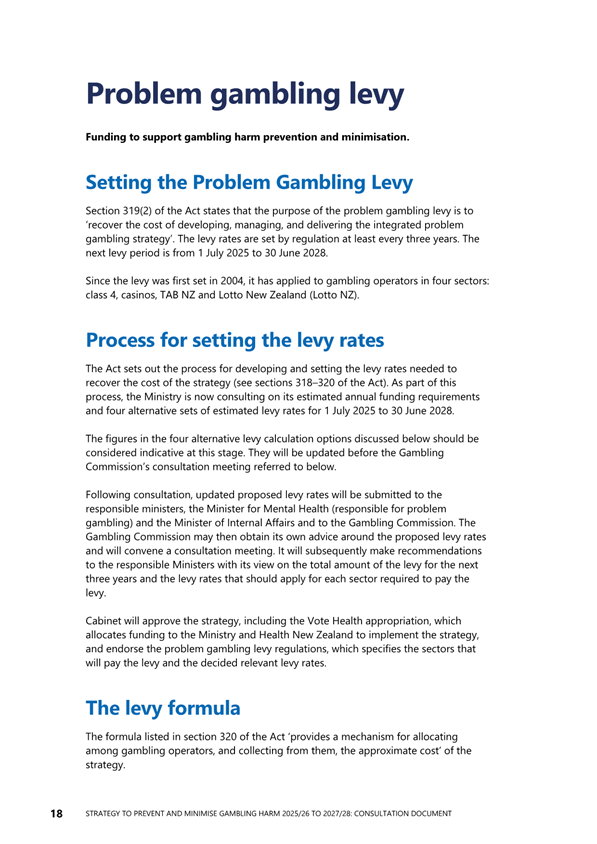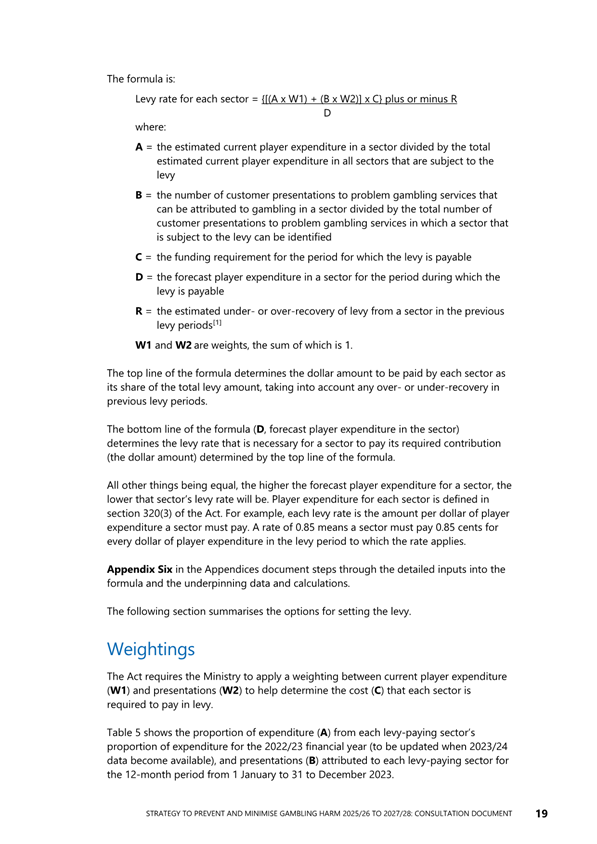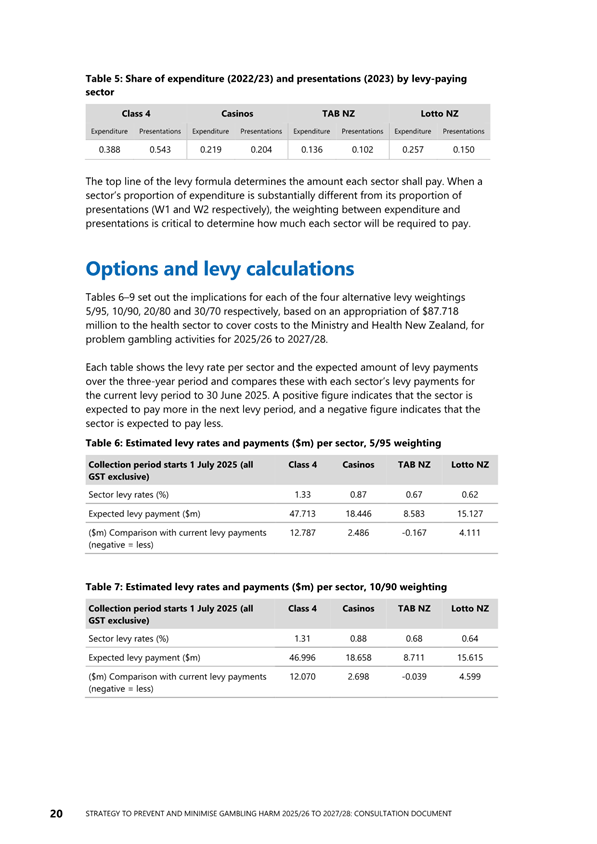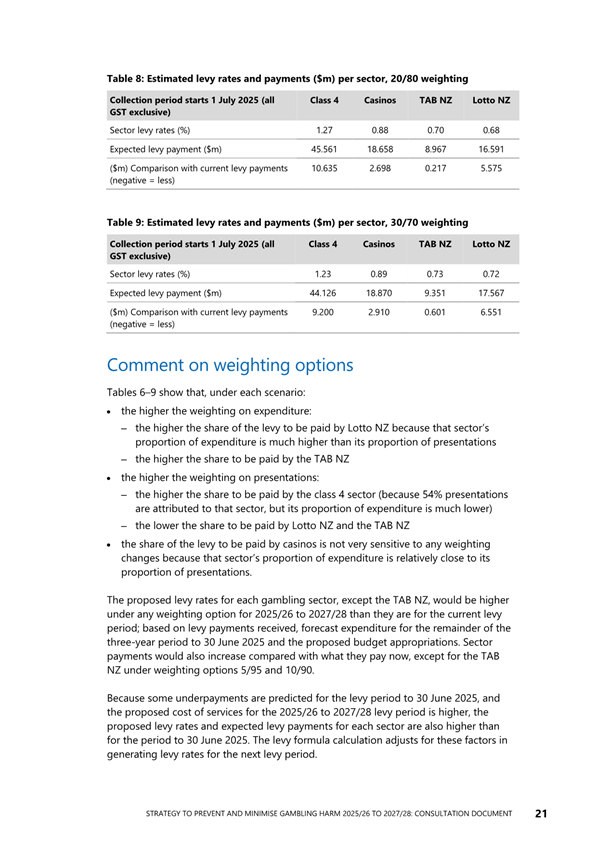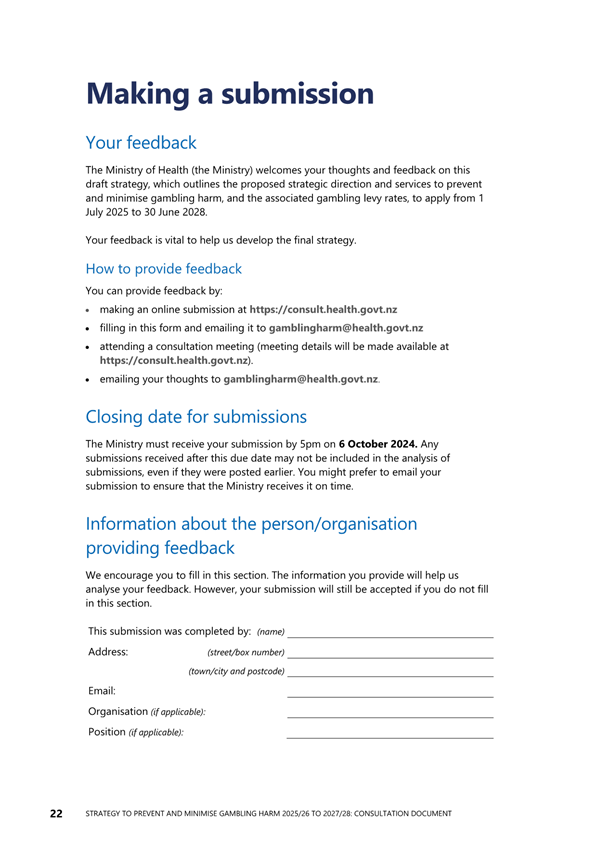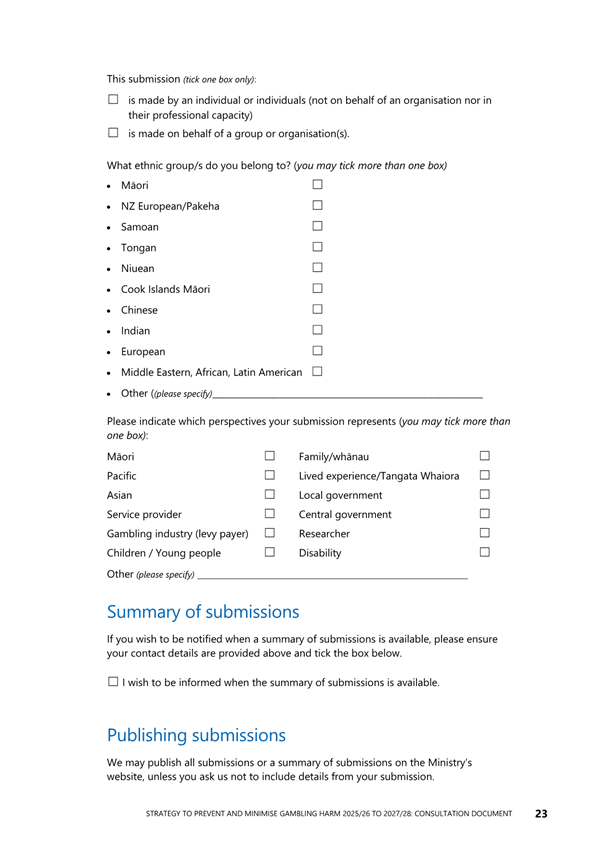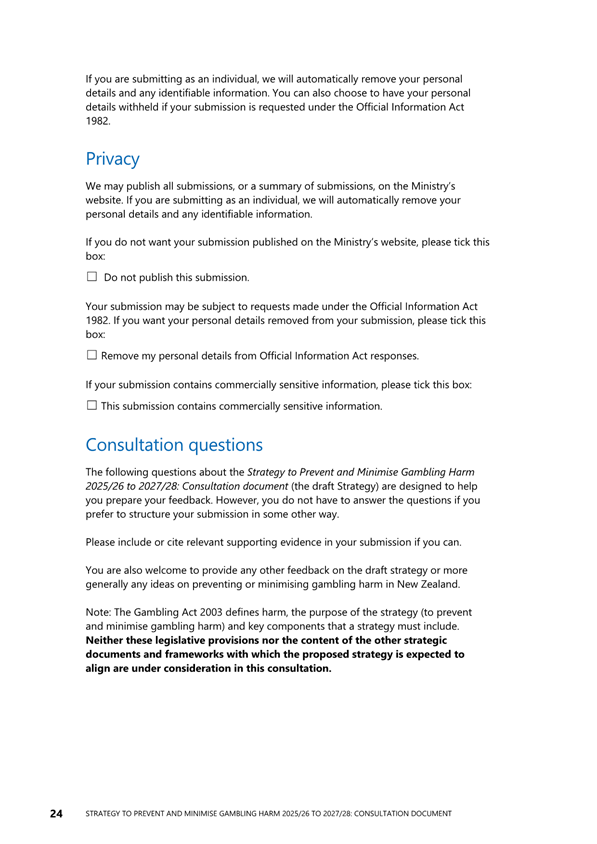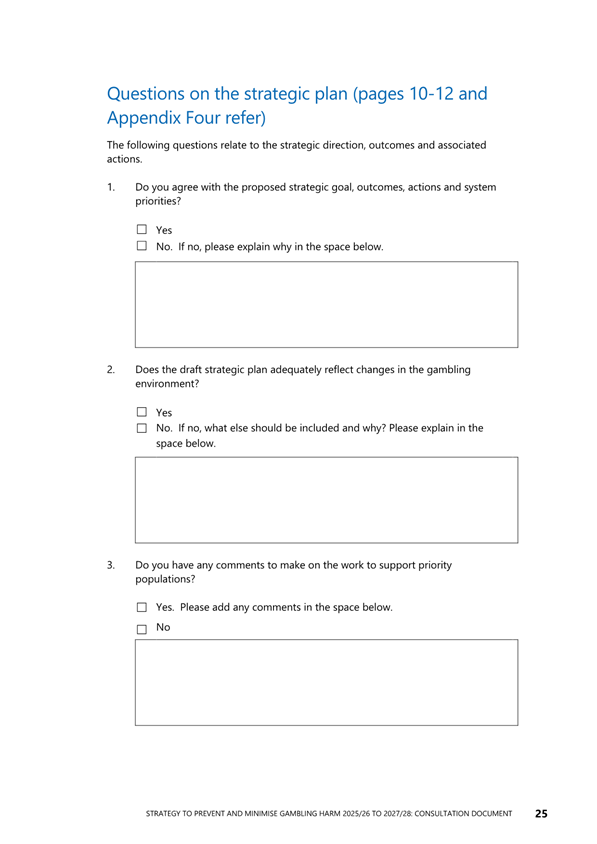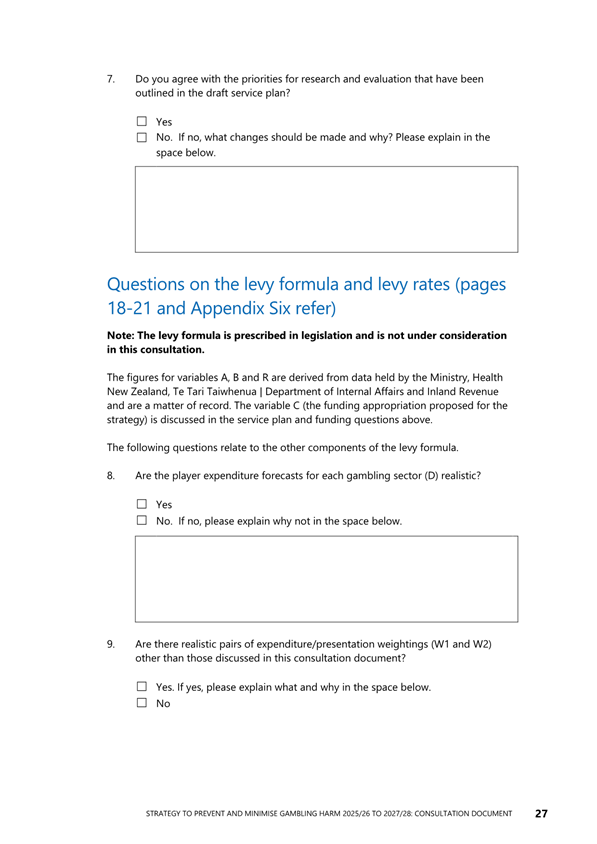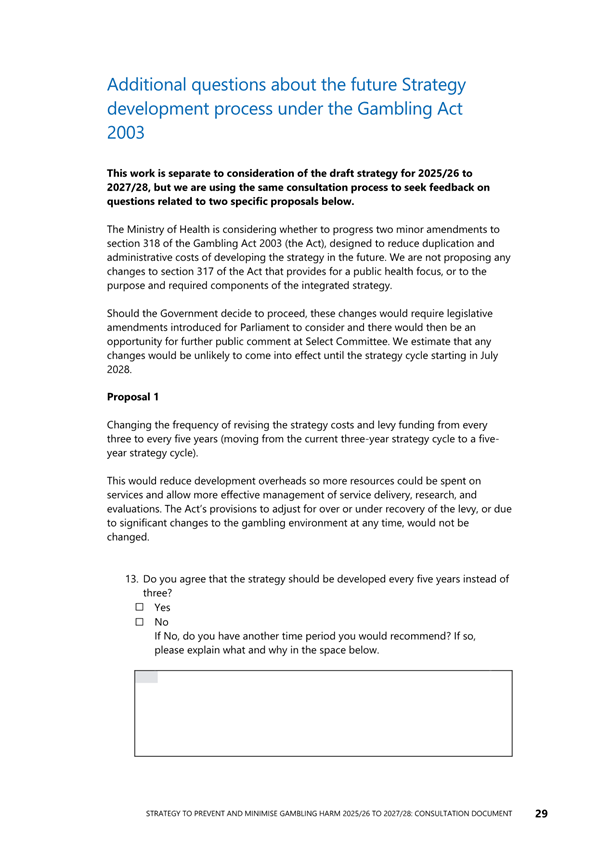
Notice of Meeting:
I hereby give notice that an ordinary meeting of the Dunedin
City Council will be held on:
Date: Tuesday
24 September 2024
Time: 10.00
am
Venue: Council
Chamber, Dunedin Public Art Gallery, The Octagon, Dunedin
Sandy Graham
Council
PUBLIC AGENDA
|
Mayor
|
Mayor Jules Radich
|
|
|
Deputy Mayor
|
Cr Cherry Lucas
|
|
|
Members
|
Cr Bill Acklin
|
Cr Sophie Barker
|
|
|
Cr David Benson-Pope
|
Cr Christine Garey
|
|
|
Cr Kevin Gilbert
|
Cr Carmen Houlahan
|
|
|
Cr Marie Laufiso
|
Cr Mandy Mayhem
|
|
|
Cr Jim O'Malley
|
Cr Lee Vandervis
|
|
|
Cr Steve Walker
|
Cr Brent Weatherall
|
|
|
Cr Andrew Whiley
|
|
Senior Officer Sandy
Graham, Chief Executive Officer
Governance Support Officer Lynne
Adamson
Lynne Adamson
Governance Support Officer
Telephone: 03 477 4000
governance.support@dcc.govt.nz
www.dunedin.govt.nz
Note: Reports
and recommendations contained in this agenda are not to be considered as
Council policy until adopted.
|

|
Council
24 September 2024
|
ITEM TABLE OF CONTENTS PAGE
1 Opening 4
2 Public
Forum 4
3 Apologies 4
4 Confirmation
of Agenda 4
5 Declaration
of Interest 5
6 Confirmation
of Minutes 16
6.1 Ordinary Council
meeting - 27 August 2024 16
Reports
7 Residents'
Opinion Survey Results 2023/24 28
8 Approval
to Notify Plan Change 1 – Minor Improvements to the 2GP 118
9 Sustainability
Framework 130
10 South
Dunedin Future - Risk Assessment Update and Programme Changes 151
11 Submission
on A New Strategy to Prevent and Minimise Gambling Harm 161
12 Litter
Compliance Policy 2024 205
13 Submission
on the Otago Regional Council Air Quality Management Review 217
14 Proposed
Event Road Closures 250
Resolution to Exclude the Public 261
|

|
Council
24 September 2024
|
1 Opening
Geshe Lobsang Dhonye, and Geshe Losang Gyatso will open the
meeting with a prayer on behalf of the Dhargyey Buddhist Centre.
2 Public
Forum
At the close of the
agenda public forum registrations were still being taken. The speakers
will be confirmed following closure of registrations 24 hours before the
meeting starts.
3 Apologies
At the close of the agenda no
apologies had been received.
4 Confirmation
of agenda
Note:
Any additions must be approved by resolution with an explanation as to why they
cannot be delayed until a future meeting.
|

|
Council
24 September 2024
|
Declaration of Interest
EXECUTIVE SUMMARY
1. Members
are reminded of the need to stand aside from decision-making when a conflict
arises between their role as an elected representative and any private or other
external interest they might have.
2. Elected members are reminded to update their register of interests as soon as
practicable, including amending the register at this meeting if necessary.
3. Staff are
reminded to update their register of interests as soon as practicable.
RECOMMENDATIONS
That the Council:
a) Notes/Amends if
necessary the Elected Members' Interest Register attached as Attachment A; and
b) Confirms/Amends the
proposed management plan for Elected Members' Interests.
c) Notes the proposed
management plan for the Executive Leadership Team’s Interests.
Attachments
|
|
Title
|
Page
|
|
⇩a
|
Councillor Interest
Register
|
6
|
|
⇩b
|
Executive Leadership
Team Interest Register
|
14
|
|

|
Council
24 September 2024
|








|

|
Council
24 September 2024
|

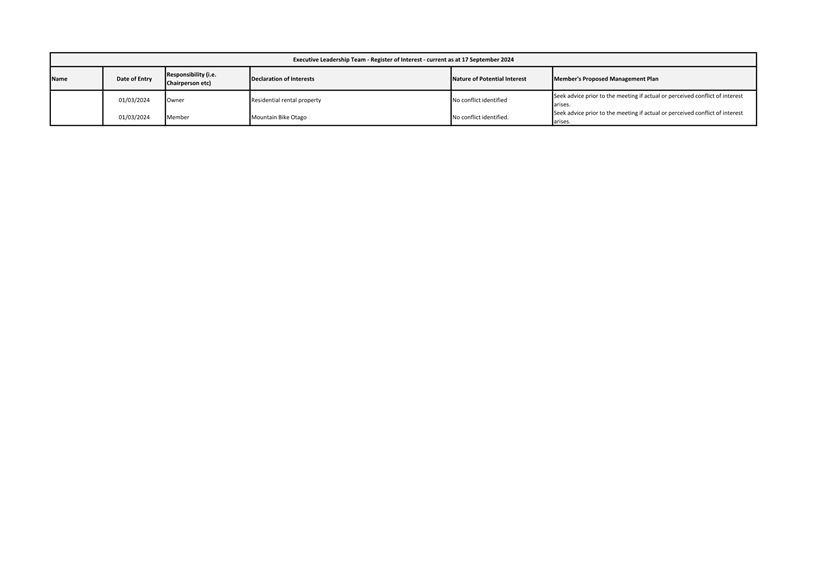
|

|
Council
24 September 2024
|
Confirmation
of Minutes
Ordinary
Council meeting - 27 August 2024
RECOMMENDATIONS
That the Council:
a) Confirms the public
part of the minutes of the Ordinary Council meeting held on 27 August 2024 as a
correct record.
Attachments
|
|
Title
|
Page
|
|
A⇩
|
Minutes of Ordinary
Council meeting held on 27 August 2024
|
17
|
|

|
Council
24 September 2024
|

Council
MINUTES
Minutes of an ordinary
meeting of the Dunedin City Council held in the Council Chamber, Dunedin Public
Art Gallery, The Octagon, Dunedin on Tuesday 27 August 2024, commencing at
10.00 am
PRESENT
|
Mayor
|
Mayor Jules Radich
|
|
|
Deputy Mayor
|
Cr Cherry Lucas
|
|
|
Members
|
Cr Bill Acklin
|
Cr Sophie Barker
|
|
|
Cr David Benson-Pope
|
Cr Christine Garey
|
|
|
Cr Kevin Gilbert
|
Cr Carmen Houlahan
|
|
|
Cr Marie Laufiso
|
Cr Mandy Mayhem
|
|
|
Cr Jim O'Malley
|
Cr Lee Vandervis
|
|
|
Cr Brent Weatherall
|
Cr Andrew Whiley
|
|
IN ATTENDANCE
|
Sandy Graham (Chief Executive
Officer), Robert West (General Manager Corporate Services), Carolyn Allan
(Chief Financial Officer), Scott MacLean (General Manager Climate and City
Growth), David Ward (General Manager 3 Waters and Transition), Nicola Morand
(Manahautū - General Manager Policy and Partnerships), Paul Henderson
(Acting General Manager Customer and Regulatory), Antony Deaker (Economic
Development Team Leader) and Florence Reynolds (Acting Manager – Zero
Carbon)
|
Governance Support Officer Lynne
Adamson
1 Opening
Colin MacLeod, Chair – NZ Catholic
Bishops Committee opened the meeting with a prayer.
2 Public
Forum
One group attended the public
forum.
2.1 Celebration
of Festival “Raksha Bandhan”
Dinesh Pahuja
(HSS National Public Relations Officer) spoke on the Festival of Raksha
Bandhan.
Cr Carmen
Houlahan entered the meeting at 10.04 am.
Mr Pahuja
responded to questions.
Cr Bill Acklin
entered the meeting at 10.14 am.
Members of the
Hindu Swayamsevak Sangh tied handmade rakhis (bracelets) in celebration of the
Festival of Raksha Bandhan on the wrists of Councillors.
|
3 Apologies
|
|
|
Moved (Mayor Jules Radich/Cr Cherry Lucas):
That the Council:
Accepts the apology from
Cr Steve Walker.
Motion
carried (CNL/2024/147)
|
|
4 Confirmation
of agenda
|
|
|
Moved (Cr Carmen Houlahan/Cr Cherry Lucas):
That the Council:
Confirms the agenda with
the following alteration:
- That
item S2 Proposed 2024/25 Zero Carbon Implementation Plan on the supplementary
agenda be taken before Item 12 – Non-Trading Council Controlled
Organisations – Application for Exemption.
Motion
carried (CNL/2024/148)
|
5 Declarations
of interest
Members were
reminded of the need to stand aside from decision-making when a conflict arose
between their role as an elected representative and any private or other
external interest they might have.
|
|
Moved (Mayor Jules Radich/Cr Kevin Gilbert):
That the Council:
a) Notes the Elected Members' Interest Register; and
b) Confirms the proposed management plan for
Elected Members' Interests.
c) Notes the proposed management plan for the Executive
Leadership Team’s Interests.
Motion
carried (CNL/2024/149)
|
6 Confirmation
of Minutes
|
6.1 Ordinary
Council meeting - 31 July 2024
|
|
|
Moved (Mayor Jules Radich/Cr Mandy Mayhem):
That the Council:
a) Confirms the public part of the minutes of the
Ordinary Council meeting held on 31 July 2024 as a correct record.
Motion
carried (CNL/2024/150)
|
|
6.2 Extraordinary
Council meeting - 19 August 2024
|
|
|
Moved (Mayor Jules Radich/Cr Cherry Lucas):
That the Council:
a) Confirms the public part of the minutes of the
Extraordinary Council meeting held on 19 August 2024 as a correct record.
Motion
carried (CNL/2024/151)
|
Reports
|
7 Actions
From Resolutions of Council Meetings
|
|
|
A report from Civic
provided an update on the implementation of resolutions made at Council
meetings.
|
|
|
The Chief Executive Officer (Sandy Graham) spoke to the
report and responded to questions.
|
|
|
Moved (Mayor Jules Radich/Cr Cherry Lucas):
That the Council:
a) Notes
the Open and Completed Actions from resolutions of Council meetings.
Motion
carried (CNL/2024/152)
|
|
8 Forward
Work Programme for Council - August 2024
|
|
|
A report from Civic
provided an update on the forward work programme for the 2024-25 year.
|
|
|
The Chief Executive Officer (Sandy Graham) spoke to the
report and responded to questions.
|
|
|
Moved (Mayor Jules Radich/Cr Kevin Gilbert):
That the Council:
a) Notes the updated Council forward work programme.
Motion
carried (CNL/2024/153)
|
|
9 9
Year Plan Forward Work Programme - August 2024
|
|
|
A report
from Civic provided an update on the forward work programme for the
development of the 9 year plan.
|
|
|
The Chief Executive Officer (Sandy Graham) spoke to the
report and responded to questions.
|
|
|
Moved (Mayor Jules Radich/Cr Kevin Gilbert):
That the Council:
a) Notes the updated Council forward work programme.
Motion
carried (CNL/2024/154)
|
|
10 Submission
on the redesign of the vocational education and training system
|
|
|
A report from Corporate
Policy and Enterprise Dunedin sought approval of a draft submission to the
Ministry of Education (MoE) and the Tertiary Education Commission
(TEC)’s consultation on proposals for redesigning New Zealand’s
vocational education and training system.
|
|
|
The Manahautū (General Manager Māori Partnerships
and Policy) (Nicola Morand) and Economic Development Team Leader (Antony
Deaker) spoke to the report and responded to questions.
|
|
|
Moved (Cr Andrew Whiley/Mayor Jules Radich):
That the Council:
a) Approves the DCC submission on the
“Redesign of the vocational education and training system”
b) Authorises the Chief Executive Officer to make any
minor editorial amendments to the submission.
Motion
carried (CNL/2024/155)
|
|
11 Zero
Carbon Plan Advisory Panel - draft Terms of Reference
|
|
|
A report from the
Sustainability Group presented the draft Terms of Reference (ToR) for the
Zero Carbon Plan Advisory Panel for adoption.
|
|
|
The General Manager, Climate and City Growth (Scott
MacLean) and Acting Manager Zero Carbon (Florence Reynolds) spoke to the
report and responded to questions on the draft Terms of Reference.
|
|
Moved Cr Marie Laufiso/Cr Christine Garey):
That the Council:
Adjourns
the meeting for five minutes.
Motion
carried
The meeting adjourned at 11.01 am and reconvened at 11.06
am.
Cr Mandy Mayhem entered the meeting at 11.07 am.
|
|
|
Moved (Cr Cherry Lucas/Cr Sophie Barker):
That the Council:
a) Adopts the Zero Carbon Plan Advisory Panel
Terms of Reference with agreed amendments to the frequency of reporting and
meetings and membership.
Motion
carried (CNL/2024/156) with Cr David Benson-Pope recording his
vote against
|
|
S2 Proposed
2024/25 Zero Carbon Implementation Plan
|
|
|
A report from the
Sustainability Group presented the 2024/25 Zero Carbon Implementation plan.
|
|
|
The General Manager, Climate and City Growth (Scott
MacLean) and Acting Manager Zero Carbon (Florence Reynolds) spoke to the
report and responded to questions on the 2024/25 Zero Carbon Implementation
Plan.
|
|
|
Moved (Cr Sophie Barker/Cr Cherry Lucas):
That the Council:
a) Notes the proposed 2024/25 Zero Carbon Implementation Plan.
Motion
carried (CNL/2024/157)
|
|
|
Moved (Cr Sophie Barker/Cr Cherry Lucas):
That the Council:
b) Refers the proposed 2024/25 Zero Carbon
Implementation Plan to the Zero Carbon Advisory Panel to refine the
implementation plan for approval by Council before 31 October 2024.
Motion
carried (CNL/2024/158)
|
|
|
Moved (Cr Sophie Barker/Cr Cherry Lucas):
That the Council:
c) Requests
that the Zero Carbon Alliance invites Business South to become a member of
the Zero Carbon Alliance.
Motion
carried (CNL/2024/159) with Cr Laufiso recording her vote against
|
|
12 Non-Trading
Council Controlled Organisations - Application for Exemption
|
|
|
A report from Civic sought an
exemption for non-trading Council Controlled Organisations from the
requirement to fulfil reporting and other requirements imposed by the Local
Government Act 2002.
|
|
|
The Chief Executive Officer (Sandy Graham) spoke to the
report and responded to questions.
|
|
|
Moved (Mayor Jules Radich/Cr Cherry Lucas):
That the Council:
a) Grants an exemption under section 7 of the
Local Government Act 2002 to each of the companies named below, whilst they
are not being used for any trading:
i) Tourism Dunedin Limited;
ii) Dunedin Events Limited;
iii) Dunedin Visitor Centre Limited;
iv) Otago Power Limited; and
v) Lakes Contract Services Limited.
Motion
carried (CNL/2024/160)
|
|
13 Proposed
Event Road Closures
|
|
|
A report from Transport
sought approval for temporary road closure applications relating to the
following events:
a) Graduation
Parade
b) Motorsport
Hillclimb
|
|
|
Moved (Cr Andrew Whiley/Cr Lee Vandervis):
That the Council:
a) Resolves to close the roads detailed below
(pursuant to Section 319, Section 342, and Schedule 10 clause 11(e) of the
Local Government Act 1974 (LGA 1974)):
i) Graduation
Parade
|
Friday
13 September 2024
|
10.30am to 11.00am
|
· Great King Street, from Frederick Street to Albany
Street
(Parade departs from Great King Street at 11.00am)
|
|
10.40am to 11.30am (approx.)
|
· Frederick Street, from Great King Street to George
Street
· George Street, from Frederick Street to Moray
Place
|
|
10.40am to 12.00pm
|
· Moray Place, from George Street to Upper Stuart
Street
· Filleul Street, from Moray Place to St Andrew
Street
|
ii) Motorsport Hillclimb
|
Saturday 16 November 2024
|
7.30am to 6.00pm
|
· Flagstaff-Whare Flat Road, from Rollinsons Road to
Longridge Road
|
|
Sunday 17 November 2024
|
7.30am to 6.00pm
|
· Three Mile Hill Road, from Halfway Bush Road to
Silverstream Valley Road
|
Motion
carried (CNL/2024/161)
|
|
14 Notice
of Motion - Possible Unitary Authority for Otago
|
|
|
In
accordance with Standing Order 26.1, a Notice of Motion was received from Cr
Kevin Gilbert.
|
|
During discussion Cr Carmen Houlahan left the meeting at
12.30 pm and returned at 12.33 pm.
|
|
|
Moved (Cr Kevin Gilbert/Cr Cherry Lucas):
That the Council:
a) Requests a high-level staff report on options
for progressing discussions about a possible unitary authority for Otago.
b) Notes these options include but are not limited to
establishment of Joint Committee to progress the discussion of a Local
Government Act 2002 17A review.
c) Notes that on receipt of the report, Council may need to
consider resourcing requirements to progress the preferred option.
d) Requests the report by December 2024.
Division
The Council voted by division
For: Crs
Bill Acklin, Sophie Barker, Kevin Gilbert, Cherry Lucas, Mandy Mayhem, Jim
O'Malley, Lee Vandervis, Brent Weatherall, Andrew Whiley and Mayor Jules
Radich (10).
Against: Crs
David Benson-Pope, Christine Garey, Carmen Houlahan and Marie Laufiso (4).
Abstained: Nil
The division
was declared CARRIED by 10 votes to 4
Motion
carried (CNL/2024/162)
|
|
Resolution to Exclude the Public
|
|
Moved (Mayor Jules Radich/Cr Cherry Lucas):
That the Council:
Pursuant
to the provisions of the Local Government Official Information and Meetings
Act 1987, exclude the public from the following part of the proceedings of
this meeting namely:
|
General
subject of the matter to be considered
|
Reasons for
passing this resolution in relation to each matter
|
Ground(s) under
section 48(1) for the passing of this resolution
|
Reason for
Confidentiality
|
|
C1
Ordinary Council meeting - 31 July 2024 - Public Excluded
|
S7(2)(a)
The withholding of
the information is necessary to protect the privacy of natural persons,
including that of a deceased person.
S7(2)(g)
The withholding of
the information is necessary to maintain legal professional privilege.
S7(2)(h)
The withholding of
the information is necessary to enable the local authority to carry out,
without prejudice or disadvantage, commercial activities.
S7(2)(i)
The withholding of
the information is necessary to enable the local authority to carry on,
without prejudice or disadvantage, negotiations (including commercial and
industrial negotiations).
|
.
|
|
|
C2
Extraordinary Council meeting - 19 August 2024 - Public Excluded
|
S7(2)(g)
The withholding of
the information is necessary to maintain legal professional privilege.
S7(2)(h)
The withholding of
the information is necessary to enable the local authority to carry out,
without prejudice or disadvantage, commercial activities.
S7(2)(i)
The withholding of
the information is necessary to enable the local authority to carry on,
without prejudice or disadvantage, negotiations (including commercial and
industrial negotiations).
|
.
|
|
|
C3
Confidential Council Actions from Resolutions at Council Meetings
|
S7(2)(a)
The withholding of
the information is necessary to protect the privacy of natural persons,
including that of a deceased person.
S7(2)(g)
The withholding of
the information is necessary to maintain legal professional privilege.
S7(2)(h)
The withholding of
the information is necessary to enable the local authority to carry out,
without prejudice or disadvantage, commercial activities.
S7(2)(i)
The withholding of
the information is necessary to enable the local authority to carry on,
without prejudice or disadvantage, negotiations (including commercial and
industrial negotiations).
|
S48(1)(a)
The public conduct of
the part of the meeting would be likely to result in the disclosure of
information for which good reason for withholding exists under section 7.
|
|
|
C4
Confidential Council Forward Work Programme - July 2024
|
S7(2)(h)
The withholding of
the information is necessary to enable the local authority to carry out,
without prejudice or disadvantage, commercial activities.
|
S48(1)(a)
The public conduct of
the part of the meeting would be likely to result in the disclosure of
information for which good reason for withholding exists under section 7.
|
|
|
C5
Terms of Reference - Dunedin City Holdings Limited Review
|
s48(1)(d)
Check to make report
confidential.
|
s48(1)(d)
The exclusion of the
public from the part of the meeting is necessary to enable the local authority
to deliberate in private on its decision or recommendation.
|
S7(2)(a) - The
withholding of the information is necessary to protect the privacy of
natural persons, including that of a deceased person..
|
|
C6
Appointment to Otago Museum Trust Board
|
S7(2)(a)
The withholding of
the information is necessary to protect the privacy of natural persons,
including that of a deceased person.
|
S48(1)(a)
The public conduct of
the part of the meeting would be likely to result in the disclosure of
information for which good reason for withholding exists under section 7.
|
|
This resolution is made in
reliance on Section 48(1)(a) of the Local Government Official Information and
Meetings Act 1987, and the particular interest or interests protected by
Section 6 or Section 7 of that Act, or Section 6 or Section 7 or Section 9 of
the Official Information Act 1982, as the case may require, which would be
prejudiced by the holding of the whole or the relevant part of the
proceedings of the meeting in public are as shown above after each item.
Motion
carried (CNL/2024/163)
|
Moved (Mayor Jules
Radich/Cr Kevin Gilbert):
That the Council:
Adjourns
the meeting for five minutes to enable media to leave.
Motion
carried
The meeting moved into confidential at 1.02 pm and concluded
at 1.45 pm.
..............................................
MAYOR
|

|
Council
24 September 2024
|
Reports
Residents' Opinion Survey Results 2023/24
Department: Corporate Policy
EXECUTIVE SUMMARY
1 This
report provides a summary of the annual results of the 2023/24 Residents’
Opinion Survey (ROS) (Attachment A). The 2023/24 survey was conducted over the
12 months from 1 July 2023 to 30 June 2024 by an independent research company,
called GravitasOPG.
2 The
Dunedin City Council (DCC) has commissioned a ROS every year in varying forms
since 1994 to gauge residents’ satisfaction and engagement with a wide
range of DCC services and facilities. The 2023/24 survey received a total of 1,334
responses out of 4,800 survey invitations, based on a random sample of
residents aged 18 years and over from the electoral roll. Participation is
voluntary.
3 ‘Overall
satisfaction with the DCC’ remained unchanged from 2022/23 at 50%.
Similarly, overall satisfaction remained at similar levels to the last year
with: ‘Facilities, infrastructure and services delivery’ (62%, up
from 60%), ‘Value for money of DCC services and activities’ (38%,
down from 39%) and ‘Performance of Community Board members’ (36%,
down from 37%). Overall satisfaction with ‘Performance of the Mayor and
Councillors’ significantly declined in the last 12 months (29%, down from
34%).
4 Overall
satisfaction significantly increased with ‘Waste management
services’ (62%, up from 58%). A high proportion of survey respondents
were overall satisfied with ‘Public facilities’ (84%, unchanged)
and ‘Parks, reserves and open spaces’ (88%, up from 77%). In
contrast, overall satisfaction with ‘Roading-related
infrastructure’ remained unchanged and low at 26%.
5 Positive
ratings significantly increased for respondents’ perceptions on
‘Dunedin is a safe city’ (66%, up from 62%), returned to a similar
level observed in 2021/22. In contrast, a significant decline was found for
respondents’ perceptions on ‘Dunedin is a creative city’ (64%,
down from 68%), ‘Sense of community in local neighbourhood’ (54%,
down from 59%) and ‘Dunedin is a thriving city’ (39%, down from
47%).
6 The
top two priorities for the DCC featured in the responses remained largely
consistent from the last year. They were: ‘maintenance of roading
infrastructure’ (20%) and ‘a greater focus on being sustainable and
environmentally friendly’ (17%), ‘finish existing projects/faster
to finish projects’ (16%) and ‘better traffic flow (14%).
7 The
2023/24 survey marked the final year of the five-year contract with
GravitasOPG. The contract has been renewed for the 2024/25 financial year to
allow seamless provision of ROS results in the current format while the review
of level of service (LoS) is being finalised as part of the 9 year plan 2025-34
(9YP).
RECOMMENDATIONS
That the Council:
a) Notes the annual
results of the Residents’ Opinion Survey 2023/24.
BACKGROUND
The purpose and use of a Residents’ Opinion
Survey at the DCC
8 The
ROS is a monitoring tool utilised by the DCC to gauge residents’
satisfaction and engagement with a wide range of DCC services and facilities.
It has been commissioned by the DCC every year since 1994 in varying forms and
provides an annual snapshot of residents’ satisfaction. Residents’
opinion surveys are a common tool utilised by other Councils across the country
to monitor residents’ satisfaction.
9 All
ROS reports from 2006 onwards are available publicly on the DCC website. The
ROS results are released every year, and most recently since 2020, reported
directly to Council via a report.
10 Since 2016,
the ROS has been conducted on a monthly, rather than annual basis, to provide
for analysis of seasonal trends throughout the year. Gravitas Research &
Strategy Limited was selected in 2019 to conduct the ROS following a public
procurement process. They have since rebranded to GravitasOPG after being
acquired by Big Picture Marketing Strategy & Research Ltd, a New Zealand
owned and operated marketing insights and research company. The 2023/24 survey
was the final year of the five-year contract with GravitasOPG.
11 The aim of
the ROS is to provide statistically representative results on residents’
satisfaction with DCC services and facilities and perceptions of Council
performance.
12 The
objectives of the ROS are to:
· gauge the extent
to which Council is meeting its Long Term Plan and Annual Plan objectives
· measure
resident’s satisfaction with the services, facilities and infrastructure
Council provides to the community
· identify areas for
improvement that would be valued by residents.
ROS and level of service
13 The
contract with GravitasOPG has been renewed for the 2024/25 financial year to
allow seamless provision of ROS results in the current format while the review
of LoS is being finalised as part of the 9YP.
DISCUSSION
14 ROS
methodology and sample sizeThe ROS is based on a sample of randomly
selected residents aged 18 years and over from the electoral roll, with a
target sample size of 1,200 residents each year. Participation is voluntary.
Some groups of residents are more likely to respond to the ROS than others.
15 The results
are weighted to known population distributions based on the 2018 Census data
for age, gender, ethnicity and location to reduce sample bias due to the
aforementioned differential response rate.
16 The
2023/24 survey was conducted over 12 months from 1 July 2023 to 30 June 2024. A
total of 4,800 survey invitations were sent over the survey period, and 1,334
responses (1,402 in 2022/23) were received. A response rate of 29% was
achieved, compared with 31% in 2022/23. The survey results have a margin of error
of +/-2.6% at 95% confidence interval.
17 Younger
people (18-29 years) have historically been underrepresented in the ROS.
While the DCC cannot target particular groups in sampling efforts due to the
limited access to the electoral roll for the purpose of the ROS, the percentage of responses from this age group continued
to increase further to 27% out of 32% in the 2018 Census data, following a
large increase observed in the 2022/23 survey (21%, up from 8% in
2021/22).
Clarification
of terms
18 ‘Statistically
significant’ means a result is unlikely due to a random chance in
sampling and is likely due to some factor of interest (e.g., a meaningful
change that requires attention). In this report, the word
‘significant’ specifically refers to statistical significance and
does not mean ‘large’.
19 It is
helpful to understand that there is a strong relationship between determining
what is statistically significant, the sample size and margin of error. As the
sample size increases, the margin of error (i.e., uncertainty) decreases. This
is why, in a large sample size, a small percentage change could be deemed as
significant because the level of uncertainty (margin of error) is small. The
change (even if it is small) is deemed significant as the change is likely due
to a factor of interest. On the other hand, in a smaller sample size, a large
change may fail to be deemed significant due to a greater level of uncertainty.
Summary of
findings
20 The
Residents’ Opinion Survey 2023/24 (ROS 2023/24) (Attachment A) has been
prepared by GravitasOPG with support from Corporate Policy.
21 The ROS
2023/24 uses black arrows to indicate statistically significant differences in
results compared to the previous year’s results, or between users and all
respondents including non-users of facilities. Caution is needed when
considering any other increase or decrease in satisfaction ratings that are not
statistically significant, as they are not reliable.
22 Summaries
for each of the activities represented in the survey are provided below in the
order as presented in Attachment A.
Facilities
Parks, reserves
and open spaces
23 A
significant decline was found in the level of visitation of
‘Cemeteries’ in the last 12 months (46%, down from 51%). Otherwise,
there was not much change in the level of visitation of parks, reserves, and
open spaces, with both ‘DCC reserves (scenic, bush and coastal)’
and ‘Public toilets’ receiving the highest percentage of visitation
at 83%.
24 Satisfaction
ratings by all respondents (users and non-users) for parks, reserves and open
spaces facilities remained largely unchanged, with ‘Dunedin Botanic
Garden’ receiving the highest rating at 89%, followed by ‘DCC
reserves (scenic, bush and coastal) at 84%. ‘Public toilets’
continued to receive the lowest satisfaction rating at 43%.
25 Users of parks,
reserves and open spaces in the last 12 months gave higher satisfaction
ratings, compared to all respondents including non-users. A significant
difference was found for ‘Dunedin Botanic Garden’ (93%),
‘Walking or biking tracks (off-road)’ (83%), ‘Sports playing
fields’ (74%), ‘Cemeteries’ (77%) and
‘Playgrounds’ (66%).
Sports and recreation facilities
26 A
significant increase was found in the level of visitation of ‘Forsyth
Barr Stadium’ (64%, up from 57%), ‘Edgar Sports Centre’ (53%,
up from 49%) and ‘Community swimming pools’ (29%, up from 22%).
27 Forsyth
Barr Stadium received the highest satisfaction ratings by all respondents (82%),
followed by ‘Edgar Sports Centre’ (72%). ‘Community swimming
pools’ and ‘Ice Stadium’ have higher proportions of neutral
ratings (35% and 46%, respectively) and lower proportions of dissatisfied
ratings (both 3%).
28 Users of
each of the sports and recreation facilities gave significantly higher
satisfaction ratings, compared to all respondents. The largest difference was
found for ‘Ice Stadium’ (23% higher at 75%).
29 There
was a significant increase in satisfaction with ‘Community swimming pools’
among those who had used them (83%, up from 76%) − the highest level
of satisfaction achieved by swimming pools in the last five years. In contrast,
user satisfaction with ‘Moana Pool’ significantly
declined from the last year (72%, down from 80%) − the lowest level
of satisfaction in the last five years.
Other public facilities
30 The level
of visitation of other public facilities in the last 12 months remained largely
unchanged, with ‘Tūhura Otago Museum’ receiving the highest
percentage (75%), followed by ‘Toitu Otago Settlers Museum’ (63%).
31 Four public
facilities received high user satisfaction ratings of above 90%, including
‘Tūhura Otago Museum’ (94%), ‘Toitū Otago Settlers
Museum’ (93%), ‘Olveston Historic Home’ (93%) and
‘Libraries’ (91%). In contrast, there was a decline in user
satisfaction with Lan Yuan Dunedin Chinese Gardens (87%, down from 89%), Regent
Theatre (85%, down from 89%), Dunedin Town Hall (82%, down from 85%) and
‘Ōtepoti Dunedin i-site Visitors Centre’ (77%, down from 80%).
32 ‘Regent
Theatre’ was the only public facility that received a significantly lower
user satisfaction rating, compared to the last year − the lowest
level of satisfaction since 2016. This would have likely been the major
contributor to the significant increase in overall dissatisfaction with
‘Other public facilities’ reported in the ROS quarterly update to
the Strategy, Planning and Engagement Committee (SPEC) at its April 2024
meeting.
Infrastructure
Water related
infrastructure
33 The
percentage of respondents satisfied with ‘Water related
infrastructure’ largely remained unchanged since the last survey in
overall and all aspects of the service: ‘Overall’ (62%, down from 63%),
‘Water pressure and quality’ (72%, unchanged), ‘Sewerage
system’ (69%, up from 68%) and ‘Stormwater system’ (55%, down
from 57%).
Roading,
footpaths, lighting and parking
34 Overall
satisfaction with ‘Roading-related infrastructure’ remained
unchanged and low at 26% since the 2021/22 survey. Highest satisfaction ratings
were recorded for ‘Street lighting throughout the city’ (61%),
followed by ‘Flow of traffic at off-peak hours’ (57%) and
‘Ease of pedestrian movement’ (54%).
35 High levels
of dissatisfaction were found for ‘Availability of parking in the central
city’ (66%), ‘Flow of traffic at peak’ (55%), ‘Availability
of on-street metered parking in the central city’ (53%) and ‘Condition
of roads’ (48%). These percentages are similar to those of the last
survey.
Services
Waste management
36 Overall
satisfaction significantly increased with ‘Waste management
services’ (62%, up from 58%). Positive ratings were highest for ‘Kerbside
recycling’ (77%) and lowest for ‘Public recycling bins’ (56%)
and ‘Cleanliness of the streets in general’ (56%). Levels of
satisfaction related to street waste management show an increase year on year
since the 2021/22, although the changes are not statistically significant.
Regulatory services
37 Overall
satisfaction with ‘Regulatory services’ remained almost the same at
58%. Satisfaction ratings were highest for ‘Control of roaming dogs’
(63%) and lowest for ‘Parking enforcement’ (49%).
38 Apart from ‘Noise
control’, there was a downward trend in all the other aspects of the
services in their satisfaction ratings over the last year, although the
differences are not statistically significant.
Planning and urban design
39 Satisfaction
with ‘Central city retail area’ significantly increased (57%, up from
51%). Satisfaction with all other individual aspects and urban design
overall remained relatively unchanged from the last survey. Satisfaction was highest for ‘Overall look and feel
of your suburb or township’ (65%) and lowest for ‘Overall look and
feel of the central city retail area’ (57%).
Contact and information
40 Overall
satisfaction with ‘How well the DCC keeps residents informed’ stayed
at a similar level to the last survey (57%). Satisfaction ratings were highest
for ‘DCC website’ (59%) and lowest for ‘DCC social
media’ (50%) although satisfaction with ‘DCC social media’
further built on the much-improved result recorded in 2022/23. The only
downward trend in satisfaction was evident for ‘FYI newsletter’
(52%, down from 54%) although the change was not statistically significant. It should be noted that relatively high percentages of
neutral ratings were found for ‘DCC social media’ (43%) and
‘FYI newsletter’ (40%)
41 The
percentage of respondents who contacted DCC staff in the last three months
slightly increased (31%, up from 29%). 49% of these interactions were done by
telephone, compared to 53% in 2022/23. The share of visiting in person remined
lower at 27%, while the share of contacting staff using methods that are
neither phone nor in person remained unchanged at 24%. While not specifically
asked in the survey, ‘Other’ contact methods would likely include
contact via email and letter.
42 Overall,
around three quarters of respondents (73%) who contacted the DCC in the last
three months were satisfied with ‘How DCC staff handled the enquiry
overall’, with the highest rating being for ‘How well staff
communicated with you’ (76%) and the lowest for ‘The outcome of the
matter’ (68%). Satisfaction with ‘How long it took staff to deal with
the matter’ (71%) showed a decreasing trend since 2021/22, following a
significant increase from 62% to 74% in 2021/22.
Leadership and overall satisfaction
43 All
five aspects of Dunedin City Council’s leadership received lower
satisfaction ratings, compared to the last survey, with high levels of neutral
ratings being recorded for all but ‘Support for city festivals and
events’. Two of the five leadership aspects
saw a significant decline in satisfaction. They were: ‘Performance of the
Mayor and Councillors’ (29%, down from 34%) and ‘Supporting
Dunedin’s economic development’ (35%, down from 41%).
44 Satisfaction
was highest and largely unchanged for ‘Support for city festivals and
events’ (60%), while ratings were lowest for ‘Performance of the
Mayor and Councillors’ (29%). For the other three aspects, a similar
level of satisfaction was observed at over one third of respondents satisfied
with: ‘Performance of Community Board members’ (36%), ‘Support
for Dunedin’s economic development’ (35%), as well as ‘The
amount of public consultation undertaken’ (35%).
45 All three
aspects of overall satisfaction with the DCC remained at similar levels to the
last survey. The highest rating was for ‘Overall satisfaction with
facilities, infrastructure and services’ (62%, up from 60%).
‘Overall satisfaction with the Dunedin City Council’ remained
unchanged (50%) over the last 12 months. The lowest rating was found for ‘Overall
satisfaction with value for money of DCC services and activities’ (38%).
Perceptions of Dunedin
46 Positive
ratings significantly increased for respondents’ perceptions on
‘Dunedin is a safe city’ (66%, up from 62%), returned to a similar
level observed in 2021/22. In contrast, a
significant decline was found for respondents’ perceptions on three of
nine aspects of the city. They were: ‘Dunedin is a creative city’
(64%, down from 68%), ‘Sense of community in local neighbourhood’
(54%, down from 59%) and ‘Dunedin is a thriving city’ (39%, down
from 47%). These results were the lowest ratings recorded since 2015/16.
47 Of the nine
aspects of the city considered, the highest level of agreement was given for ‘Dunedin
maintains and preserves its architectural heritage’ (74%), while the
lowest was for ‘Dunedin is leader in encouraging the development of a
sustainable city’ (32%).
Top two
priorities for the DCC
48 The top two
priorities for the DCC featured in the responses (1,009 responses) remained
largely consistent from the last year. They were: ‘maintenance of roading
infrastructure’ (20%) and ‘a greater focus on being sustainable and
environmentally friendly (17%, unchanged), ‘finish existing
projects/faster to finish projects’ (16%, up from 15%) and ‘better
traffic flow (14%, down from 15%). A summary of the comments can be found on
page 70 of Attachment A.
Correlation analysis
49 A
performance versus importance correlation analysis has been undertaken by
GravitasOPG, since the 2019/20 survey (see pages 72-75 of Attachment A). This
analysis considers the relative importance of each aspect measured in the
survey to the overall satisfaction rating. It helps identify aspects that are
performing well, those in need of improvement and aspects that service level
needs to be maintained.
50 Of the 11
aspects surveyed, three aspects were identified as of high importance but need
to be improved to maximise the overall satisfaction with the DCC. They were:
‘Performance of the Mayor and Councillors’, ‘Performance of
Community Board members’ and ‘Roading-related infrastructure’.
Improvement in these areas will strongly influence the overall satisfaction
with the DCC and residents’ perceptions of the city.
51 Two
aspects were identified by the analysis as high performing in areas of high
importance. They were: ‘Planning and urban design’ and ‘Communication
channels’, both of which were identified in the last survey as aspects in
need of improvement.
52 Four
aspects were identified as aspects where performance should be maintained to
ensure overall satisfaction with the DCC remain high. They were: ‘Parks,
reserves and open spaces’, ‘Other public facilities’,
‘Sports and recreation facilities’ and ‘Contact with
staff’
OPTIONS
53 There
are no options as this is a report for noting.
NEXT STEPS
54 The 2023/24
ROS results report (Attachment A) will be uploaded onto the DCC website.
GravitasOPG will continue to deliver the ROS monthly sampling for the 2024/25
survey, ending 30 June 2025.
55 Staff will
continue to work with GravitasOPG to provide quarterly ROS updates to Council
via SPEC meetings, as scheduled in its Forward Work Programme.
Signatories
|
Author:
|
Junichi Sugishita - Senior Policy Analyst
|
|
Authoriser:
|
Nadia Wesley-Smith - Corporate Policy Manager - Acting
Nicola Morand - Manahautū (General Manager Māori
Partnerships and Policy)
|
Attachments
|
|
Title
|
Page
|
|
⇩a
|
Residents' Opinion
Survey 2023/24
|
37
|
|
SUMMARY OF CONSIDERATIONS
|
|
Fit with purpose of Local Government
The ROS enables democratic local decision
making and action by, and on behalf of communities.
|
|
Fit with strategic framework
|
|
Contributes
|
Detracts
|
Not applicable
|
|
Social Wellbeing Strategy
|
✔
|
☐
|
☐
|
|
Economic Development Strategy
|
✔
|
☐
|
☐
|
|
Environment Strategy
|
✔
|
☐
|
☐
|
|
Arts and Culture Strategy
|
✔
|
☐
|
☐
|
|
3 Waters Strategy
|
✔
|
☐
|
☐
|
|
Future Development Strategy
|
✔
|
☐
|
☐
|
|
Integrated Transport Strategy
|
✔
|
☐
|
☐
|
|
Parks and Recreation Strategy
|
✔
|
☐
|
☐
|
|
Other strategic projects/policies/plans
|
✔
|
☐
|
☐
|
The ROS contributes to all aspects of the strategic
framework as it gauges residents’ opinions on DCC services and
performance.
|
|
Māori Impact Statement
The current ROS does not qualify to receive Māori
descent electoral roll data under section 112 of the Electoral Act 1993. This
data would enable more accurate representation of Māori in the ROS
through targeted sampling. Where response rates are not proportional to the
Ōtepoti population for Māori the results are weighted to known
population distributions based on the 2018 Census data to reduce sample bias.
|
|
Sustainability
The ROS asks about residents’ perception of Dunedin
as a sustainable city, and whether the DCC is a leader in encouraging the
development of a sustainable city.
|
|
LTP/Annual Plan / Financial Strategy /Infrastructure
Strategy
One of the objectives of the ROS is to gauge the extent to
which Council is meeting its 10 Year Plan and Annual Plan objectives. The ROS
asks about residents’ satisfaction with the ‘value for
money’ of the services provided by the DCC.
|
|
Financial considerations
There are no direct financial considerations.
|
|
Significance
The significance of this report is low, in terms of
Council’s Significance and Engagement policy, as it is for noting only.
|
|
Engagement – external
The ROS is a form of external engagement.
|
|
Engagement - internal
Reporting of ROS results will be considered as part of
future work on non-financial reporting, levels of service and strategic
framework refresh.
|
|
Risks: Legal / Health and Safety etc.
There are no known risks.
|
|
Conflict of Interest
There are no known conflicts of interest.
|
|
Community Boards
ROS result breakdowns are available at a community level,
which includes Community Board areas.
|
|

|
Council
24 September 2024
|
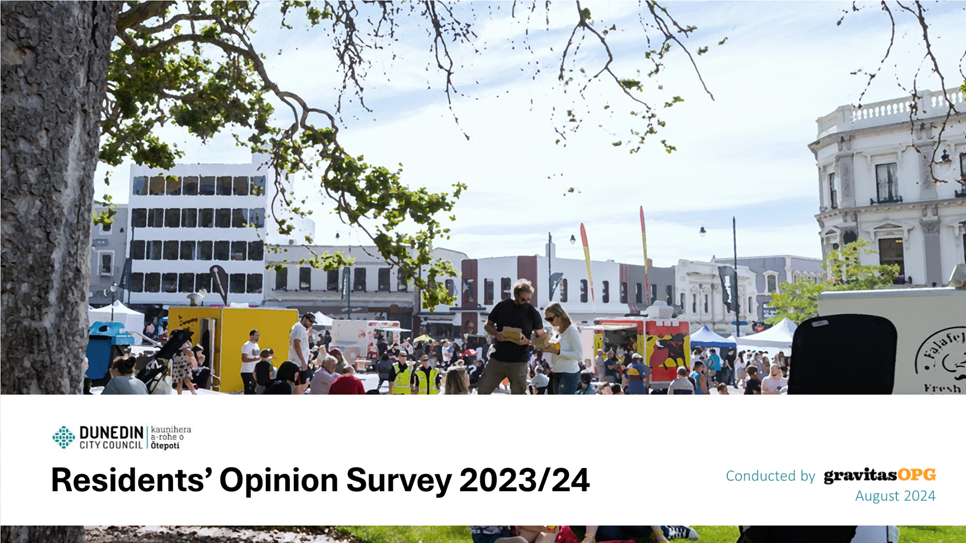
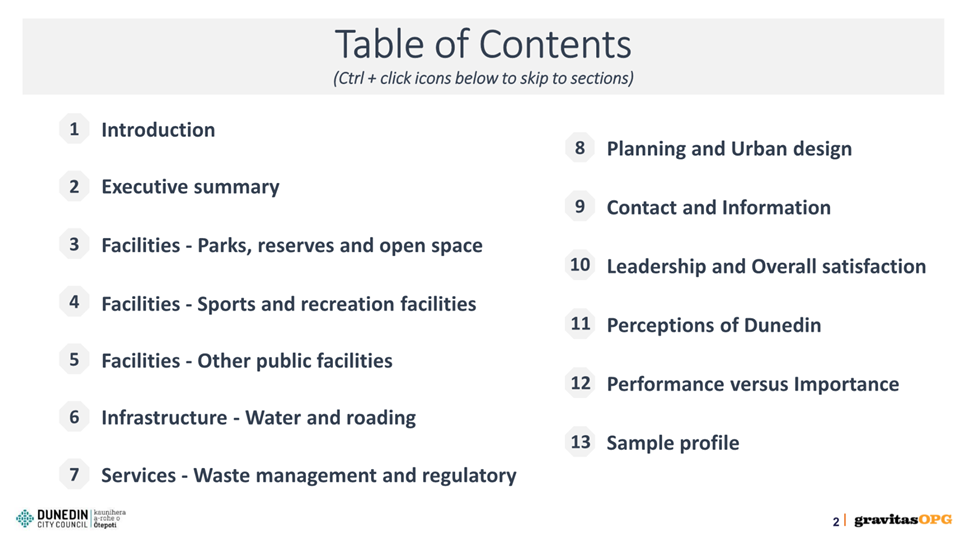
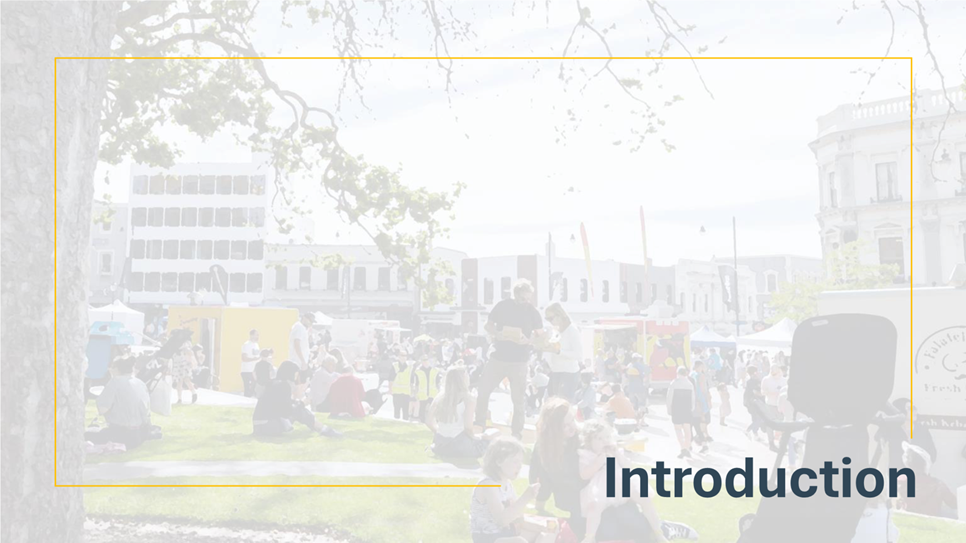
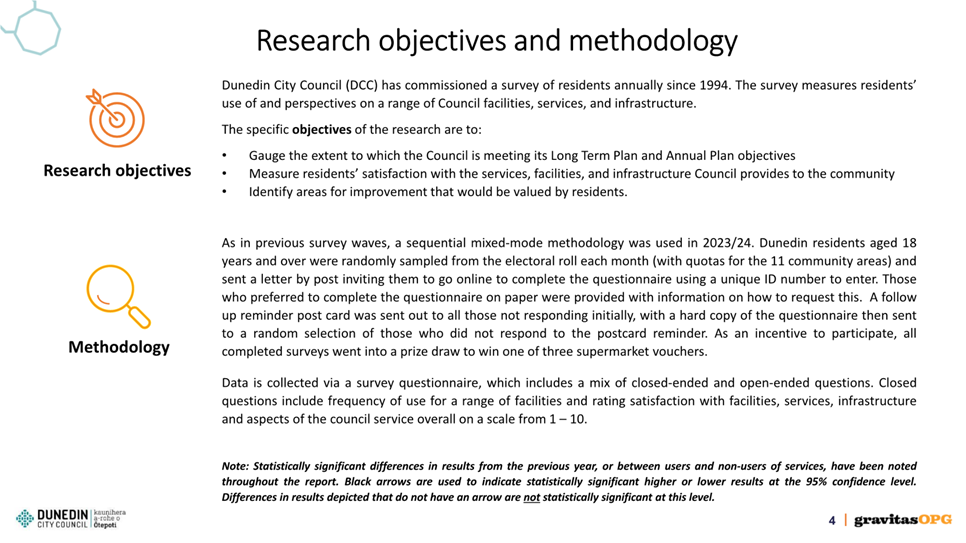
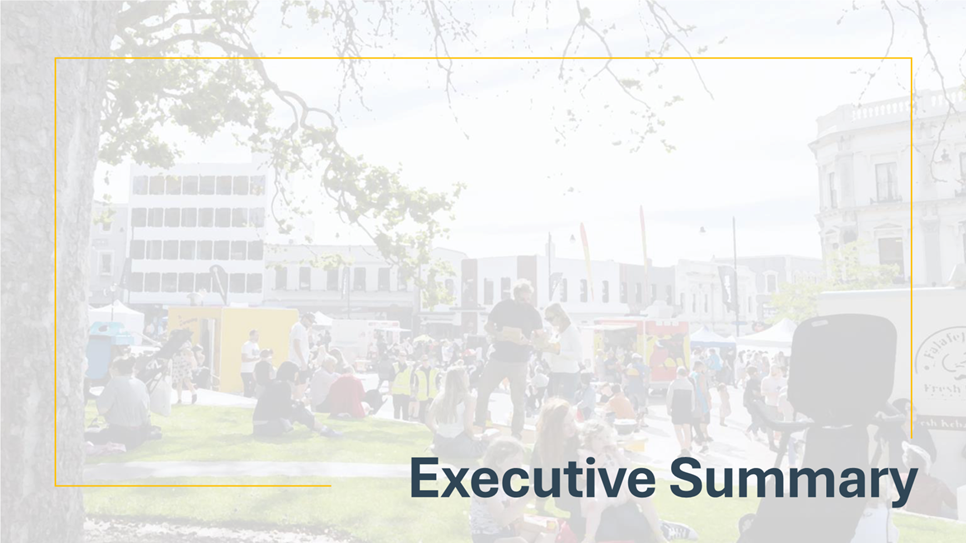
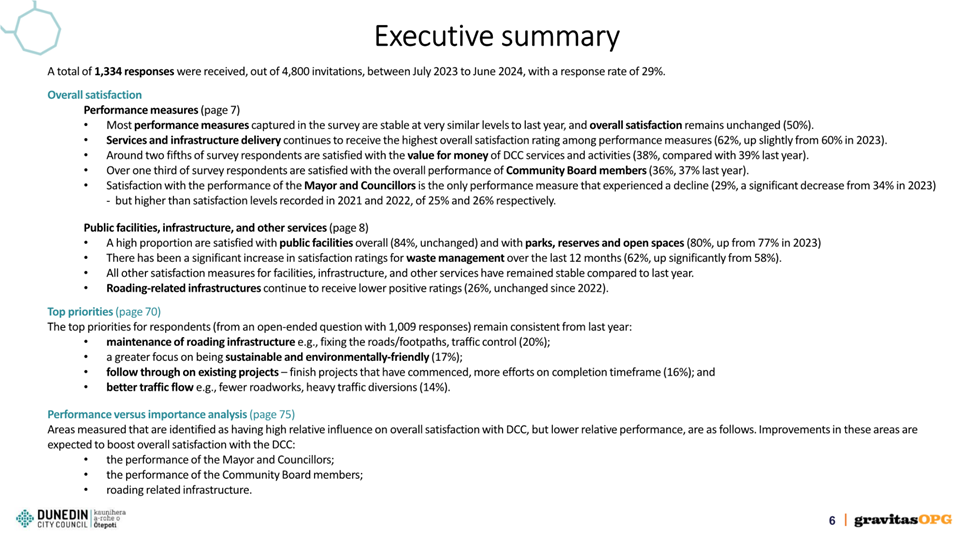
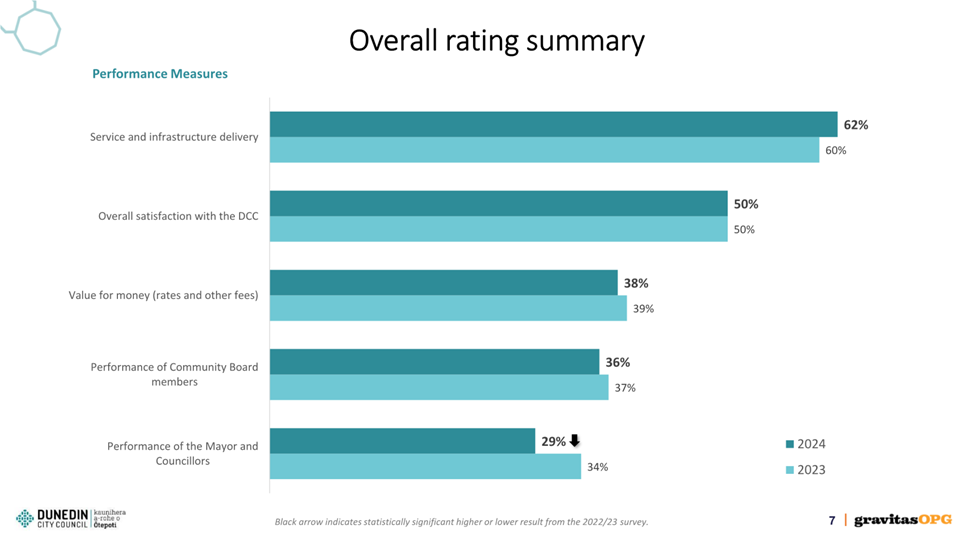
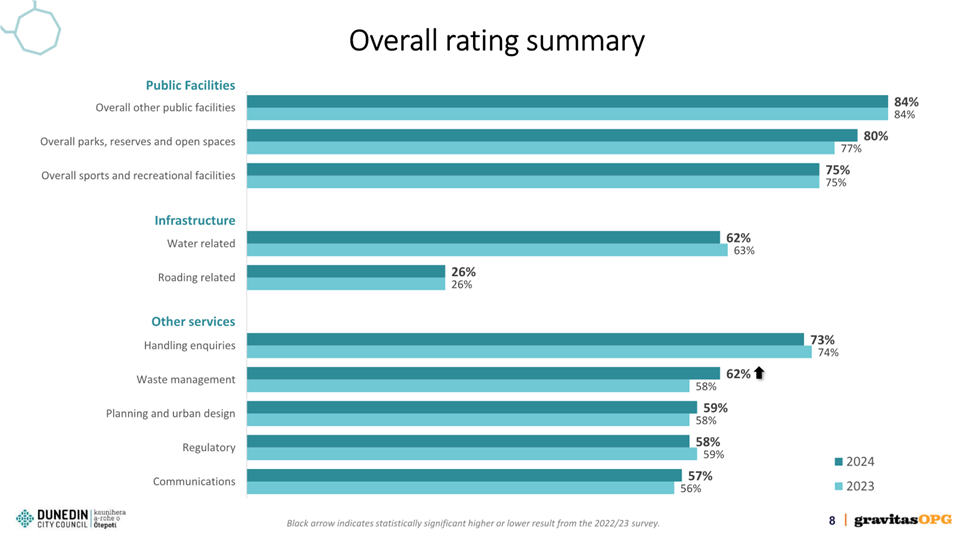
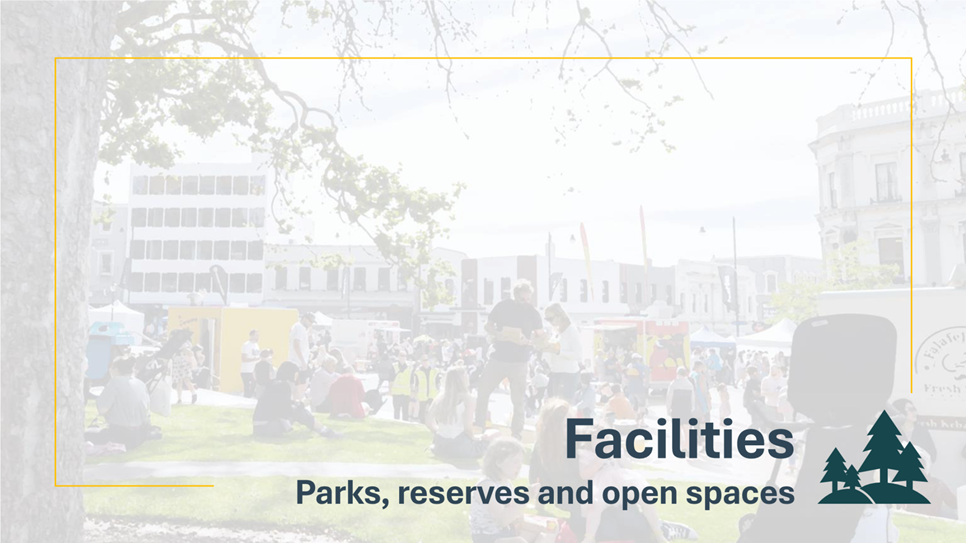
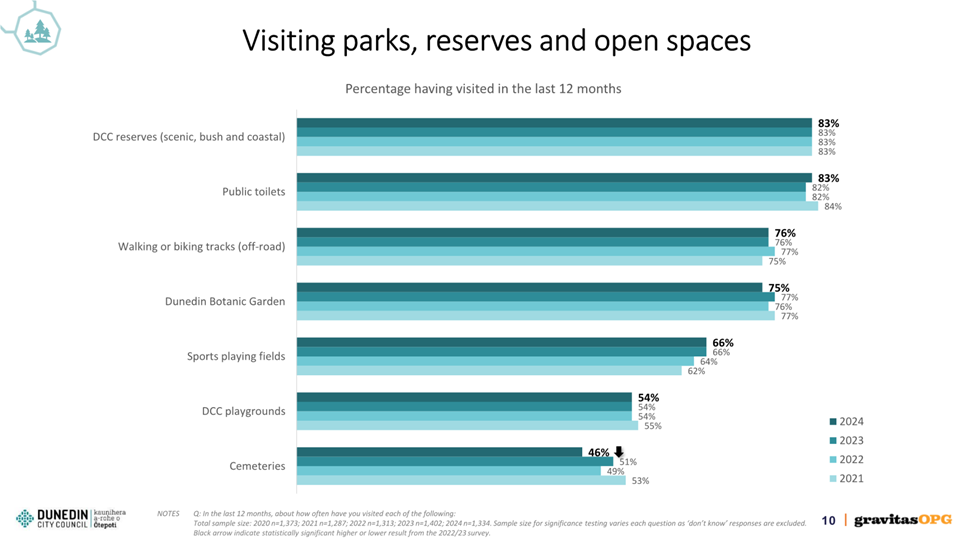
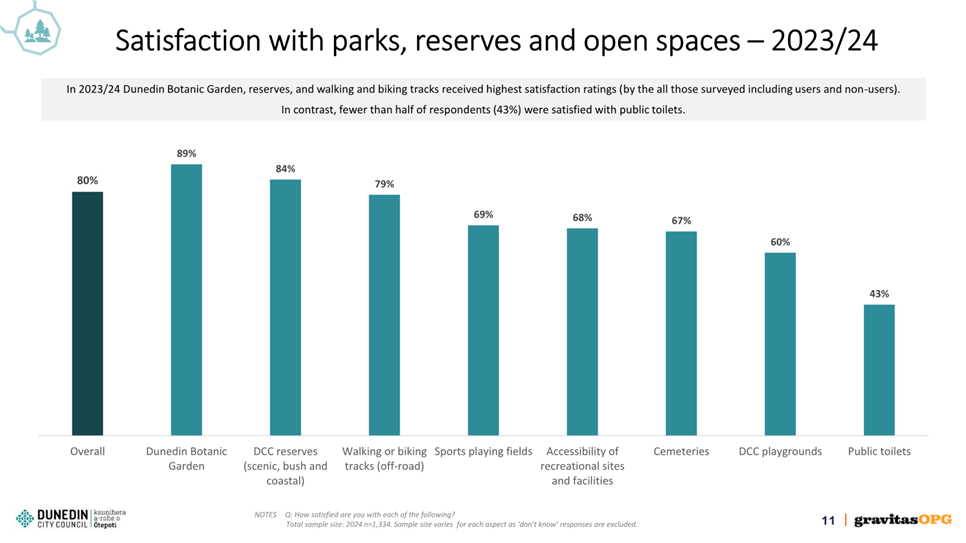
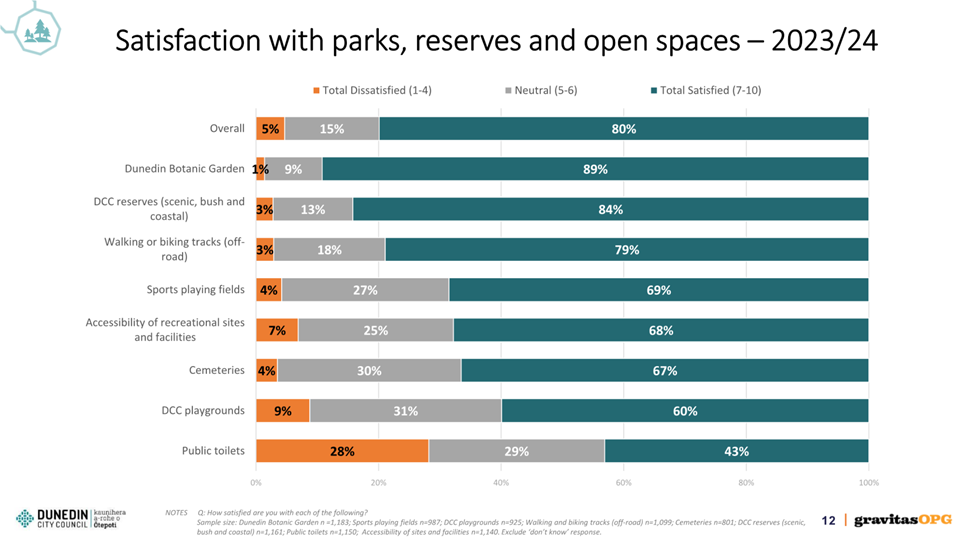
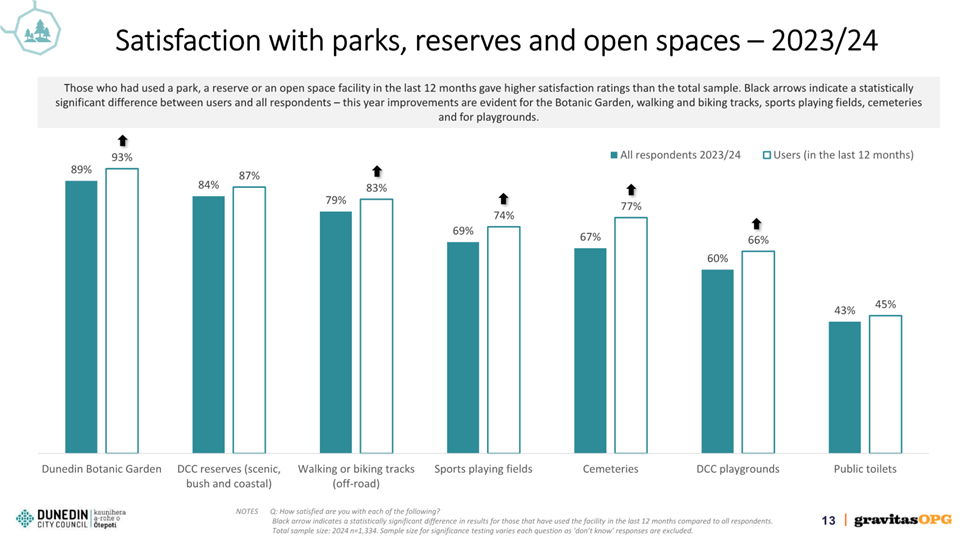
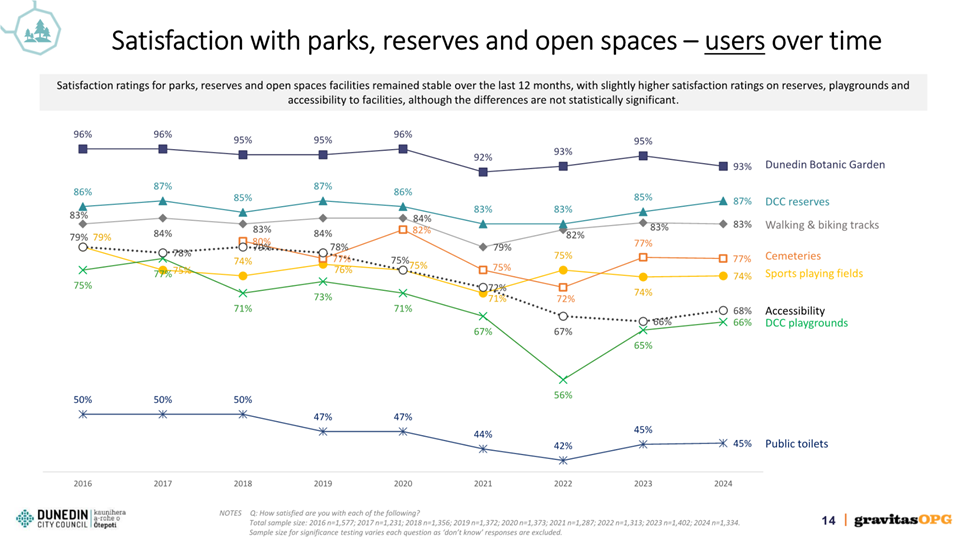

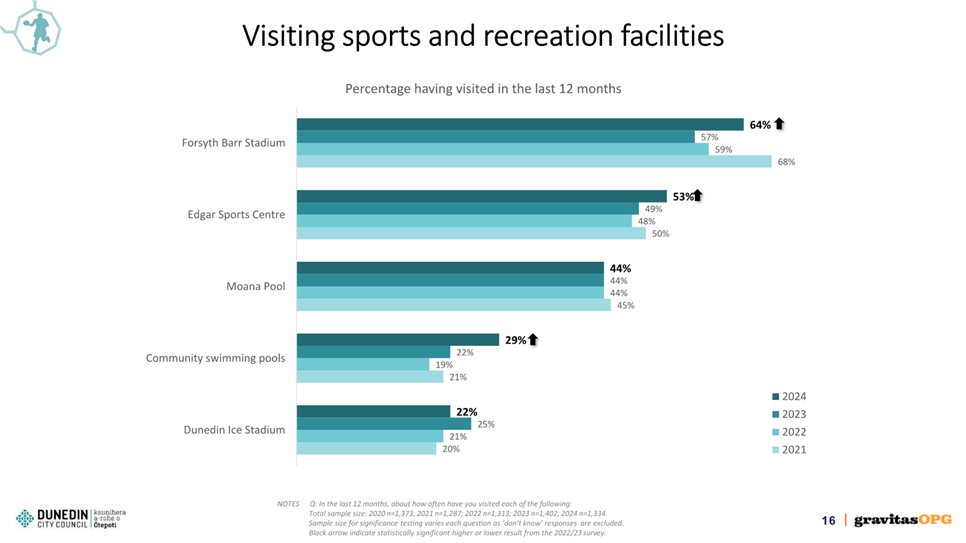
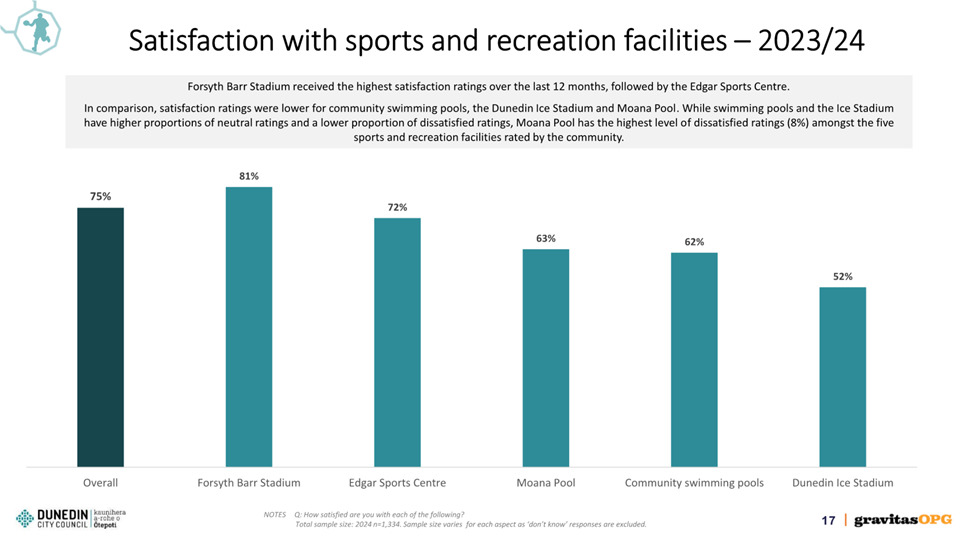

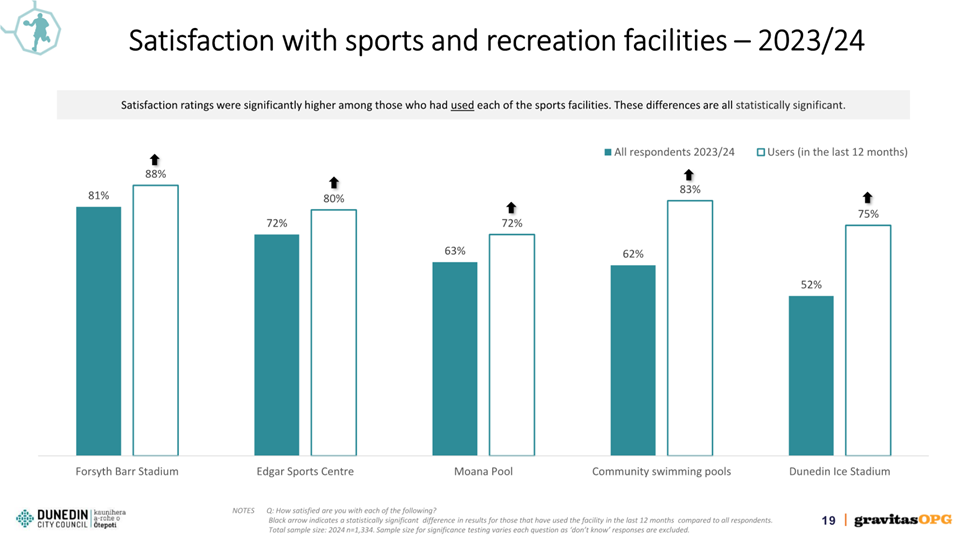
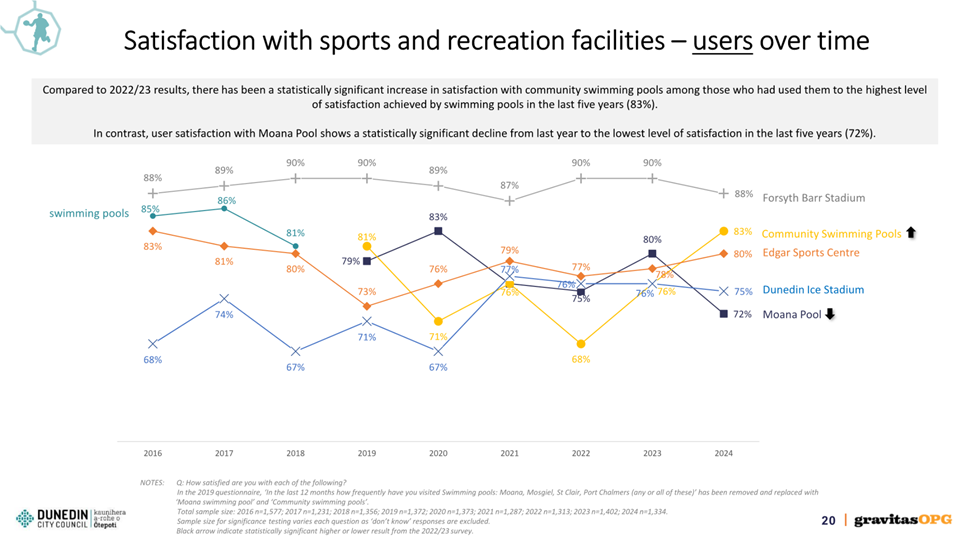
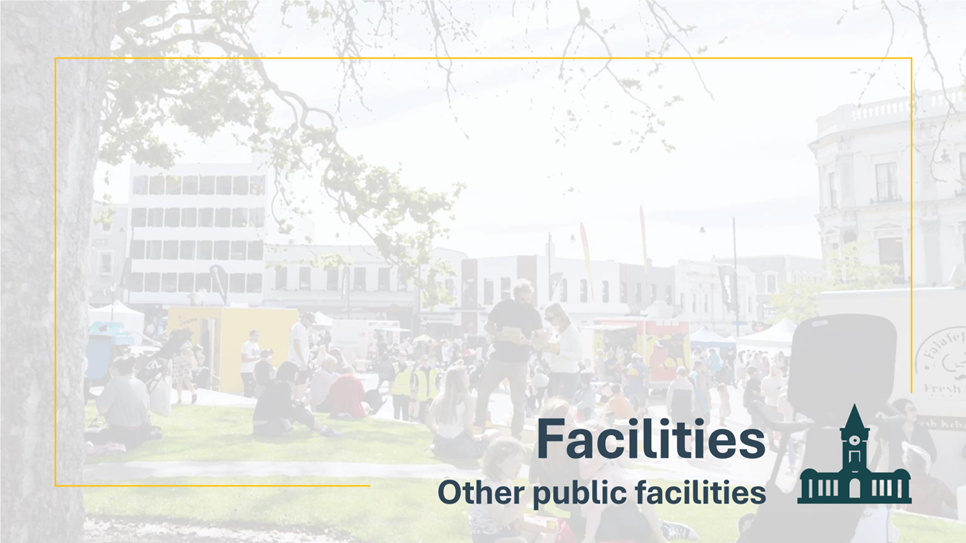
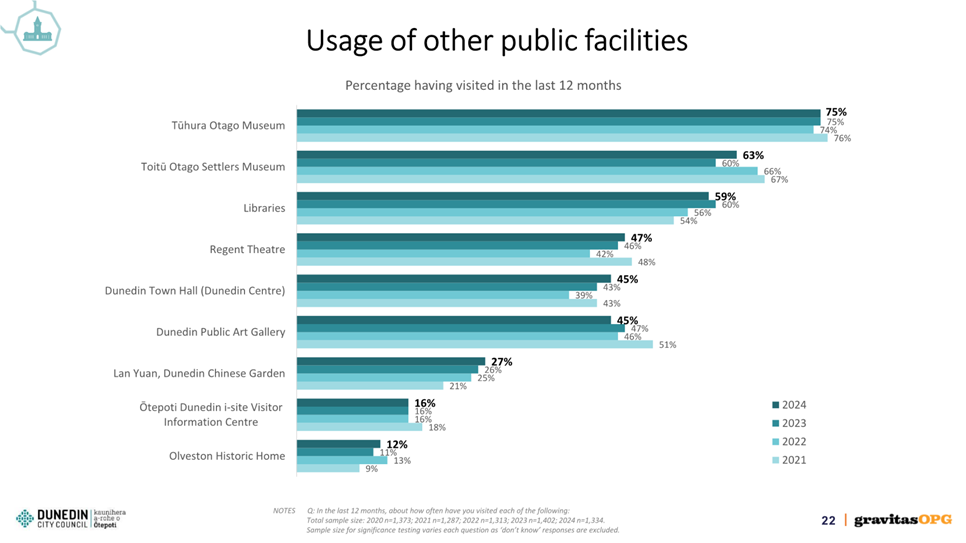
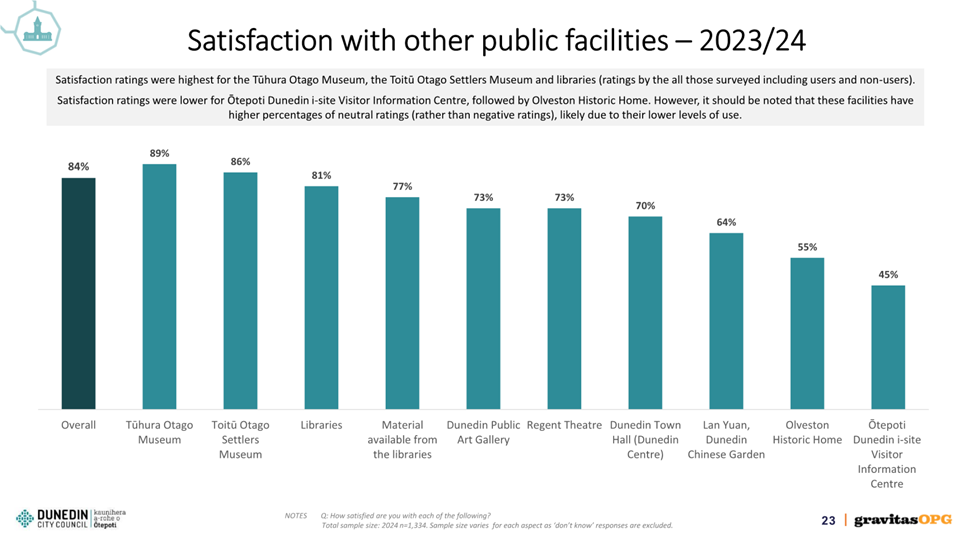
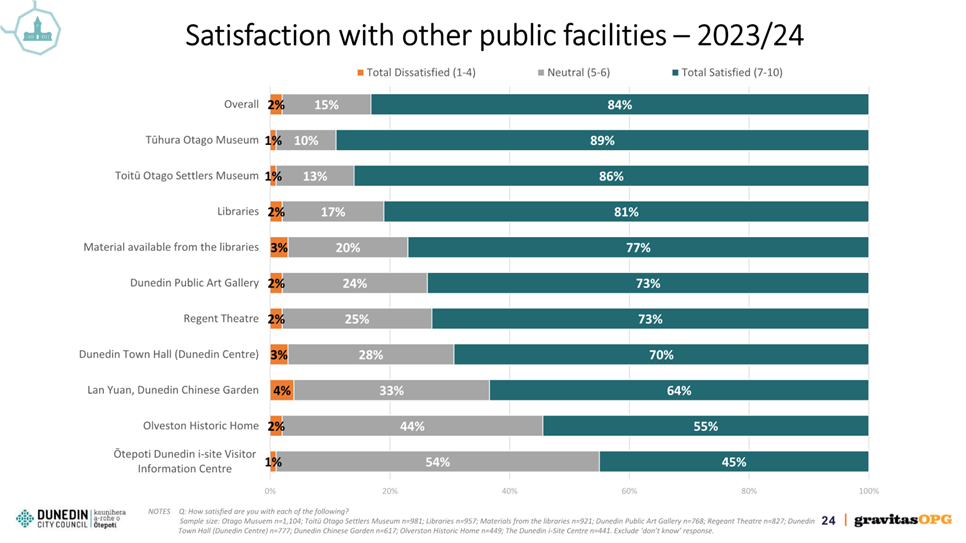
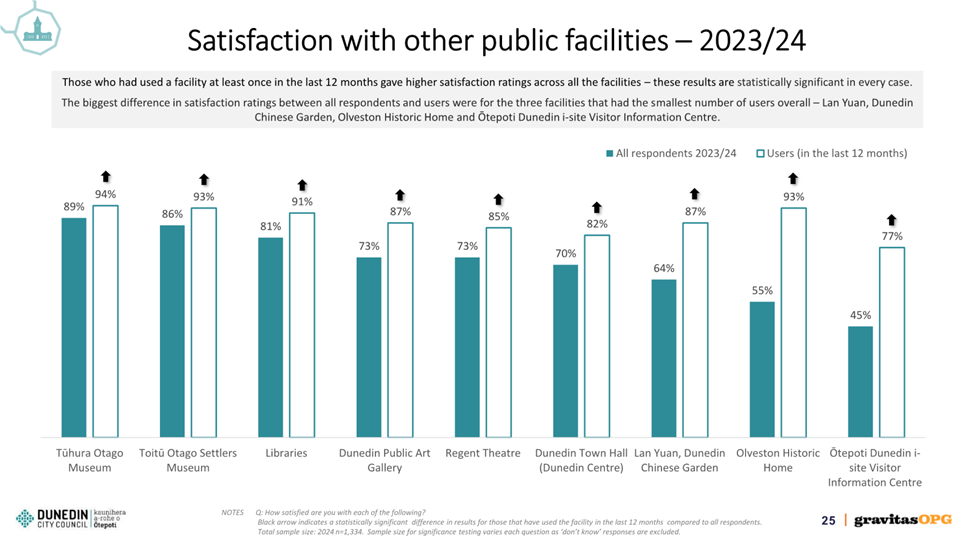
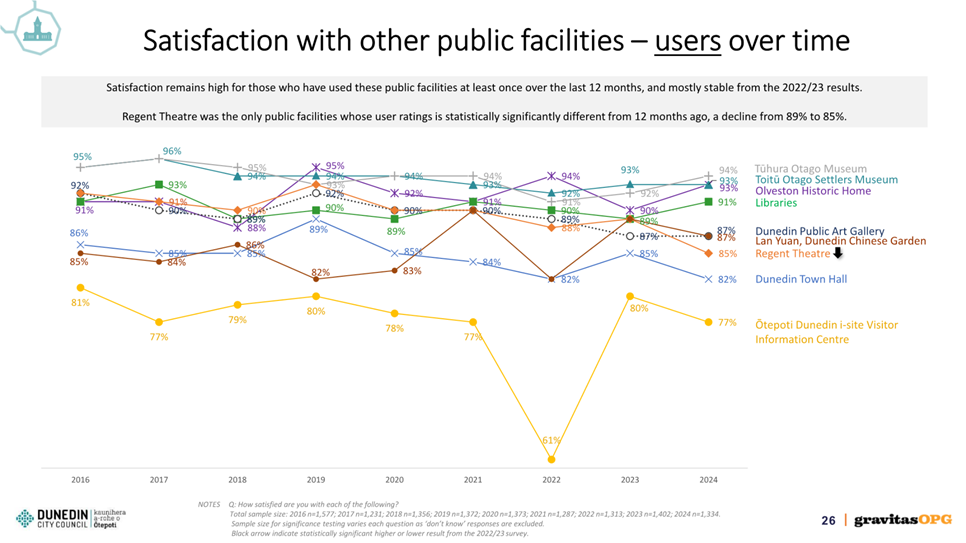
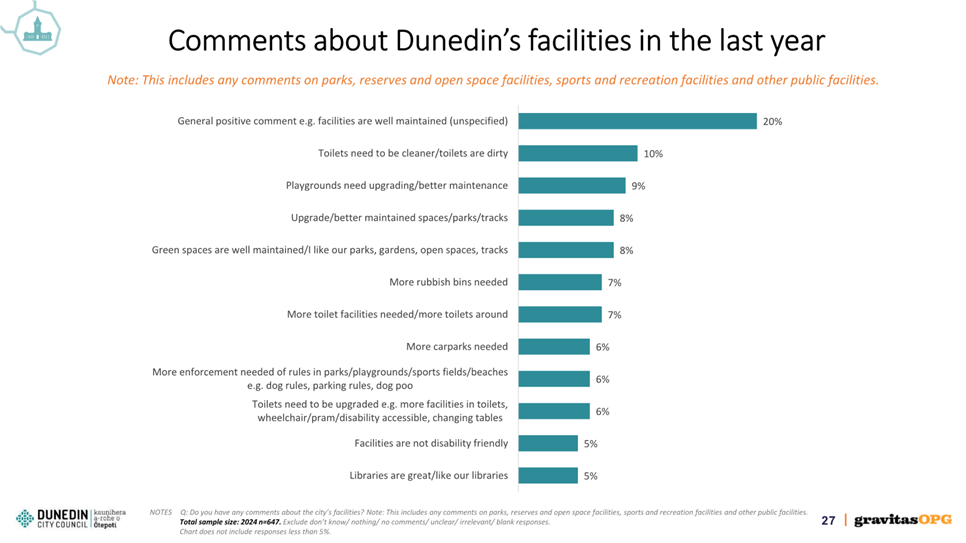
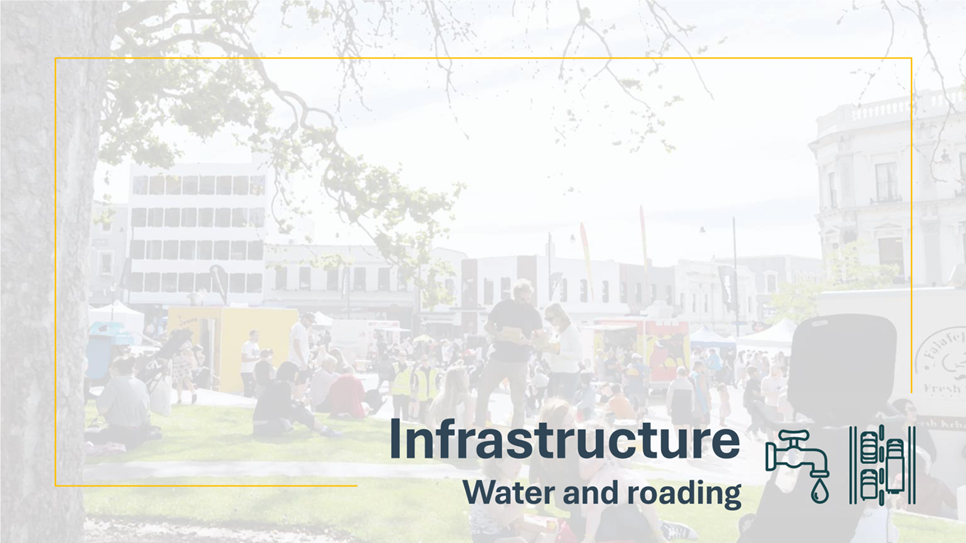
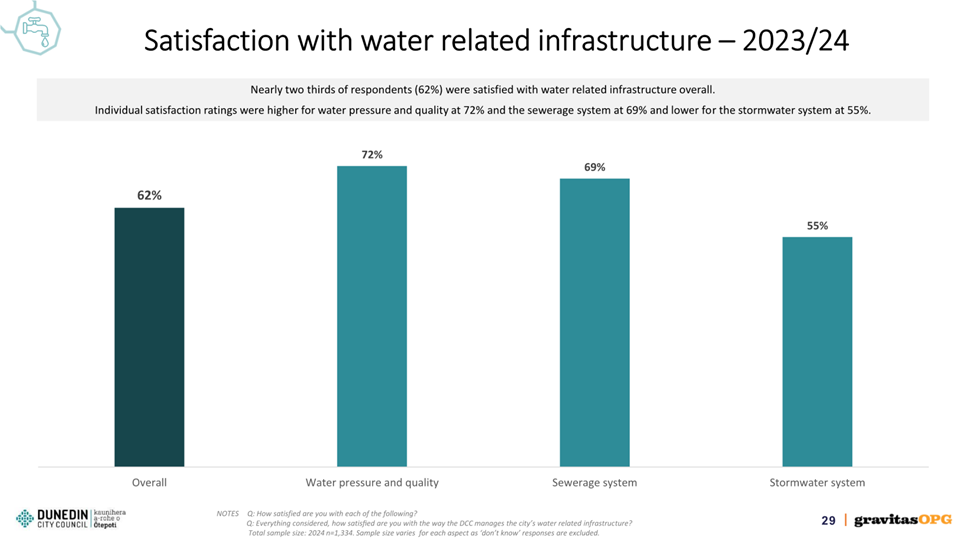
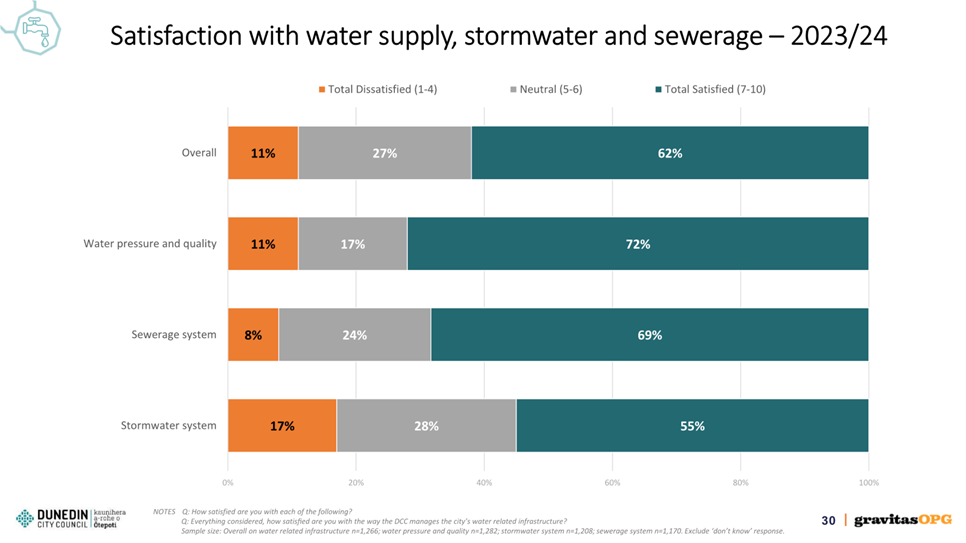
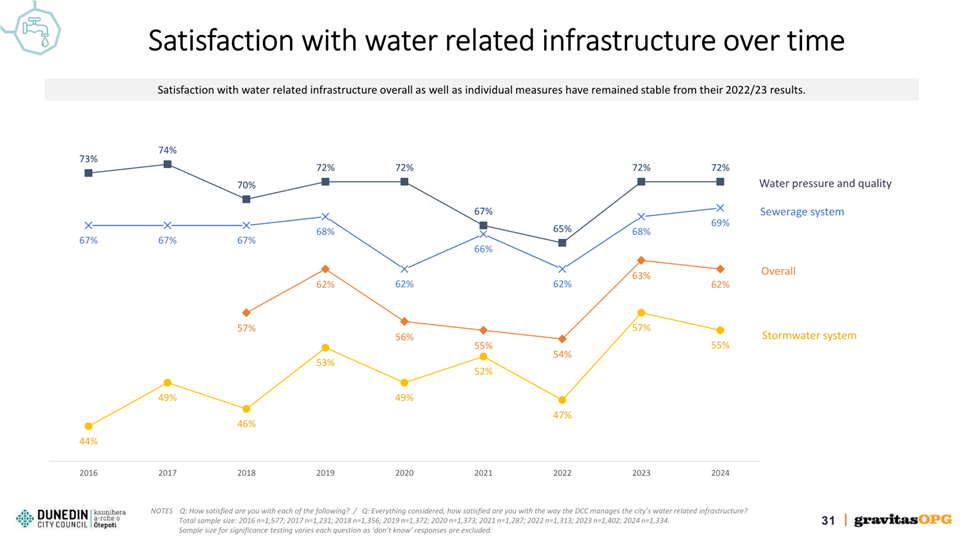
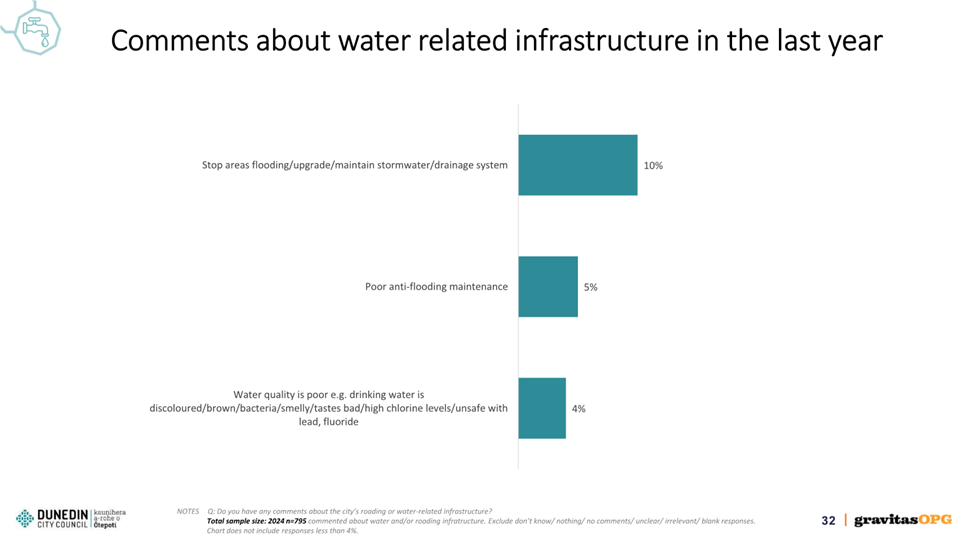
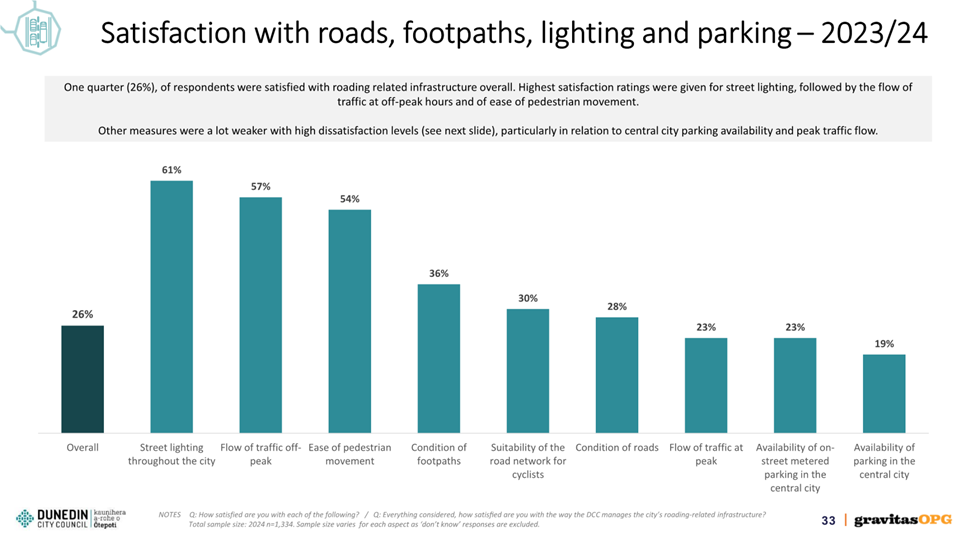
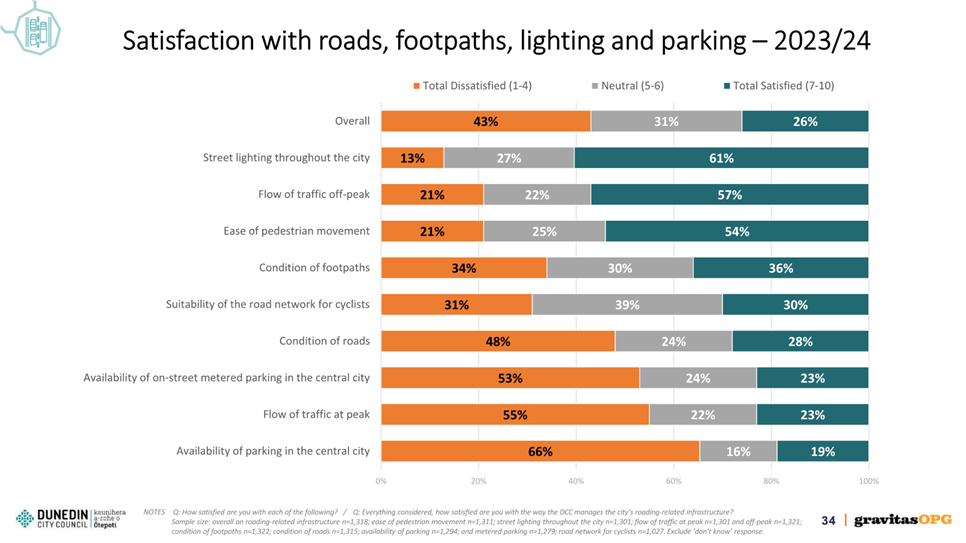
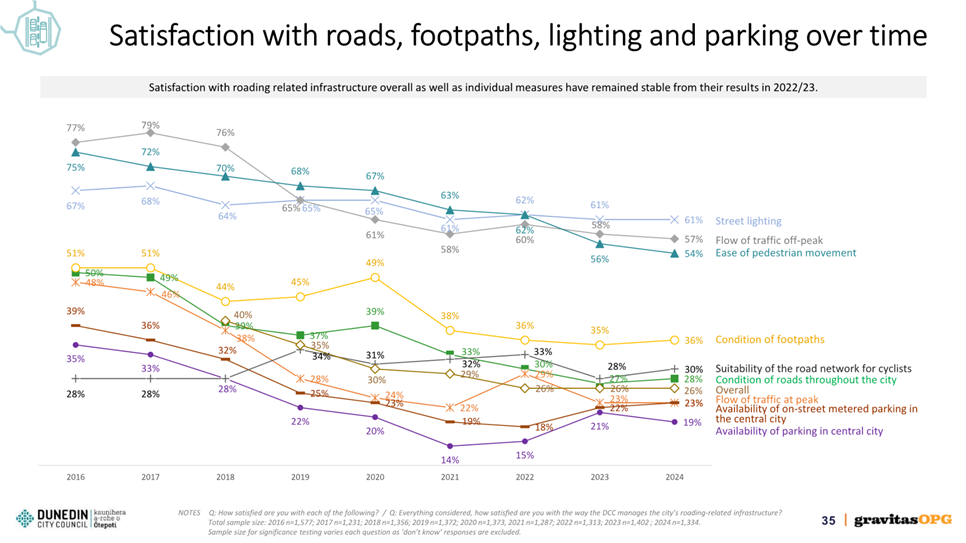
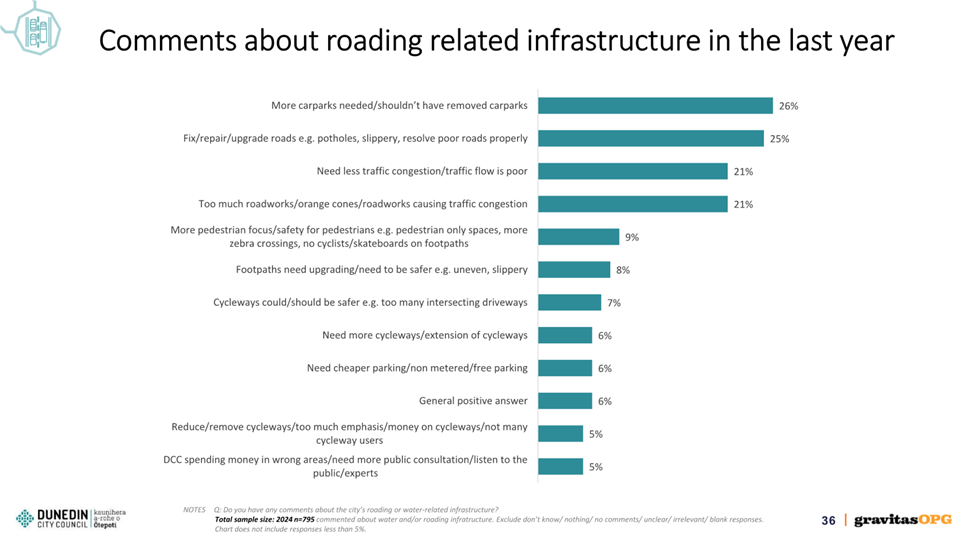


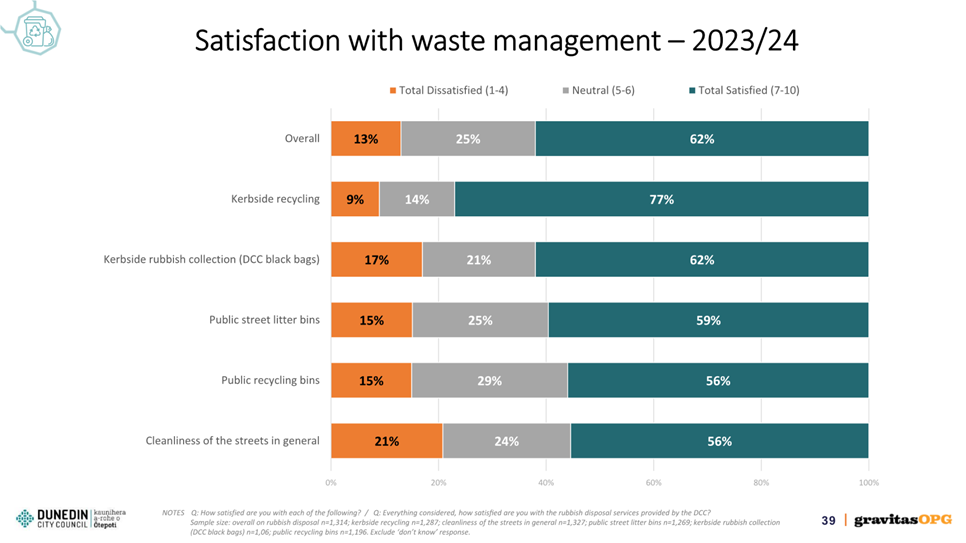

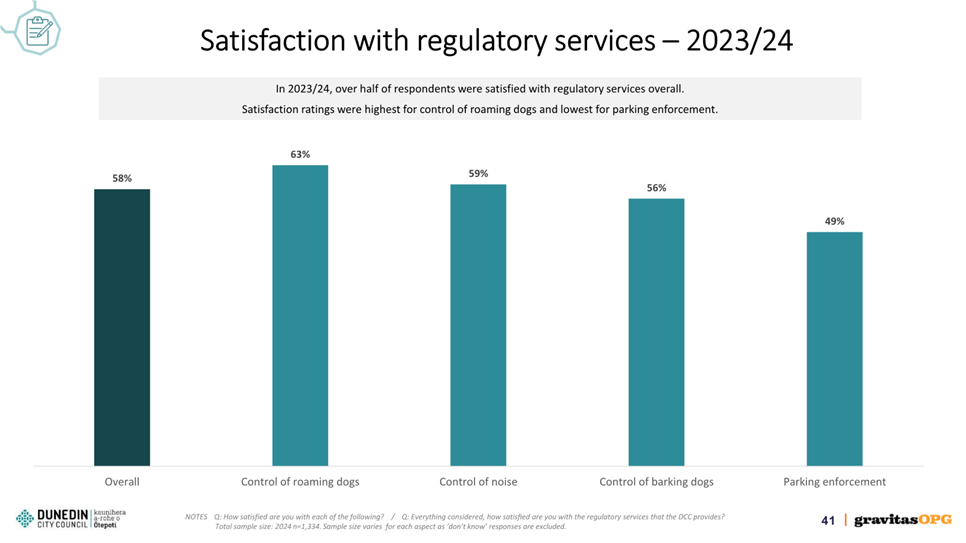


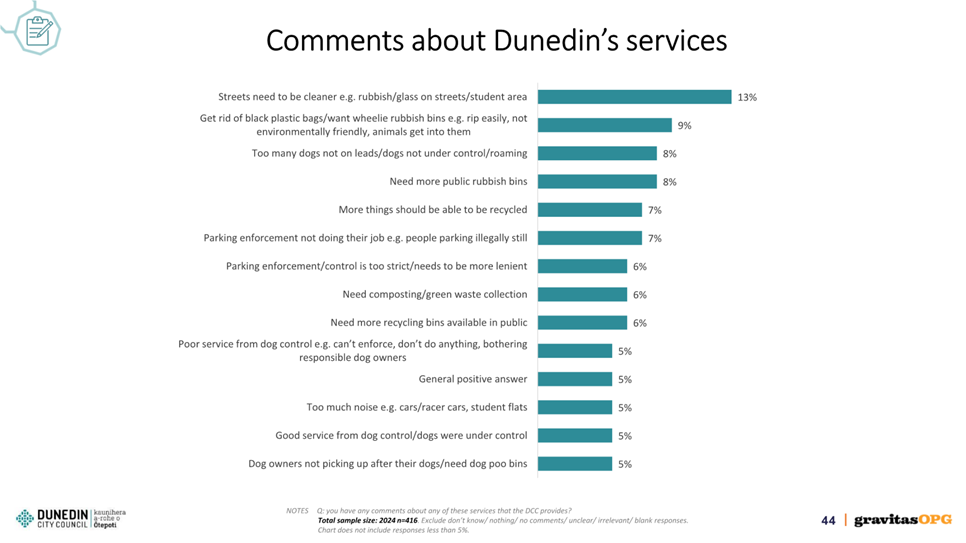
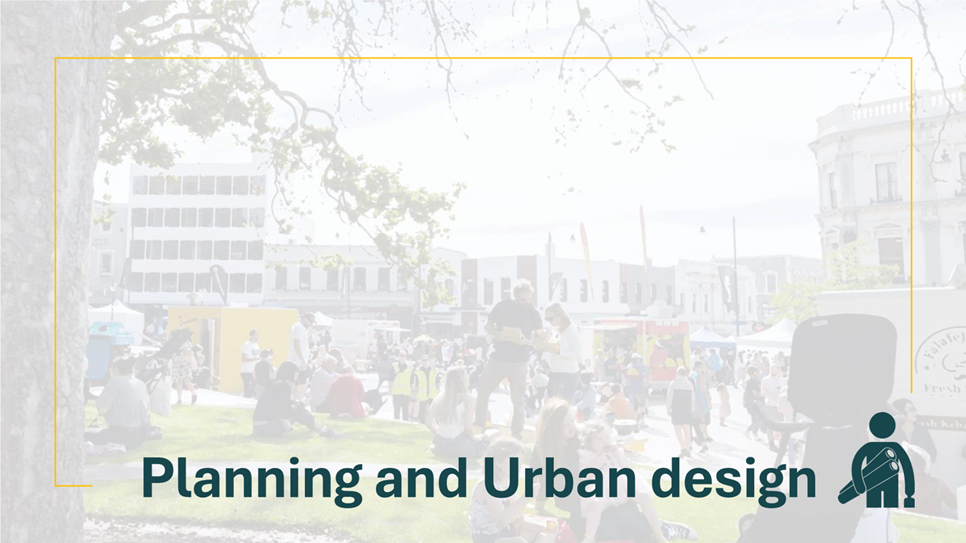
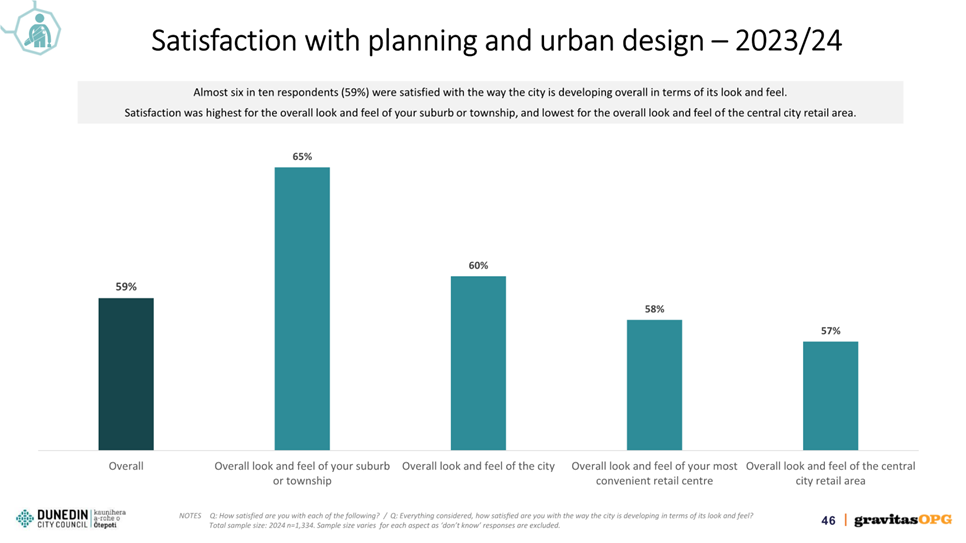
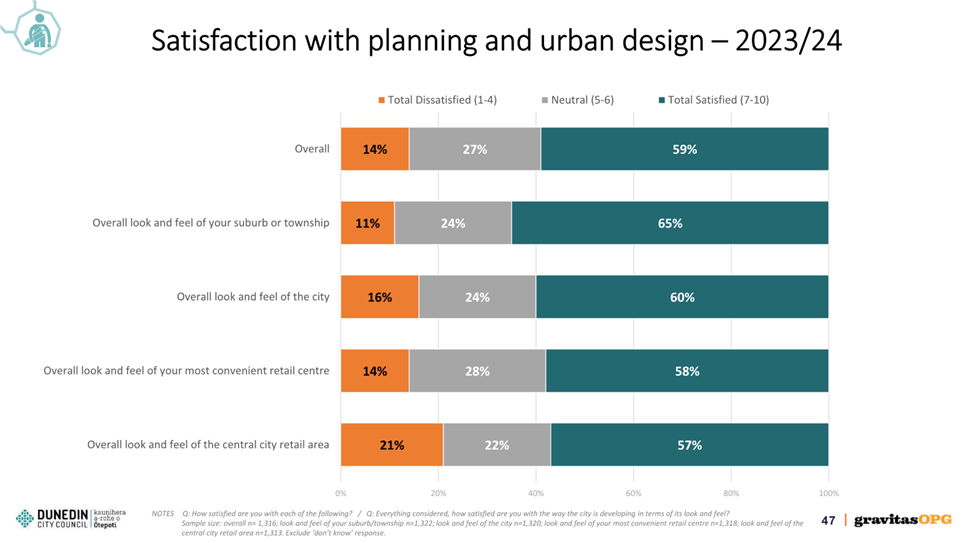
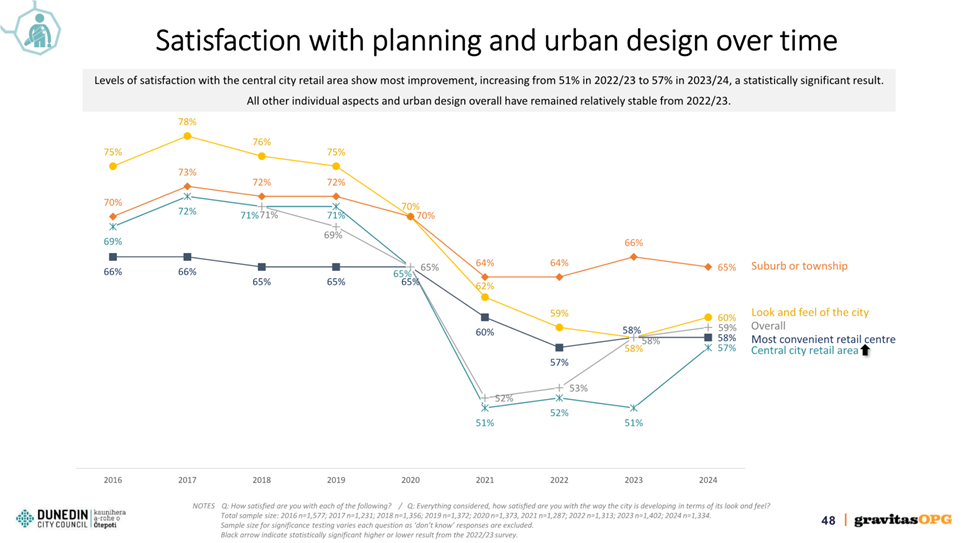


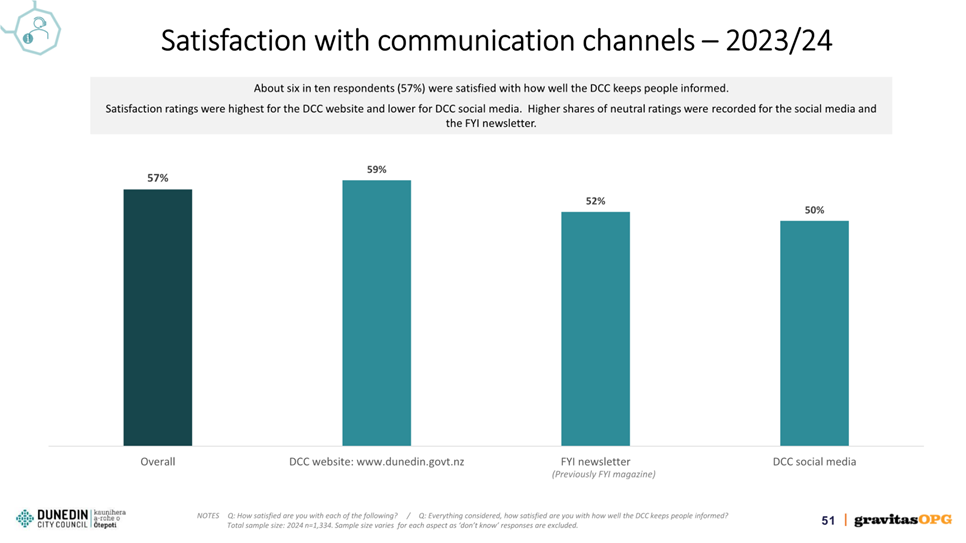
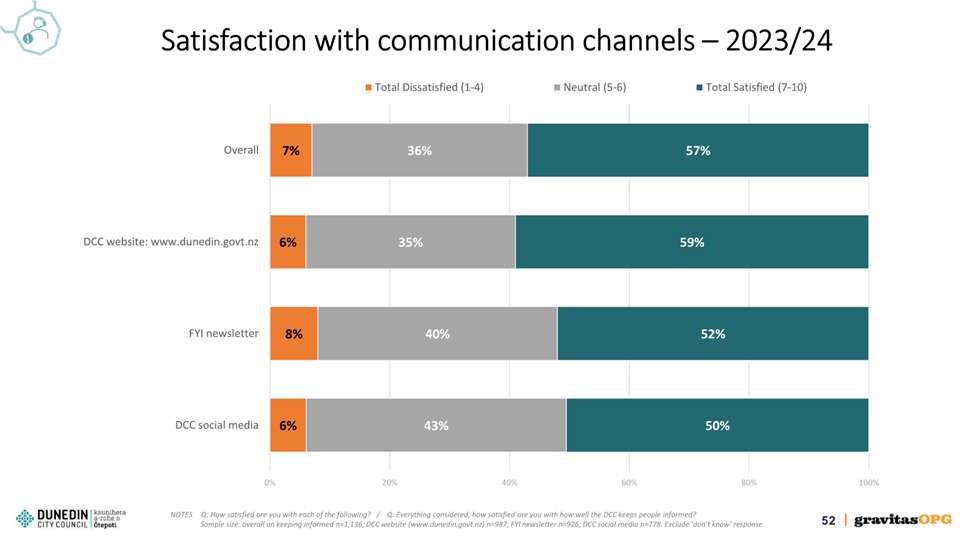
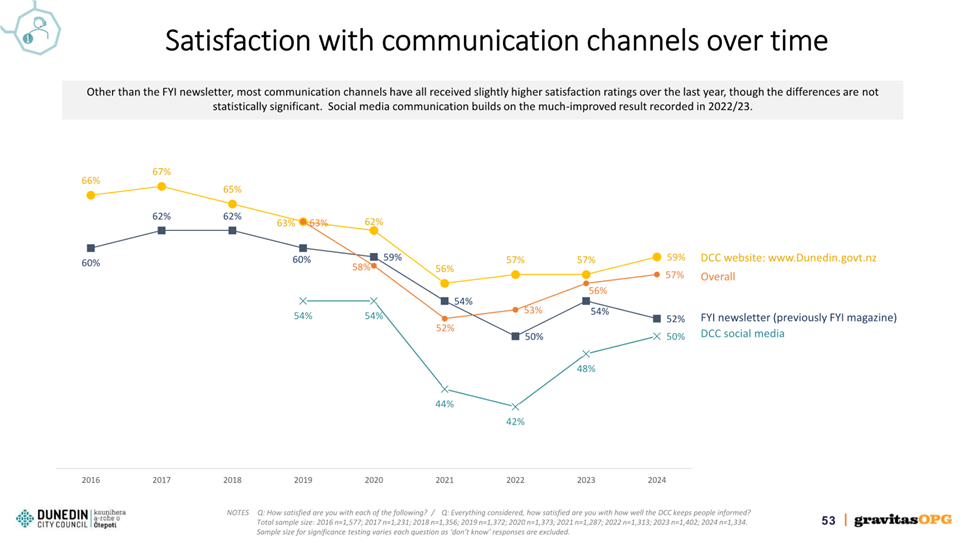
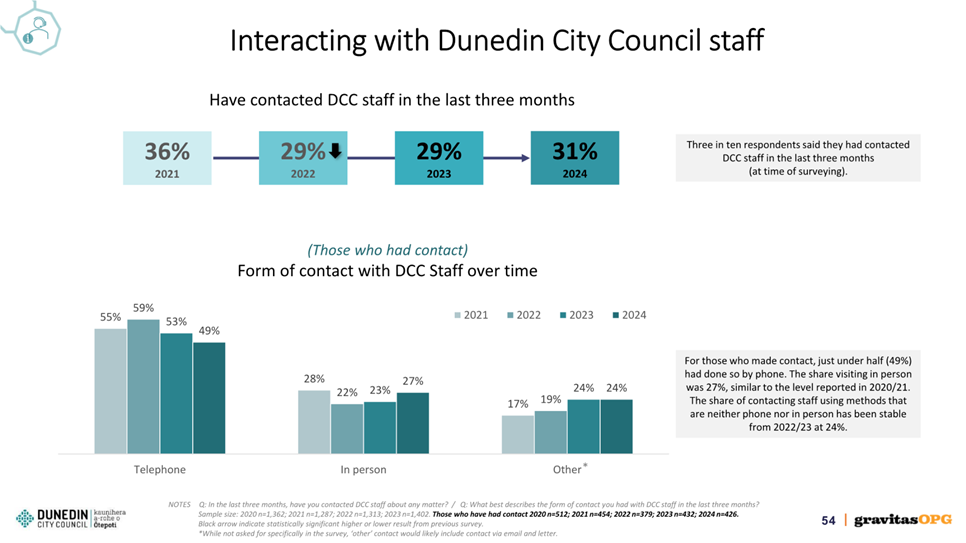
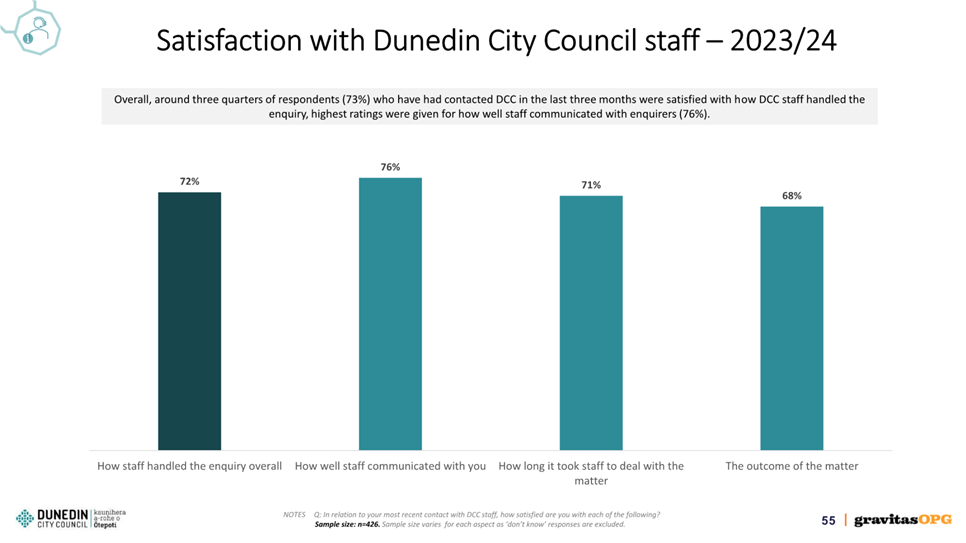

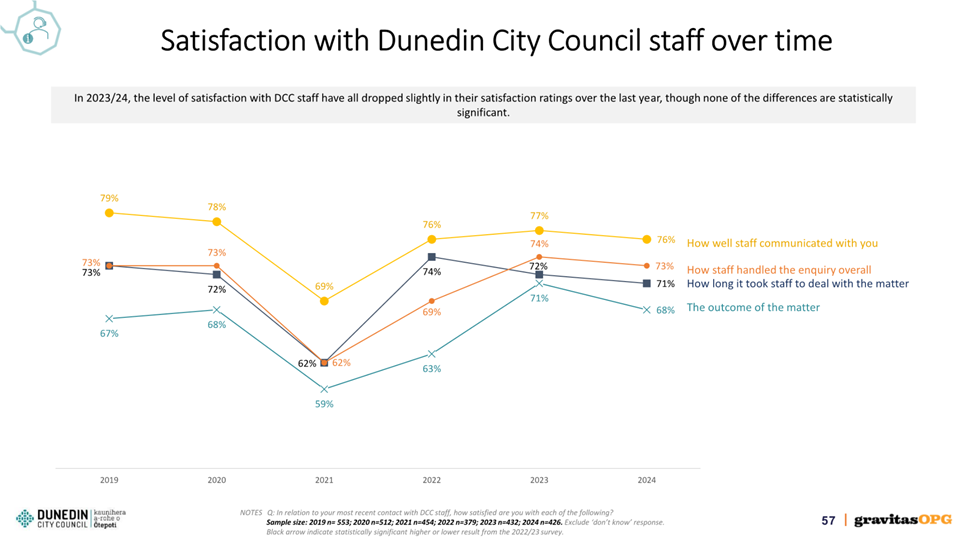
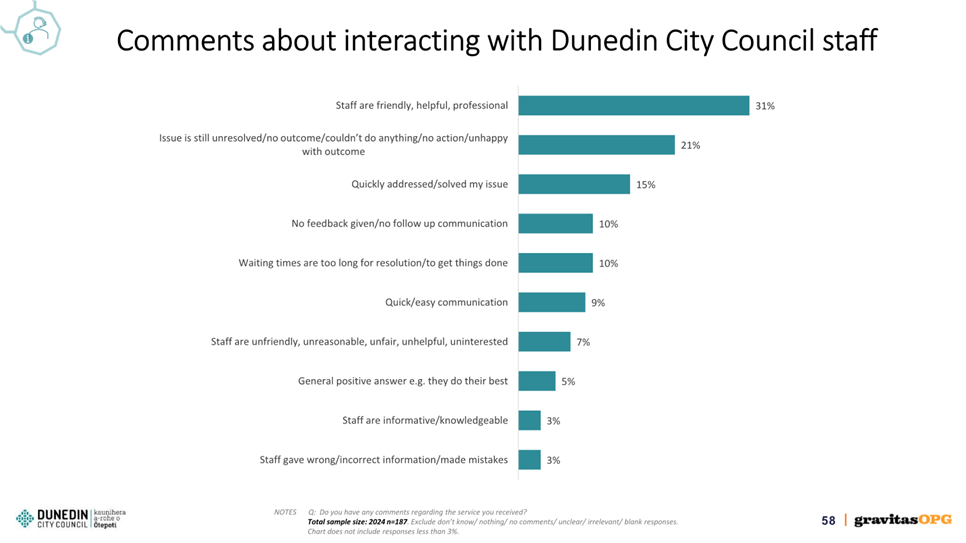

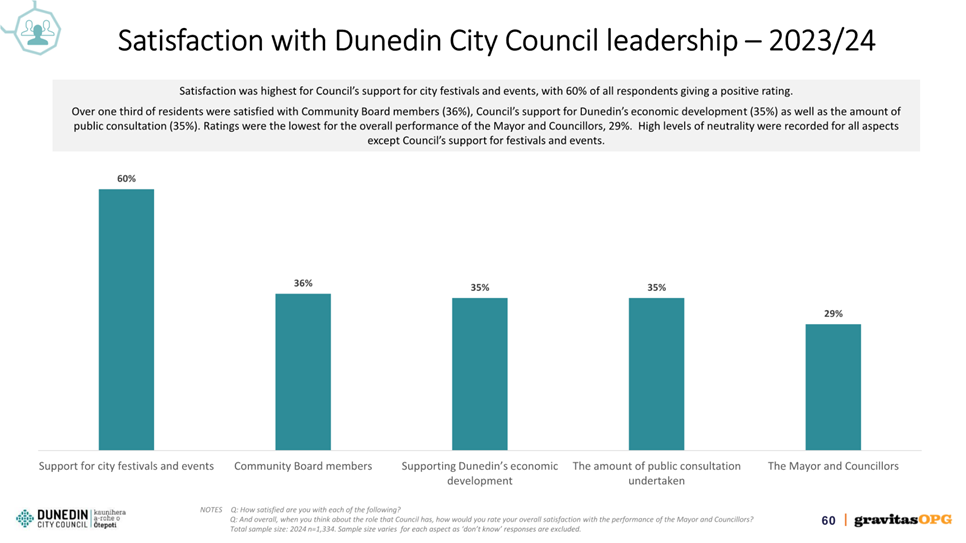
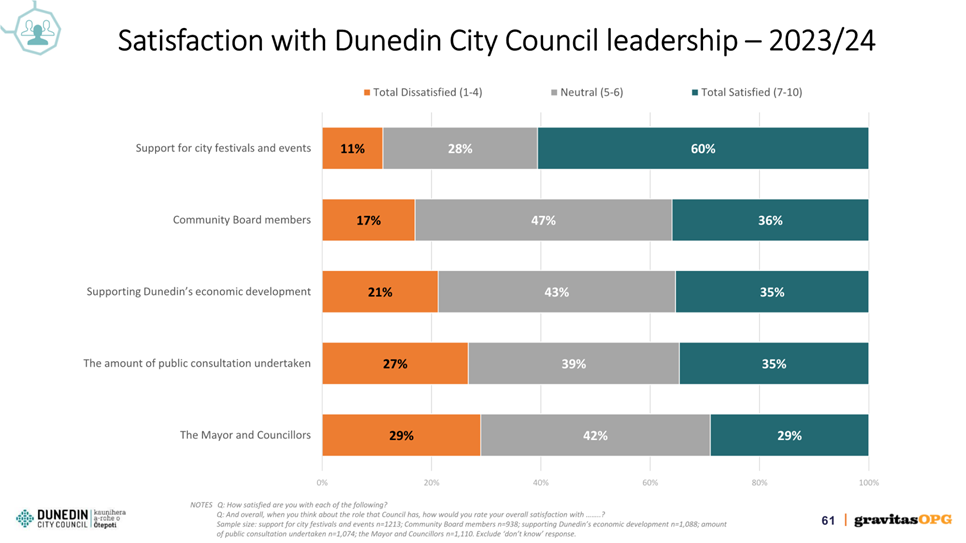

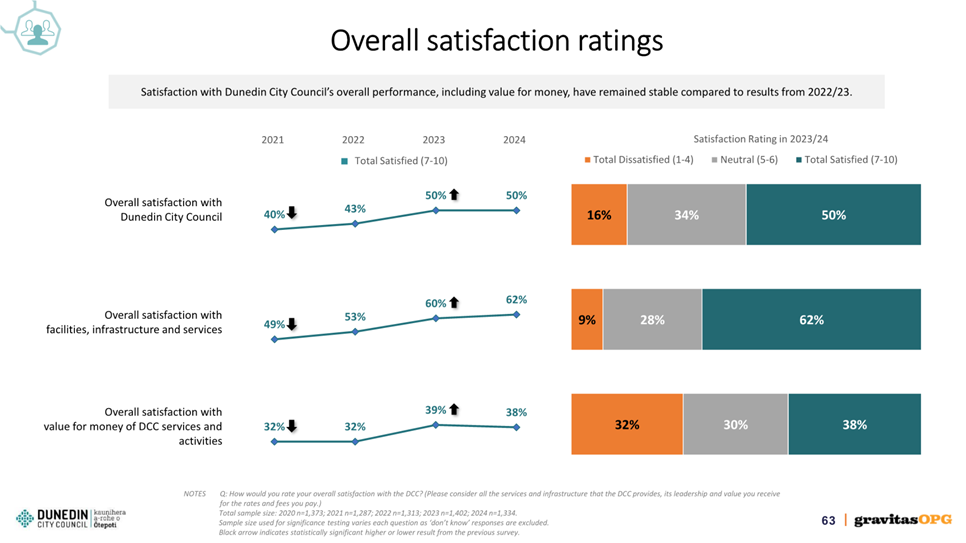
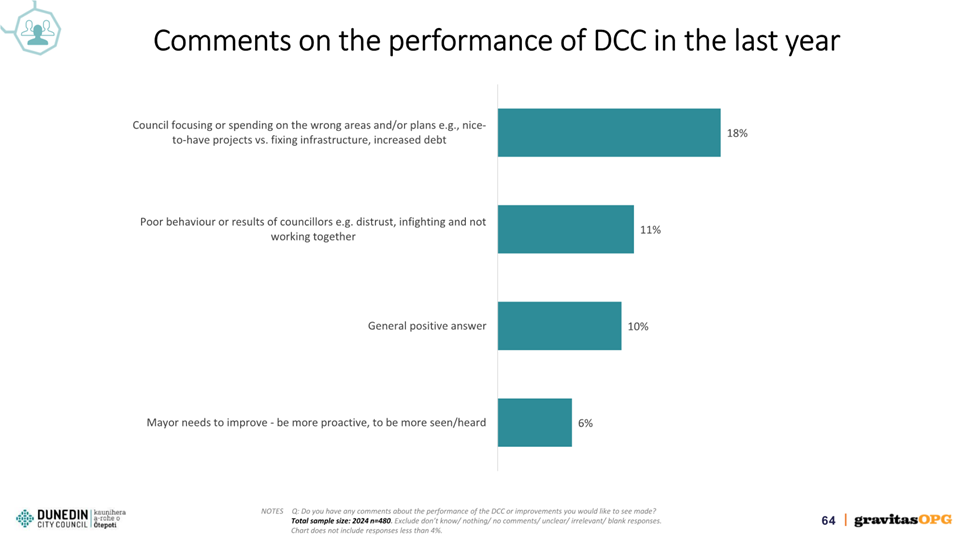
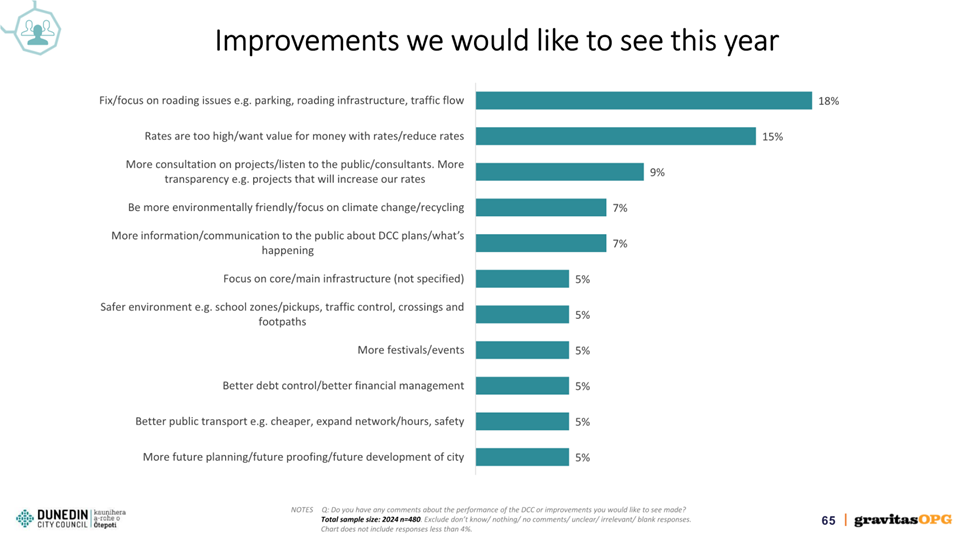
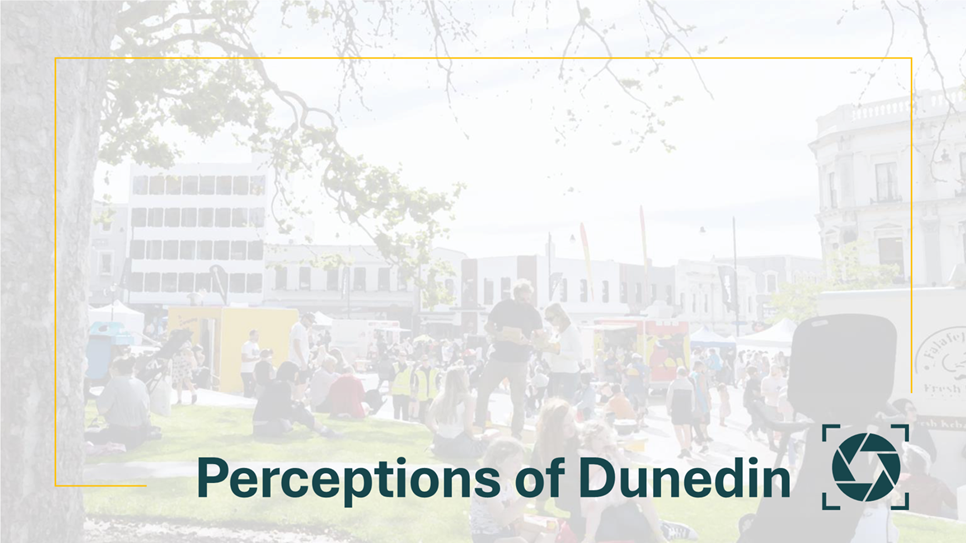

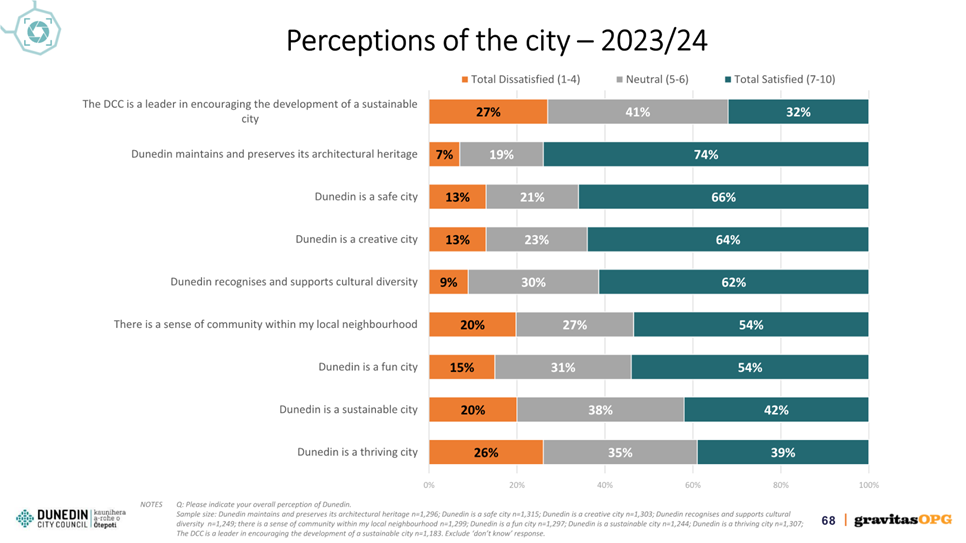
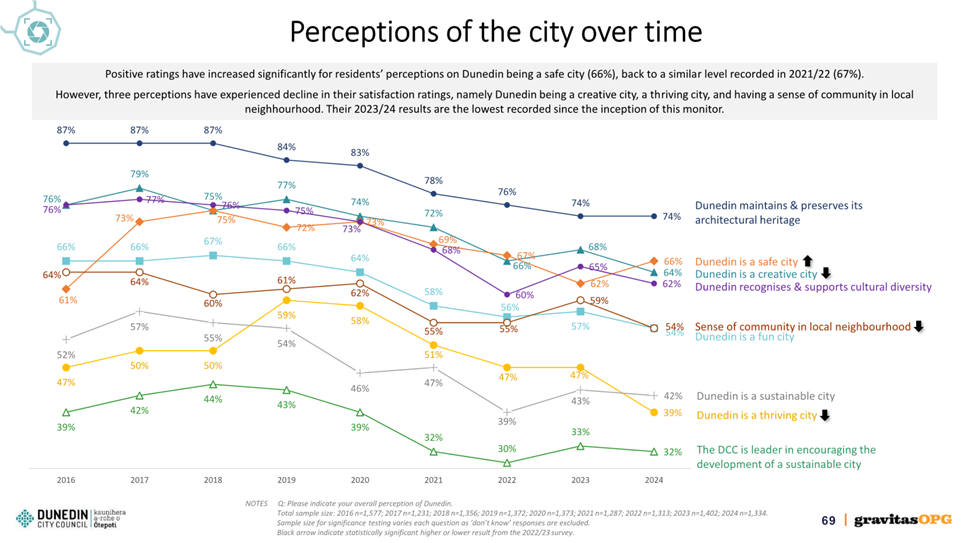
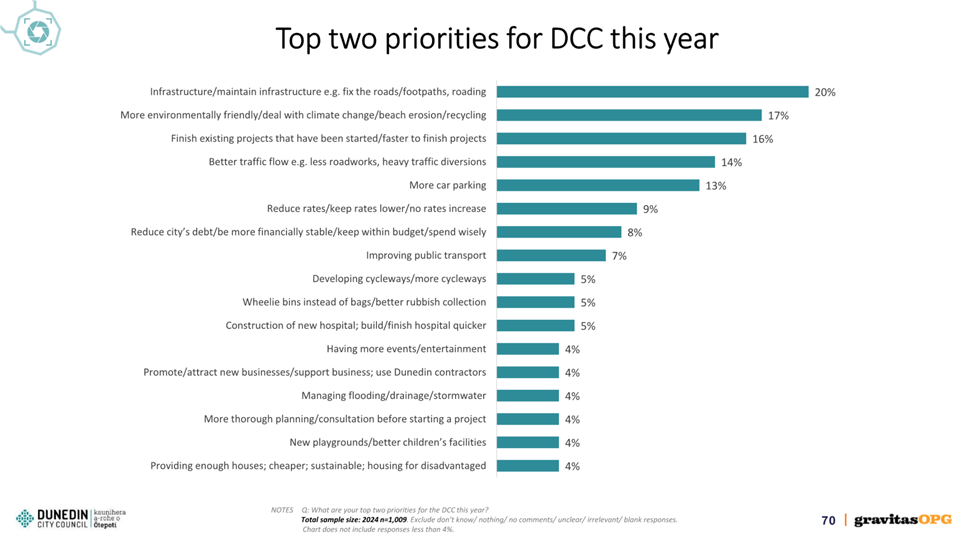
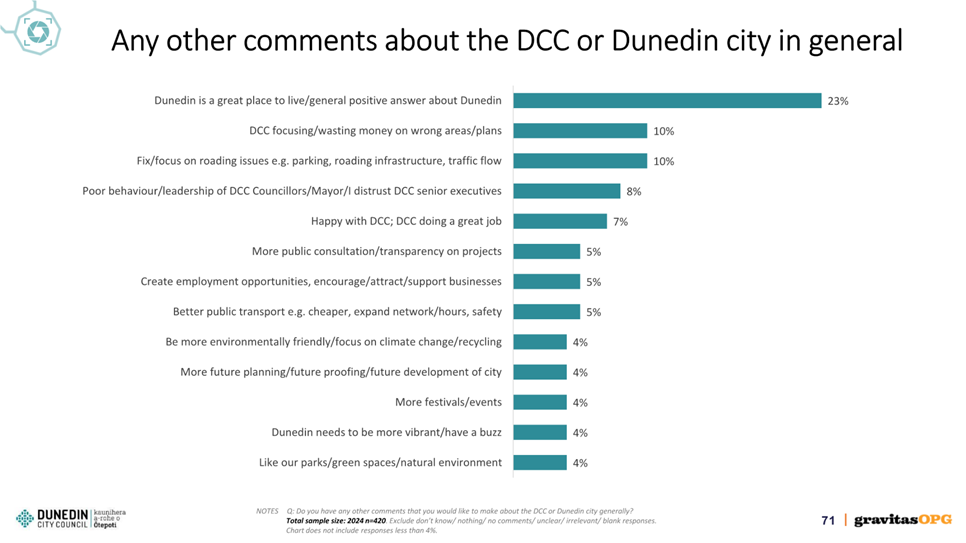

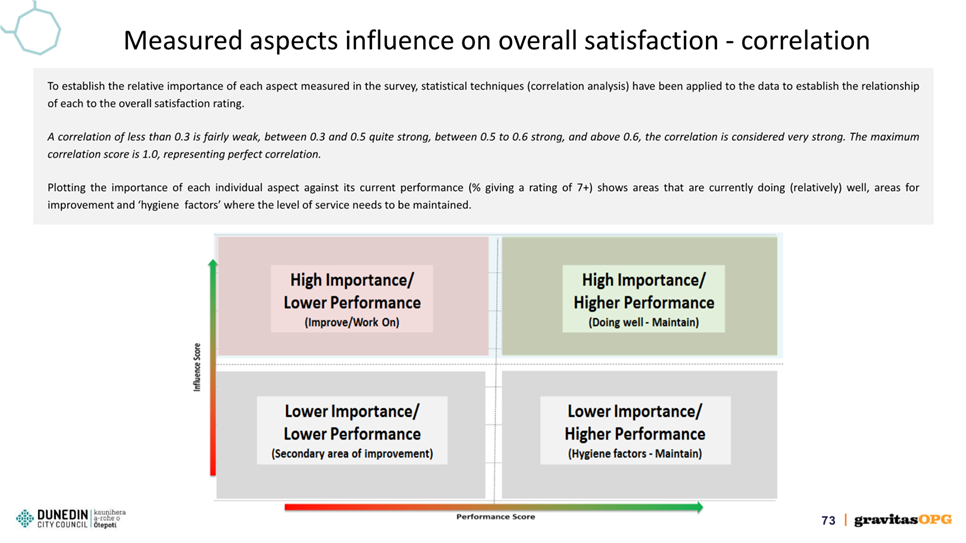
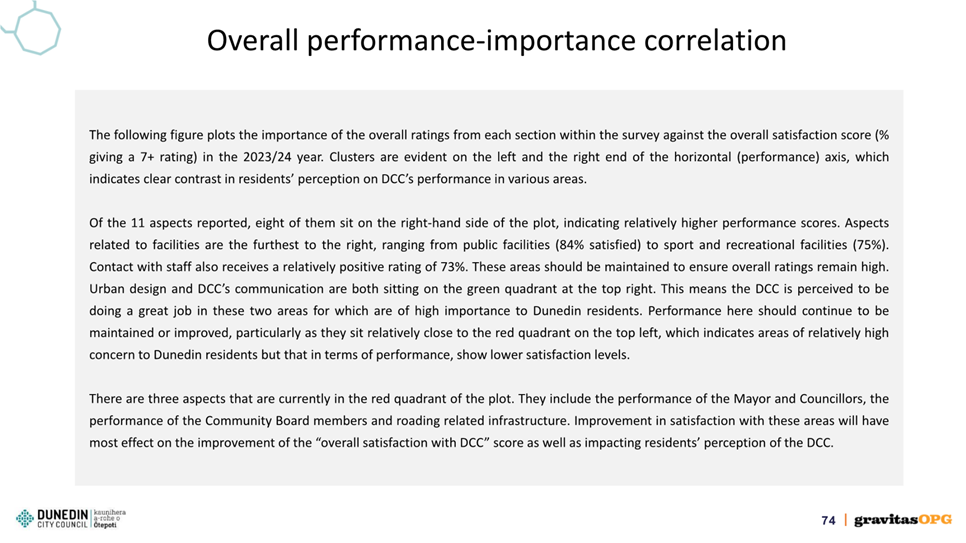
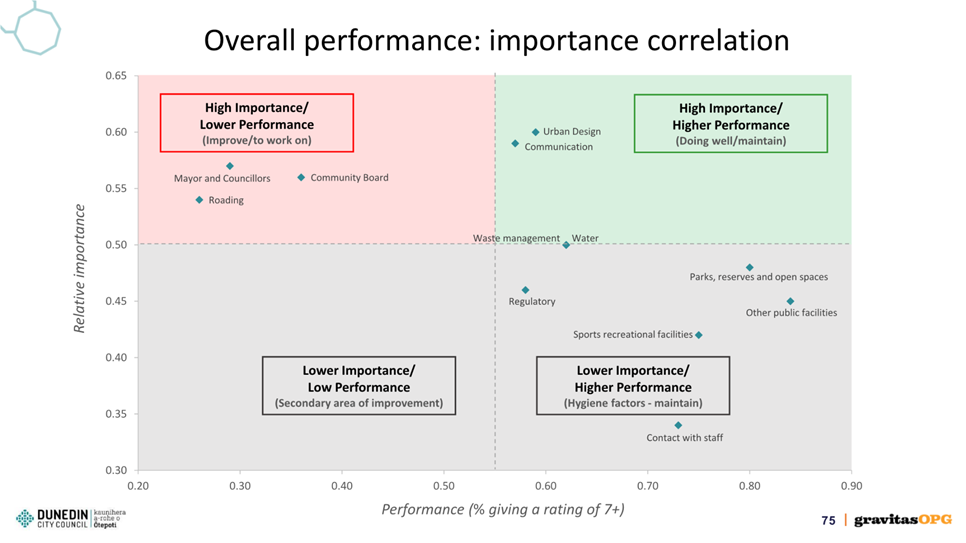
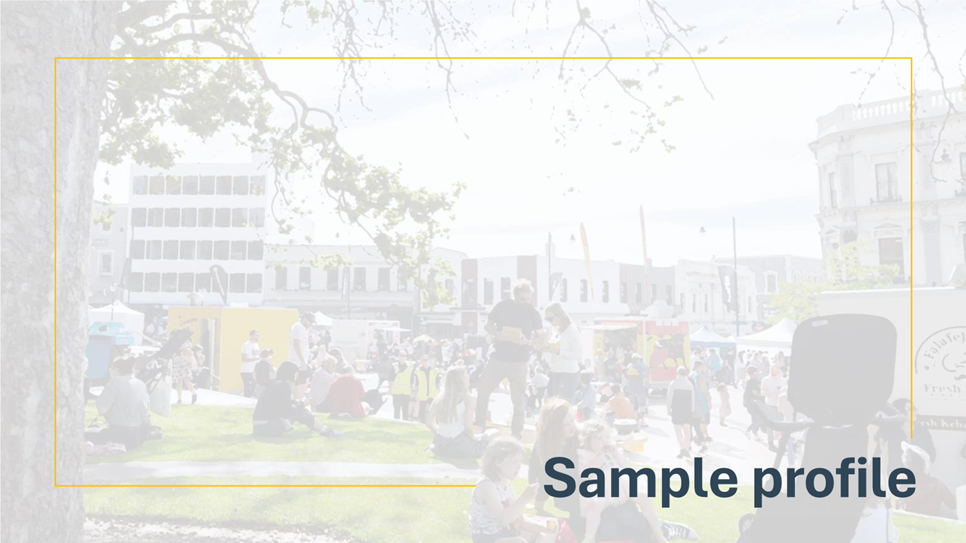
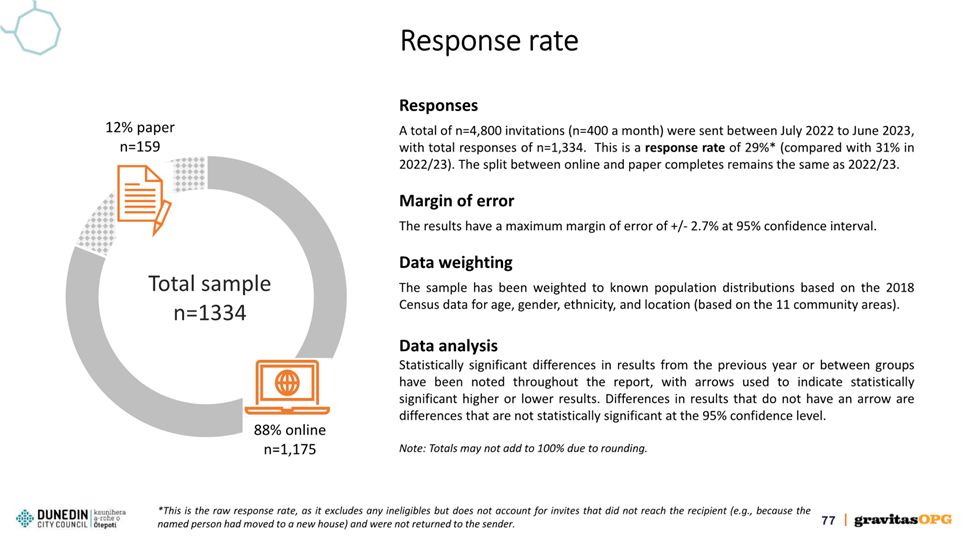
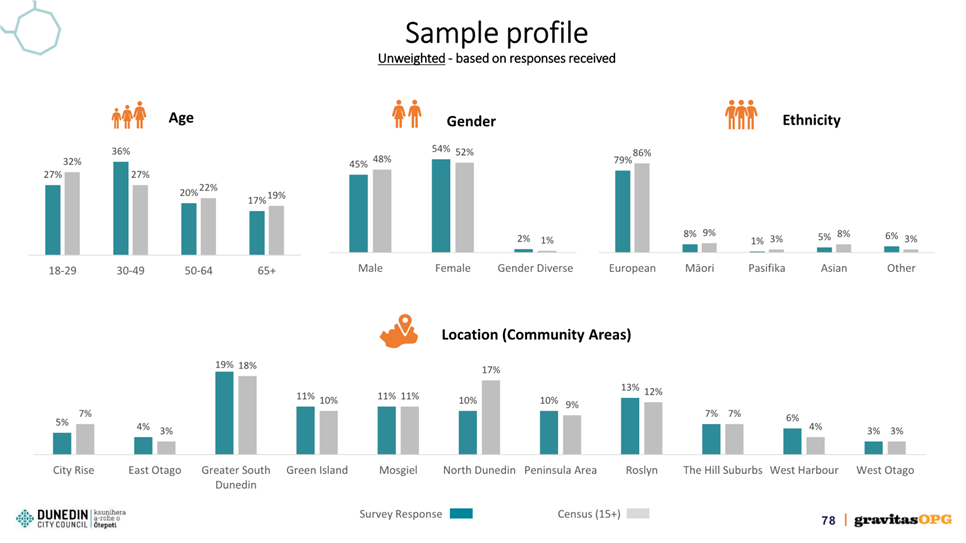

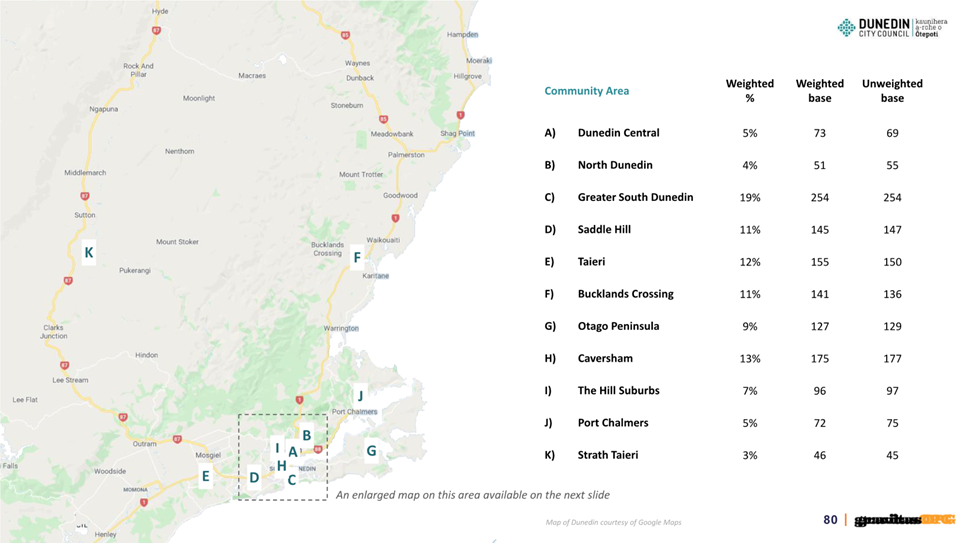
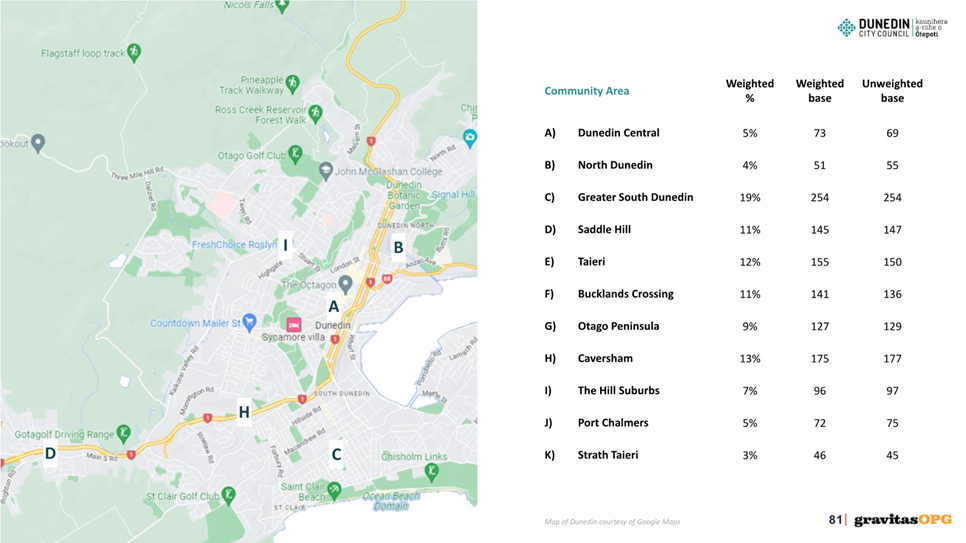
|

|
Council
24 September 2024
|
Approval to Notify Plan Change 1 – Minor Improvements
to the 2GP
Department: City Development
EXECUTIVE SUMMARY
1 This
report seeks approval to notify Plan Change 1: Minor Improvements, the first
proposed plan change to the partially operative Second Generation Dunedin City
District Plan (2GP). The proposed notification date is 20 November 2024.
2 Plan
Change 1 proposes targeted minor improvements to the 2GP. It responds to issues
identified through implementation of the 2GP, feedback from plan users, and
monitoring of plan effectiveness. The proposed changes are designed to
ensure the 2GP effectively and efficiently achieves its objectives.
3 The
decision to approve notification is made under Clause 5 of Schedule 1 of the
Resource Management Act 1991 (RMA) and allows the public submission period to
begin. The decision should be based on councillors’ satisfaction
that a proper assessment of the proposed changes has been undertaken, as
required by section 32 of the RMA.
4 If
notification of Plan Change 1 is approved, public notification will be
undertaken via a public notice, a letter to all ratepayers included in the mail-out
of the second instalment of rates notices for 2024/2025, and letters to
landowners where more significant changes are proposed (for example having a
building added to the schedule of protected heritage buildings). The
rates mailout will take place between 25 October and 22 November 2024.
RECOMMENDATIONS
That the Council:
a) Approves notification
of Plan Change 1.
b) Resolves under section 48(1)(a)(i) and section 7(2)(j) of the Local
Government Official information and Meetings Act 1987 to withhold the following
documents, which contain details of changes to the Plan that are proposed via
Plan Change 1, until 20 November, to prevent the disclosure or use of official
information for improper gain or improper advantage: a summary of all proposals
that have been assessed as part of the plan change; details of all proposed new
scheduled heritage buildings; a report evaluating the proposed changes under
RMA section 32; all proposed changes to the text of the Plan; proposed changes
to the 2GP Planning Map; and assessments of heritage values for all proposed
new scheduled heritage buildings.
c) Resolves to delay the
changes to rules associated with stormwater open watercourses from taking
effect until Plan Change 1 becomes operative, noting that under section 86B(3)
of the RMA these would otherwise take effect from the date of public
notification
d) Resolves to delegate
power to lodge a submission on the plan change under Clause 6, First Schedule
RMA to the Chief Executive Officer (or delegate)
e) Delegates to the Chief
Executive Officer (or delegate) the power to correct, or authorise the
correction of, typographical errors or to make minor amendments to the content
of Plan Change 1 or its accompanying section 32 report.
BACKGROUND
5 The
RMA requires local authorities to monitor the efficiency and effectiveness of
policies and rules in district plans. The DCC gives effect to this requirement
by keeping a database of issues that have arisen through the 2GP’s
implementation. Issues often originate from resource consents planners and
other regular plan users.
6 Common
issues are lack of clarity of provisions in specific scenarios that may not
have been considered at the time of drafting, changes in the context of how
activities are undertaken, concerns about lack of effectiveness of rules in
achieving the Plan’s objectives, and scenarios where rules can be changed
to permit, with performance standards, activities that are frequently being
granted consent with similar conditions.
7 The
matters included in the database are regularly screened to identify priority
areas to consider in a multi-topic minor improvements plan change, such as
Variation 1 or this plan change, Plan Change 1. Alternatively, they may be
marked for consideration in a future topic-specific plan change, such as Plan
Change 2 relating to heritage and multi-unit housing, which was initiated on 20
August 2024. Another driver for changes included in multi-topic and single
topic plan changes is changes needed to give effect to national or regional
direction.
8 Once
issues have been identified for a plan change, planners must follow the
evaluation process outlined in section 32 of the RMA, which includes
identifying options to address each issue, and considering whether they would
better achieve the objectives of the plan than the current provisions.
9 If
the objectives themselves are being reviewed, then these are assessed as to how
well they achieve the purpose of the RMA. The environmental, economic,
social and cultural costs and benefits of proposed changes must also be
considered. The section 32 assessment must also consider any higher order
policy instruments that sit at the regional or national level.
10 Plan Change
1 was initiated by Council on 2 November 2021, as ‘Variation 3’,
and renamed after the 2GP was made partially operative.
DISCUSSION
11 The purpose
of Plan Change 1 is to make targeted minor improvements
to the 2GP. It responds to issues identified through implementation of the 2GP,
feedback from plan users, and monitoring of plan effectiveness. The
changes are designed to ensure the 2GP effectively and efficiently achieves its
objectives.
12 The proposed
changes in Plan Change 1 include:
· Changes
to add 146 additional scheduled heritage buildings, add over 24,000 hectares of
public land to the schedule of areas of significant biodiversity value, and
schedule 12 additional significant trees.
· Changes
to provide a more enabling rule framework for health activities.
· Changes
to a wide range of provisions to make them easier to interpret and apply (for
example, amending the definition of ground level so it is easier to identify it
on sites with historical earthworks).
· Changes
to make rules more flexible (for example, rule changes to make it easier to
build garages in yards).
· Changes
to better manage environmental effects from activities where existing
provisions have been assessed as insufficient (for example, increasing the
acoustic insulation requirements for new dwellings in the inner city to reduce
the risk of complaints about live music noise, extending rules that manage
transportation effects from activities that generate a high number of traffic
movements, and requiring development to be set back from stormwater open
watercourses in more locations).
· Minor
changes to correct errors.
13 The
decision to approve Plan Change 1 is primarily a procedural decision, to allow
the public submissions and further submissions processes to begin. The
decision should be based on councillors’ satisfaction that Plan Change 1
has been developed robustly by staff in accordance with the evaluation
requirements set out in section 32 of the RMA.
14 A summary
of the amendments to the 2GP included in Plan Change 1, and the section 32
report for Plan Change 1, have been provided in a non-public report to
Council.
15 The public
notice informing ratepayers of the notification of Plan Change 1 (required by
clause 1(1A) of Schedule 1 of the RMA) will be included in the mail-out of the
second instalment of rates notices for 2024/2025. This will take place
between 25 October and 22 November 2024. The full details of Plan Change
1 and the section 32 report will not be publicly released until the date of
notification of Plan Change 1 (20 November).
16 In addition
to the legally required public notice in the ODT and the rates mail-out, the
following additional communications methods are being used:
a) Letters to all ratepayers whose properties are being
rezoned or otherwise directly affected by a proposed change (e.g. owners of
heritage buildings and significant trees that are proposed to be added to Plan
scheduled).
b) Letters to key stakeholders who have provided input into
changes as they were drafted (e.g. health providers and network utility
operators).
c) FYI article
d) City Development News articles
e) DCC social media
Rationale for Withholding Plan Change Documents Until
Date of Notification
17 Section
48(1)(a)(i) and section 7(2)(j) of the Local Government Official information
and Meetings Act 1987 allow the Council to withhold information if this is
necessary to prevent the disclosure or use of official information for improper
gain or improper advantage.
18 Because
Plan Change 1 contains a range of proposed changes that, if confirmed, will
affect specific properties and how they can be used, including the addition of
scheduled heritage buildings and trees, the addition or removal of certain
mapped areas overlying properties, and changes to zoning and landscape overlay zones
for some properties, it is recommended that the plan change documentation is
kept confidential until it is released publicly to the whole community on 20
November following letters to directly affected parties and public notices and
advertisements. If the documentation were made publicly available via the
Council website, as public attachments to this report, then there would be a
risk that some people would find out about proposed changes in advance of
others, particularly those that may be most directly affected. This
information has the potential to be used for improper gain or advantage, for
example if affected properties are bought and sold in the interim period.
Decision on
Rules Taking Effect
19 The RMA
sets out when rules proposed in plan changes begin to have ‘legal
effect’. From the point of legal effect onwards, proposed changes
to rules are taken into account by planners processing resource consents. When
there is more than one rule that has legal effect, the most restrictive rule
applies. This means that, for example, if no resource consent is required by
the existing 2GP, but a resource consent would be required by a rule introduced
or amended by a plan change, the new rule will begin to trigger a need for
resource consent once it has legal effect.
20 Under
section 86B of the RMA, most rules in proposed plan changes only have legal
effect once the Hearing Panel’s decision on submissions has been made and
publicly notified, but some rules have immediate legal effect from the date of
public notification of the plan change for submissions. These are rules
that: protect or relate to water, air, or soil (for soil conservation); protect
areas of significant indigenous vegetation or significant habitats of
indigenous fauna; protect historic heritage; or provide for or relate to
aquaculture activities. In most cases, this approach reflects the status
of these values as matters of national importance (section 6) under the RMA.
21 However,
the Environment Court may order that rules have legal effect from a different
date and a local authority may also resolve to delay the legal effect of rules
to the date on which the plan change is made operative (but can rescind that
request later so that rules begin to have legal effect at the time of
decisions, to align all rules to the same timeframe).
22 In the past,
the Council has sought through the Environment Court that some rules have legal
effect earlier, and has resolved to delay the legal effect of rules in other
cases. For example, where rules do not have legal effect until after decisions,
if it were considered likely that the introduction of a new, more restrictive
rule (such as an increase in the minimum site size for subdivision) could
create a rush of activities seeking to get in ahead of legal effect, thereby
defeating the purpose of the rule change, then the Council would request that
the Court apply legal effect from first notification. Likewise, it could
delay the legal effect of a rule that the RMA has taking legal effect at the
time of notification where this type of risk does not exist. Delaying rules in
this case would allow rules to be tested and refined through the submission and
hearing process before they take effect.
23 There are
three proposed changes in Plan Change 1 that would result in rules that have
immediate legal effect under section 86B(3), in the absence of a Council
resolution to the contrary. These are:
· Change
SHB3, which proposes to add 146 historic buildings to the Schedule of Protected
Heritage Items and Sites (Appendix A1.1);
· Change
NE7, which proposes to protect publicly owned areas of significant biodiversity
value by adding them to the Schedule of Areas of Significant Biodiversity Value
(“ASBV schedule”) (Appendix A1.2); and
· Change
Res13, which proposes to add an identified network of ‘stormwater open
watercourses’ to the 2GP Planning Map, and to amend rules to ensure that
effects on stormwater infrastructure are managed when development is proposed
close to those watercourses.
24 In the case
of Change Res13, it is recommended that the Council resolve to delay associated
rules from taking legal effect until after the plan change has been made
operative. The key reasons for this recommendation are:
a) to
recognise that the likely intent of the RMA in applying immediate legal effect
to rules about water was linked to regional council functions (e.g. management
of water quality and quantity), rather than the management of stormwater open
watercourses;
b) to enable
any required improvements to the mapping of watercourses to be made via the
submissions process; and
c) to
allow the Panel to consider submissions on the appropriate setback to be
required from stormwater open watercourses prior to the rule applying.
d) There is
unlikely to be a rush of activity on sites affected by the rule before the rule
have legal effect and there are some current requirements that manage water
courses subject to easements.
25 Therefore,
the third decision requested in this report is to resolve to delay the rule
changes included in Change Res13 from taking effect until Plan Change 1 becomes
operative. This decision must be made before public notification of Plan
Change 1 and must be included in the public notice. It should be noted
that this decision can be rescinded at any time. Past practice has been
to rescind resolutions of this kind once the Hearing Panel’s decision is
released on a variation/plan change, which is the time when all other rules
normally have legal effect.
26 It is noted
that the Council may also choose to take the same approach for the additions to
the heritage schedule, in change SHB3, and/or for the additions to the ASBV
schedule, in change NE7, however, this has not been recommended.
Scheduled
Heritage Buildings
27 Owners of
the buildings proposed for addition to the heritage schedule via Plan Change 1 have
been contacted by letter and have had an opportunity to meet Council staff and
provide relevant information about their buildings. Where appropriate,
this information has led to updates to the heritage assessments for these
buildings.
28 Addition of
buildings to the heritage schedule has both costs and benefits for
owners. Inclusion in the schedule means that resource consent is required
for some types of work affecting the protected part of the building. In many
cases the protected part is limited to the façade of the building to the
street. A resource consent is not required for ‘like for like’
repairs and maintenance. For scheduled buildings in heritage precincts, a
resource consent is also required for work to a non-protected part of the
building, if the work is visible from a public place.
29 When making
a decision on these types of resource consent, the 2GP requires consideration
of the effect of the changes on the heritage values of the building. The 2GP
policies support work required for the building to comply with the Building
Act. Work required for earthquake strengthening of heritage buildings is
a ‘controlled activity’, meaning that the Council must grant the
consent.
30 Demolition
of a scheduled heritage building is a ‘non-complying activity’, and
the policies in the plan do not support demolition unless either: the building
poses a significant risk to safety or property; or the demolition is required
for a project that would have significant public benefit that could not
otherwise be achieved, and there are no reasonable alternatives to demolition.
31 Some
categories of resource consent for work on scheduled heritage buildings, such
as replacement of roofs, have no fees. For other resource consents for
activities affecting scheduled heritage buildings, the deposit to be paid at
the time of application is $1850. The range of free consents will be
reviewed as part of the 9 year plan process.
32 There is
financial support available to heritage building owners. The Dunedin
Heritage Fund makes grants annually towards work on heritage buildings across
Dunedin that supports conservation and re-use. Building owners can apply for
grants towards work such as repairs and maintenance, upgrades required by the
Building Act (e.g. relating to fire or access), and earthquake
strengthening. The fund is contestable, and scheduled buildings are
prioritised over other (non-scheduled) historic buildings. Details of
recent heritage fund grants can be found on the DCC website: Dunedin
Heritage Fund - Dunedin City Council.
33 In
addition, the 2GP permits a wider range of uses in scheduled heritage buildings
in some zones, in order to encourage re-use of heritage buildings. Office
activities may be undertaken as a permitted activity in scheduled buildings in
the Warehouse Precinct and Smith Street York Place zones, whereas they would be
a non-complying activity in buildings not on the heritage schedule. A
change to widen this approach is being considered as part of Plan Change 2.
34 Oher
incentives for owners of scheduled heritage buildings will be considered as
part of Plan Change 2 which relates to heritage and multi-unit housing, and via
the Long Term Plan.
35 It should
be noted that the 2GP heritage schedule is separate from the Heritage New
Zealand Pouhere Taonga (HNZPT) listing process, although the 2GP heritage
schedule does include most buildings listed with HNZPT. Inclusion on the
HNZPT list recognises the heritage significance of a building, but it is the
inclusion in the 2GP heritage schedule that leads to the resource consent
requirements set out above.
OPTIONS
Option One a) – Recommended Option – Approve
notification of Plan Change 1 on 20 November 2024 and delay legal effect for stormwater
open watercourse rules
36 Under this
option, Council would approve the public notification of Plan Change 1: Minor
Improvements on 20 November, initiating the submission period, and resolve to delay
the changes to rules associated with stormwater open watercourses from taking
effect until Plan Change 1 becomes operative.
Advantages
· Will
allow the submission period to start on a plan change that will make a range of
improvements to the Plan, including protecting additional heritage buildings
and providing for health activities in a more enabling way, as well as making
numerous minor improvements to remove unnecessary consent requirements and
increase the efficiency with which provisions achieve Plan objectives.
· Delaying
legal effect for the stormwater open watercourse rules means that the proposed
rules and associated mapping can be tested and refined through the submissions
and hearing process before they have effect.
Disadvantages
· None
identified.
Option One b) – Approve notification of Plan Change 1
on 20 November 2024, but do not delay legal effect for stormwater open watercourses
rules
37 Under this
option, Council would approve the public notification of Plan Change 1: Minor
Improvements on 20 November, initiating the submission period, and the changes
to rules associated with stormwater open watercourses would take legal effect
from that date.
Advantages
· Will
allow the submission period to start on a plan change that will make a range of
improvements to the Plan, including for example protecting additional heritage
buildings and providing for health activities in a more enabling way, as well
as making numerous minor improvements to remove unnecessary consent
requirements and increase the efficiency with which provisions achieve Plan
objectives.
Disadvantages
· If
the stormwater open watercourse rules have legal effect from 20 November, the
rules and associated mapping will take effect before they have the chance to be
tested and refined via the submissions and hearing process.
Option Two – Delay notification of Plan Change 1
38 Under this
option, Council would defer approval of the notification of Plan Change 1 to a
later date.
Advantages
· If
considered necessary, would allow time to address any shortcomings in the plan
change and section 32 assessment.
Disadvantages
· Would
delay the plan change and the outcomes the plan change seeks to achieve as
outlined in the plan change documentation.
· Would
delay other parts of the District Plan work programme.
NEXT STEPS
39 If
approved, Plan Change 1 will be notified on 20 November and will be open for
submission until 18 December.
40 After the
submission period ends, submissions will be summarised by staff and a summary
published. At this point, people may make “further
submissions” to support or oppose the submissions made during the initial
submission period. Hearings will then be held for any submitters who wish
to speak to their submissions or further submissions, and decisions on
submissions will be made by the Hearing Panel.
Signatories
|
Author:
|
Emily McEwan - Senior Planner City Development
Jane MacLeod - Team Leader Planning
|
|
Authoriser:
|
Dr Anna Johnson - City Development Manager
David Ward - General Manager, 3 Waters and Transition
|
Attachments
|
|
Title
|
Page
|
|
⇩a
|
Letter to ratepayers
and public notice
|
128
|
|
SUMMARY OF CONSIDERATIONS
|
|
Fit with purpose of Local Government
This decision enables democratic local
decision making and action by, and on behalf of communities.
This decision promotes the social,
economic, environmental and cultural well-being of communities in the present
and for the future.
|
|
Fit with strategic framework
|
|
Contributes
|
Detracts
|
Not applicable
|
|
Social Wellbeing Strategy
|
✔
|
☐
|
☐
|
|
Economic Development Strategy
|
✔
|
☐
|
☐
|
|
Environment Strategy
|
✔
|
☐
|
☐
|
|
Arts and Culture Strategy
|
✔
|
☐
|
☐
|
|
3 Waters Strategy
|
✔
|
☐
|
☐
|
|
Future Development Strategy
|
✔
|
☐
|
☐
|
|
Integrated Transport Strategy
|
✔
|
☐
|
☐
|
|
Parks and Recreation Strategy
|
✔
|
☐
|
☐
|
|
Other strategic projects/policies/plans
|
☐
|
☐
|
✔
|
|
|
Māori Impact Statement
In accordance with clauses 3 and 4A of the First Schedule
to the RMA, tangata whenua have been consulted through iwi authorities, a
copy of the draft proposed plan change has been provided to iwi authorities,
and staff have had particular regard to the advice subsequently received on
the draft.
|
|
Sustainability
Sustainable management is a fundamental principle of the
RMA, and Plan Change 1 has been developed in accordance with this principle.
|
|
LTP/Annual Plan / Financial Strategy /Infrastructure
Strategy
No implications.
|
|
Financial considerations
Plan Change 1 has been included in proposed 9 year
budgets, however, the full costs of appeals can fall outside of budgets as
they are difficult to predict.
|
|
Significance
The decisions of this report are considered low in terms
of Council’s Significance and Engagement Policy.
|
|
Engagement – external
Regular plan users and key stakeholders have been
consulted on the proposed changes to the Plan.
|
|
Engagement - internal
A range of departments, including Resource Consents,
Building Services and infrastructure teams have been consulted on proposed
changes to the Plan.
|
|
Risks: Legal / Health and Safety etc.
None identified.
|
|
Conflict of Interest
None identified.
|
|
Community Boards
Community Boards will have the opportunity to submit on
the changes.
|
|

|
Council
24 September 2024
|
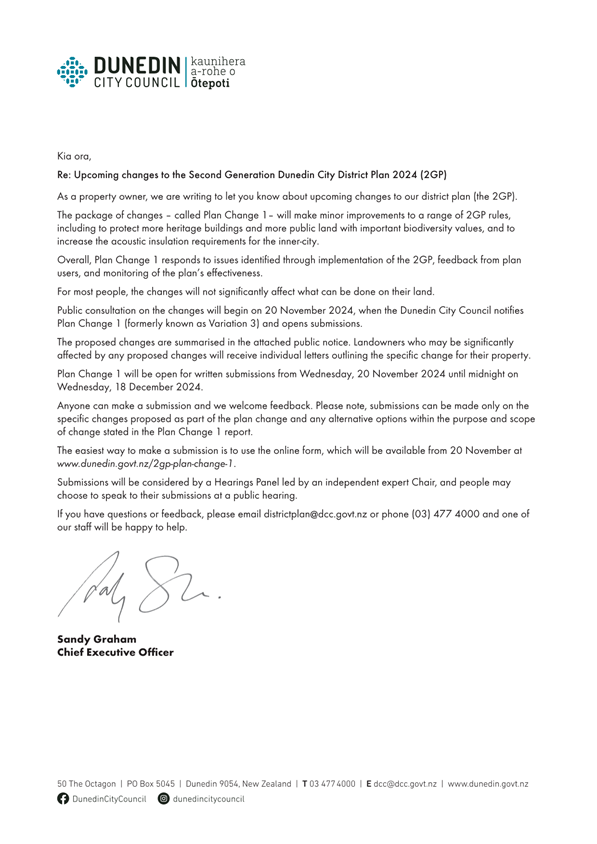
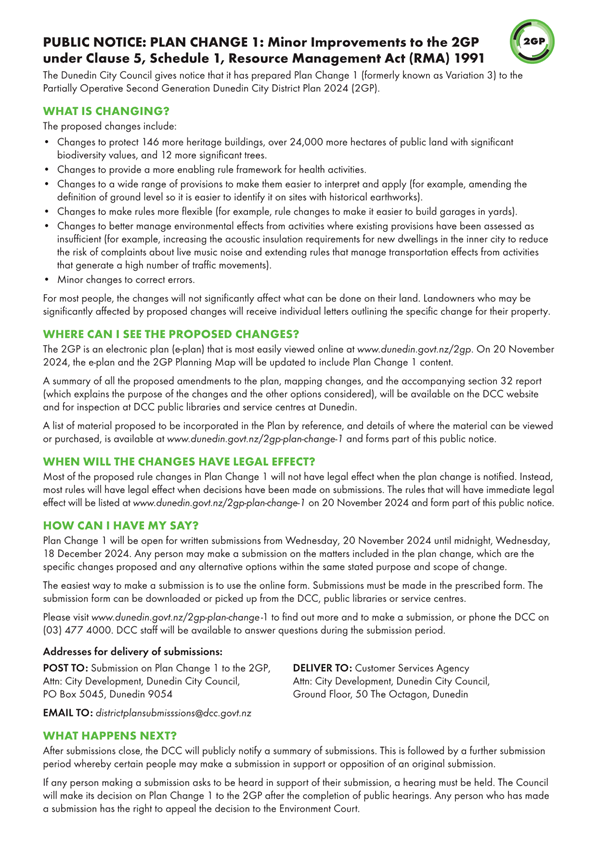
|

|
Council
24 September 2024
|
Sustainability Framework
Department: Corporate Policy
EXECUTIVE SUMMARY
1 The
purpose of this report is to:
a) summarise
the work to date on the development of the City Portrait for adaptation for a
Ōtepoti Dunedin context.
b) revisit
the United Nations Sustainable Development Goals (SDGs) as an alternative
framework, following an SDG workshop that Councillors recently attended.
c) seek
Council decision on whether the City Portrait should progress to the next phase
of community engagement or if Council wishes to explore alternative frameworks
to represent the Dunedin City Council’s (DCC) commitment to
sustainability.
RECOMMENDATIONS
That the Council:
a) Decides whether to proceed
with the development of the City Portrait to the community engagement stage.
If Council decides not to proceed with the City Portrait,
then;
b) Requests staff to
develop alternative frameworks for consideration, based on the United Nations Sustainable Development Goals
BACKGROUND
2 The
DCC’s Strategic Framework is underpinned by a commitment to the Treaty of
Waitangi and sustainability.
3 A
vision for ‘Sustainable Practice’ at the DCC was initially adopted
in 2009 for use in the 10 year plan, in response to community feedback. In
2012, the concept of sustainability became a guiding principle underpinning the
DCC’s Strategic Framework.
4 In
2020, the DCC decided to refresh its Strategic Framework. As a first step in
the Strategic Framework Refresh, consultants Harrison Grierson undertook an
initial high-level stocktake of the existing framework. It was considered that
a clearer representation of the sustainability guiding principle along with
that of the Treaty of Waitangi would be helpful in the refresh of the Strategic
Framework.
5 In
September 2020, Council approved the development of the City Portrait as a
framework to represent its commitment to sustainability. The other two options
presented for Council’s consideration were the United
Nations Sustainable Development Goals (SDGs) and New Zealand
Treasury’s Living Standards Framework (LSF). The Council resolved as
follows:
Moved (Cr
Steve Walker/Cr Christine Garey):
That the
Council:
a) Considers
the sustainability frameworks set out in the report, and
b) Approves
development of the City Portrait framework for development and adaptation.
Division
The Council
voted by division:
For: Crs
Sophie Barker, David Benson-Pope, Christine Garey, Doug Hall, Mike Lord, Jim
O'Malley, Chris Staynes, Steve Walker and Mayor Aaron Hawkins (9).
Against:
Crs Rachel Elder, Jules Radich, Lee Vandervis and Andrew Whiley
(4).
Abstained:
Nil
The division
was declared CARRIED by 9 votes to 4
Motion
carried (CNL/2020/072)
6 Key
reasons for supporting the development of the City Portrait over the SDGs and
LSF were because the City Portrait was:
· user-friendly and
easier for wider community to engage with, as it graphically demonstrates
sustainability
· built on the SDGs,
offering a way to adapt them to a local context to reflect local situations
· conceptually
stronger and a better visualisation tool to graphically show the progress made
in taking care of people and the planet
· a better
reflection of the DCC’s responsibilities for the entire city.
City Portrait and United Nations Sustainable
Development Goals
7 In
September 2023, a report on comparative analysis of the City Portrait and SDGs
was presented to Council, as requested from Councillors. A key point in the
report was that they were not entirely distinct, and each represented different
approaches to supporting sustainability at different geographical scales, with
the latter specifically designed for cities. The ‘Comparative
Analysis’ section of this report is provided as Attachment A.
8 In
August 2024, Councillors attended a workshop on the SDGs, facilitated by
consultants from Bead and Proceed Limited. The SDGs identified as having
the greatest potential for DCC influence and impact were SDG 6: Clean Water and
Sanitation. SDG 11: Sustainable Cities and Communities. SDG13: Climate Action
and SDG 9: Industry, Innovation and Infrastructure. Councillors highlighted
SDG17 (Partnerships for the Goals) as being crucial to the delivery of
sustainable action. They emphasised that collaboration with organisations,
partners, stakeholders and residents as key to implementing services, actions
and policies that align with specific goals.
DISCUSSION
Work undertaken to date on the development of the
City Portrait
9 Since
the Council’s approval in 2020, work has been undertaken to develop the
City Portrait specific to Ōtepoti Dunedin, including:
· Carrying out
literature review – national and international literature
· Researching and
identifying Ōtepoti Dunedin’s ecological and social measures, using
the DCC’s existing Wellbeing Strategies and other relevant strategies and
plans.
· Drawing on
consultant advice and education specialised in planetary boundaries measures
and how to translate these to Ōtepoti Dunedin context
· Drafting of a City
Portrait in line with existing DCC’s strategies and plans, as well as
legislative requirements
· Councillors workshops
for staff to gather feedback
· Networking with
community groups and other Councils/groups both nationally and internationally
· Key points of the
recent Councillor workshop on the SDG framework and how to align them with
organisational goals are outlined in paragraph 12.
10 A draft of
the Ecological Ceiling component of the City Portrait was developed with
assistance from the Planetary Accounting Network (PAN) and presented to Council
in September 2023. It demonstrated Ōtepoti Dunedin's ecological impact (Attachment
B). It marked a first milestone in the development of the City Portrait, which
is designed to be iterative through working with partners, stakeholders and
communities.
11 The
following further information is also provided in Attachment B.
· an overview of the City Portrait methodology
· a summary of work undertaken to date on the City Portrait
development
· a draft illustration as a communication tool
· a list of reports and workshops on this topic presented
before Council.
Revisiting the SDGs
12 The summary
report of the SDG workshop that Councillors attended outlines four key steps
for the implementation of the SDGs at a city level. They are to:
(1) launch
an inclusive and collaborative process: Increase awareness of the SDGs and
involve stakeholders in a collective effort to achieve the goals and targets to
ensure the community is engaged in the process so there’s effective data
collection and community endorsement.
(2) localise
the goals relevant to the issues in the city: Adapt the global SDGs into a
practical and ambitious plan that reflects the specific needs and context of
the local community.
(3) plan
for SDG implementation: Apply goal-oriented planning strategies to promote
sustainable social, economic, and environmental development. This could be done
by creating a new strategy, one with a clean slate that includes a new vision
and end date in mind.
(4) monitor
and evaluate progress: Track the progress of SDG implementation and build
local capacity for responsive and accountable governance. This involves
building indicators or using existing methods and tools to capture such data.
13 The report
underlines the freedom and creative license as to how anyone can use the goals
to communicate its impact on sustainable development challenges. It also
showcases some international examples of implementation of the SDGs at a city
level, including Bristol (UK), Baltimore (UAS) and Melbourne (Australia).
In comparison
to the City Portrait
14 As per
paragraph 12 (2), the flexibility of the SDGs might be seen as an advantage in
terms of monitoring progress as it allows the DCC to decide how best to
integrate the SDGs and targets to suit the existing issues and challenges of
the city.
15 In
contrast, the Ecological Ceiling component of the City Portrait discussed in
paragraph 10 uses science-targets to measure and show Ōtepoti
Dunedin’s ecological impact against the nine planetary boundaries
(detailed in Attachment A). Monitoring of such measures would pose a challenge
as some elements are outside the DCC’s remit, and there is a lack of
system for collecting key data.
Use of sustainability framework by city stakeholders
and other territorial authorities in the region
16 United
Nations-affiliated programmes have a strong connection to the SDGs. Locally,
this includes the UNESCO City of Literature initiative, and Whaiao Regional
Centre of Expertise Otago, led by the Otago Polytechnic (now Te Pūkenga),
and the University of Otago which signed the SDG Accord of international
universities and colleges and regularly release information on its contribution
to the achievement of the SDGs.
17 University
of Otago makes information available on their website about how they are
contributing to the 17 global SDG goals through their research, teaching and
operations although no targets and indicators are specified.
18 Central
Otago District Council’s Sustainability Strategy 2019 – 2024 incorporates
the SDGs and aligns local actions with global goals, while focusing on issues
Council directly controls in the first instance.
OPTIONS
19 Two options
are provided for consideration by Council.
Option One – Approve to progress the City Portrait
development to public engagement stage
20 Under this
option, Council would confirm its commitment to the development of the City
Portrait, as resolved at the 29 September 2020 Council meeting (CNL/2020/072)
and would approve the development to progress to the public engagement stage.
Advantages
· Enables
building on in-depth research and analysis done since 2021, including the
development of a draft Ecological Ceiling that is specifically designed for a
local context and applicable at all levels (strategic and operational)
· No
further resourcing would be required to investigate alternative sustainability
framework for development and adaptation
· Enables
integration of Te Taki Haruru – Māori Strategic Framework and the
four wellbeing strategies, tying the City Portrait with Council’s
statutory purposes under the Local Government Act 2002
Disadvantages
· Requires
simplification of the language and concept used to communicate the City
Portrait for public engagement
· Requires
extensive community engagement as the City Portrait development is designed to
be iterative through working with communities and stakeholders across the city
Option Two – Pause the
development of the City Portrait and explore options based on SDGs
21 Under this
option, Council would pause the development of a City Portrait as resolved at
the 29 September 2020 meeting, and instead request staff to explore other
sustainability frameworks for adaptation to a local context.
Advantages
· Provide
an opportunity to reconsider the previous resolution, taking into consideration
the work already undertaken and regional developments
· Provide
an opportunity to explore alignment with city stakeholders on a sustainability
framework
Disadvantages
· Further
discussion and decisions would be required from Council to identify its
position or preference on alternative sustainability frameworks for staff to
explore
· Potential
reputational risk if the community becomes concerned by the revocation of the
city portrait and any delays caused by Council pursuing an alternative
framework.
NEXT STEPS
22 If Council
approves the commitment to the City Portrait development, staff will:
· develop engagement
materials using simple language and concept.
· prepare an
engagement plan.
· undertake the public
engagement.
· develop indicators
and targets in line with Te Taki Haruru – Māori Strategic Framework and
the four wellbeing strategies.
· draft an
implementation plan.
· support fostering
city-wide ownership of Ōtepoti Dunedin’s City Portrait, while clarifying
the DCC’s roles and responsibilities in the City Portrait in relation to
DCC’s remit.
23 If Council
decides to pause the development the City Portrait , staff will discontinue the
further development of the City Portrait and explore other alternatives based
on the SDGs for development and adaptation. Details would be provided in a
future report.
Signatories
|
Author:
|
Alix de Blic - Senior Policy Analyst
Junichi Sugishita - Senior Policy Analyst
|
|
Authoriser:
|
Nadia Wesley-Smith - Corporate Policy Manager - Acting
Nicola Morand - Manahautū (General Manager Policy and
Partnerships)
|
Attachments
|
|
Title
|
Page
|
|
⇩a
|
Extract Comparative
Analysis on City Portrait and United Nations Sustainable Development Goals
|
138
|
|
⇩b
|
City Portrait
development to date
|
141
|
|
SUMMARY OF CONSIDERATIONS
|
|
Fit with purpose of Local Government
This decision enables democratic local
decision making and action by, and on behalf of communities.
This decision promotes the social,
economic, environmental, and cultural well-being of communities in
the present and for the future.
|
|
Fit with strategic framework
|
|
Contributes
|
Detracts
|
Not applicable
|
|
Social Wellbeing Strategy
|
✔
|
☐
|
☐
|
|
Economic Development Strategy
|
✔
|
☐
|
☐
|
|
Environment Strategy
|
✔
|
☐
|
☐
|
|
Arts and Culture Strategy
|
✔
|
☐
|
☐
|
|
3 Waters Strategy
|
✔
|
☐
|
☐
|
|
Future Development Strategy
|
✔
|
☐
|
☐
|
|
Integrated Transport Strategy
|
✔
|
☐
|
☐
|
|
Parks and Recreation Strategy
|
✔
|
☐
|
☐
|
|
Other strategic projects/policies/plans
|
✔
|
☐
|
☐
|
The existing DCC’s Strategic Framework is
underpinned by a commitment to the Treaty of Waitangi and
sustainability. The decision on a clear representation of
sustainability concerns all of the DCC’s
strategies.
|
|
Māori Impact Statement
Mana whenua and mātāwaka are partners in the
development of Te Taki Haruru - Māori Strategic
Framework and in the Strategic Refresh work programme, of
which the development of a sustainability
framework is part. To date, use of the four wellbeings has
ensured the City Portrait is relevant to the
people of Dunedin, while retaining a strong connection
with the Māori Strategic Framework, which has
also used the four wellbeings in its development.
|
|
Sustainability
The development and adoption of a sustainability framework
for the city will promote the social,
economic, environmental and cultural wellbeing of
communities in the present and for the future. It
will do this by clarifying the interpretation and measures
of sustainability and promoting consistent
application of this development approach.
|
|
LTP/Annual Plan / Financial Strategy /Infrastructure
Strategy
The Strategic Refresh, which will be informed by
development of a sustainability framework, will
directly impact on the next long term plan.
|
|
Financial considerations
Further work may have financial implications, particularly
if external resources are required which are not budgeted.
|
|
Significance
This report is considered low significance in
terms of the Significance and Engagement Policy will continue to progress the
implementation of the DCC’s strategic commitment to sustainability. The
Strategic Refresh itself is of high importance and the development of a
sustainability framework will requirea level of engagement with the
community.
|
|
Engagement – external
There has been no external engagement.
|
|
Engagement - internal
There has been no internal engagement.
|
|
Risks: Legal / Health and Safety etc.
Reputational risk is covered in the discussion part of the
report.
|
|
Conflict of Interest
No conflict of interest has been identified.
|
|
Community Boards
No implications for the Community Boards have been
identified.
|
|

|
Council
24 September 2024
|
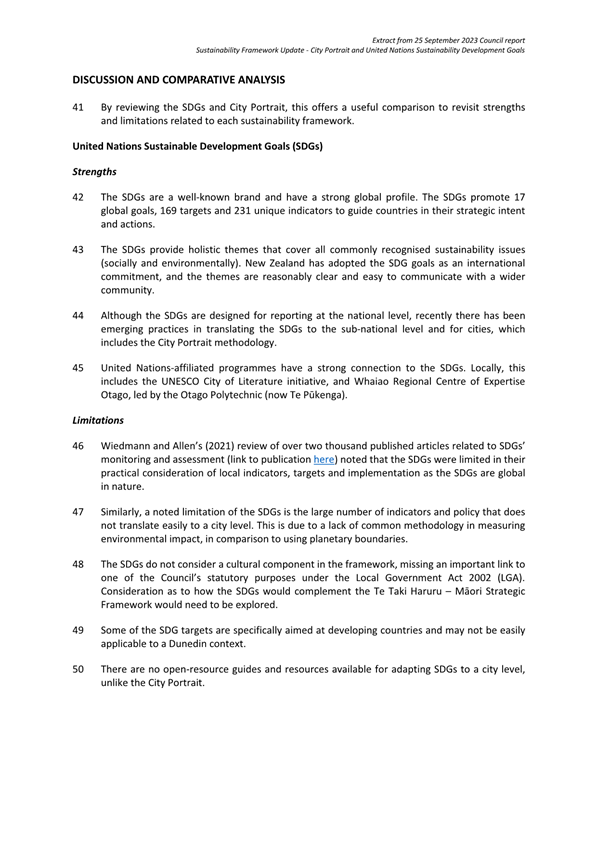
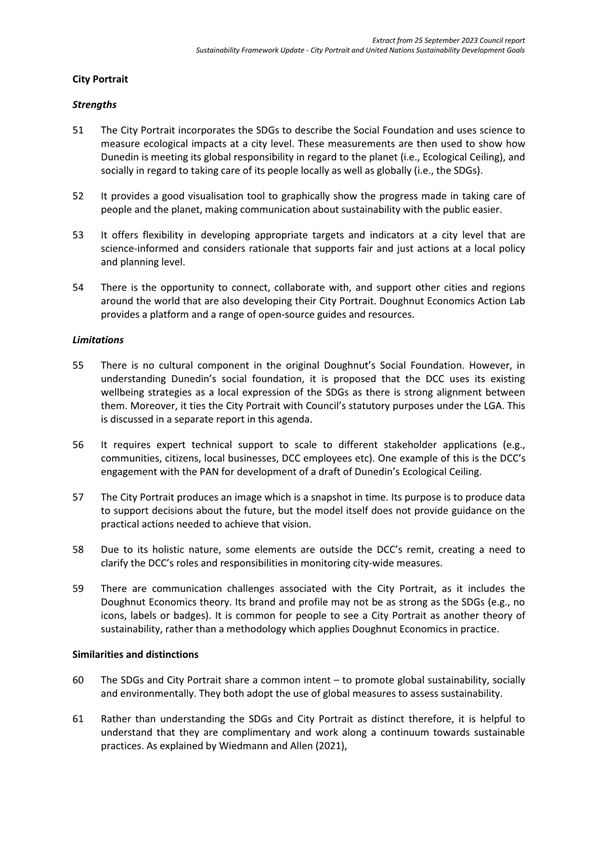
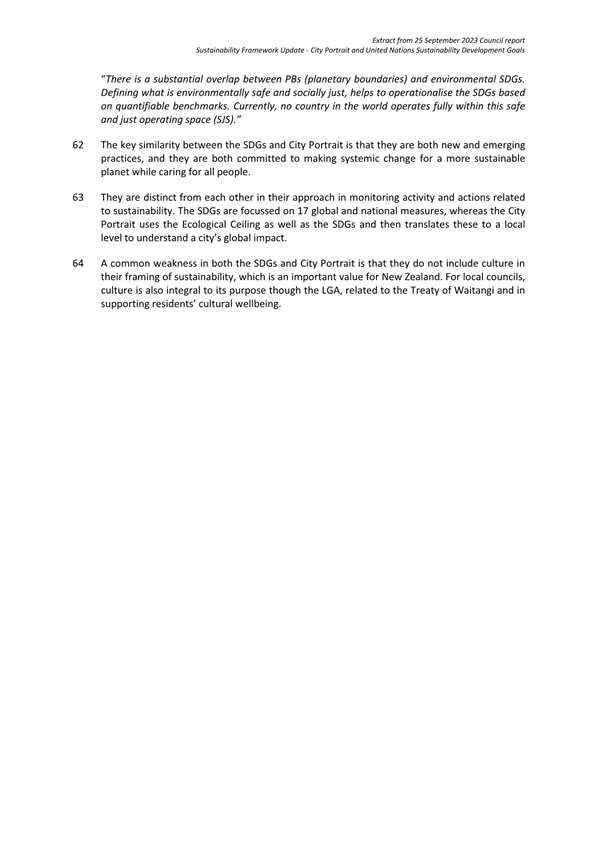
|

|
Council
24 September 2024
|
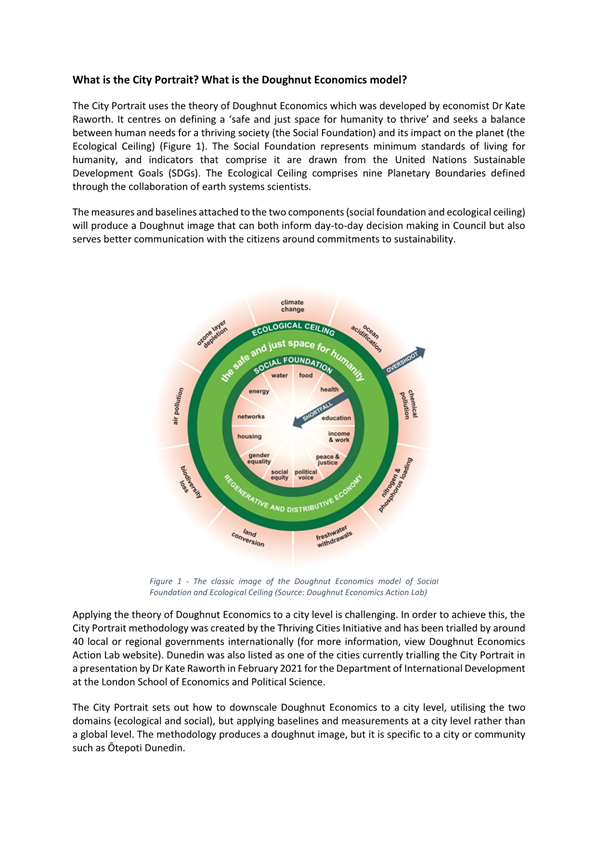
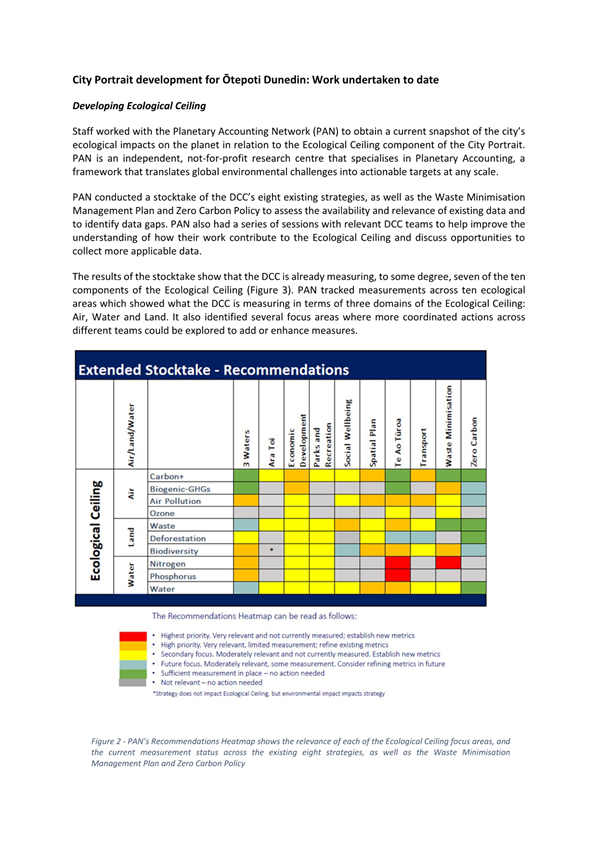
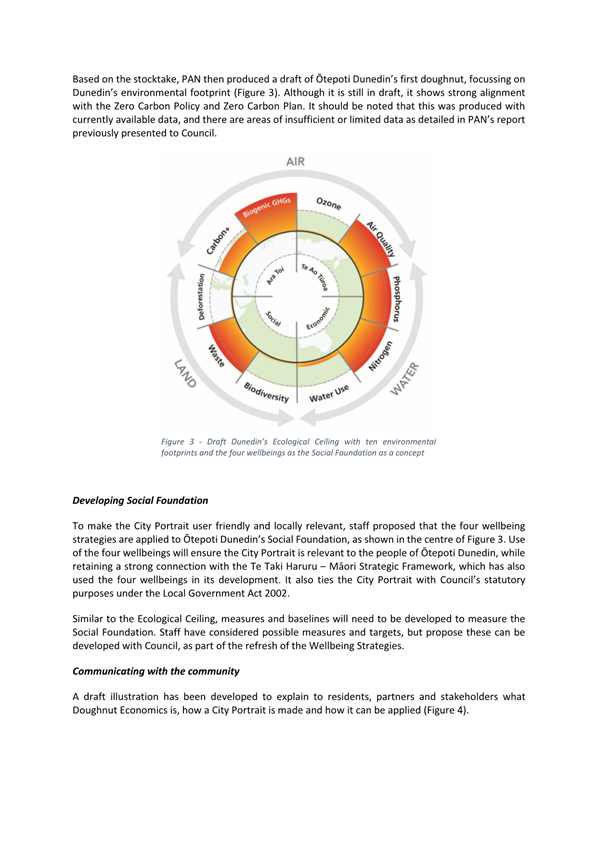
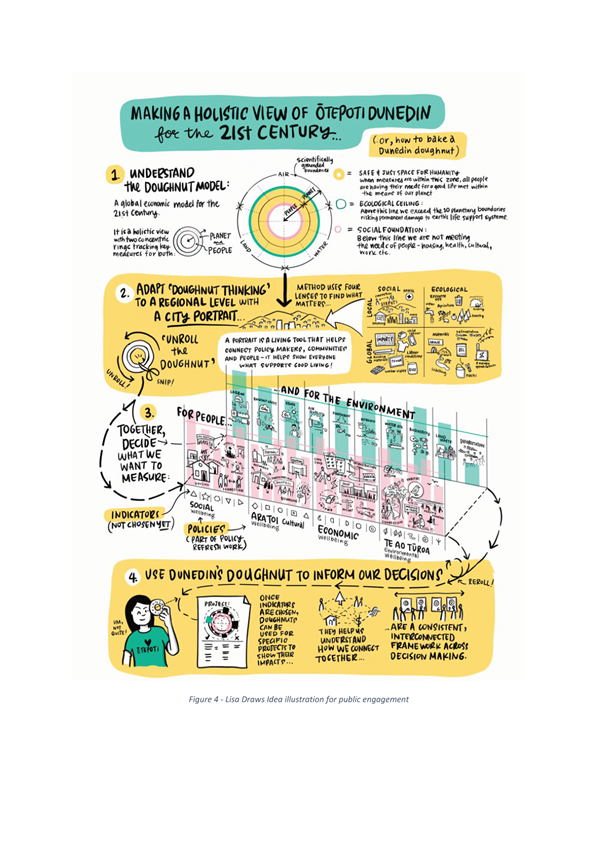
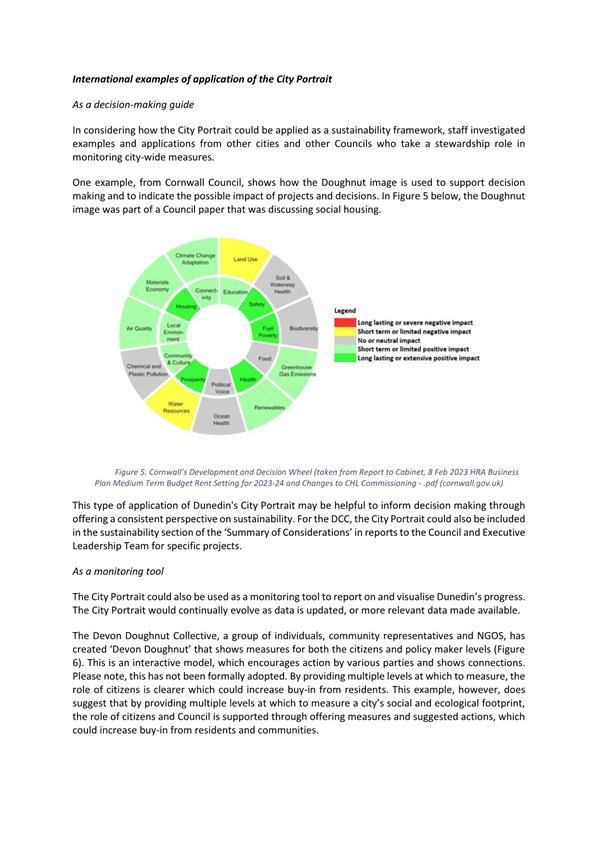
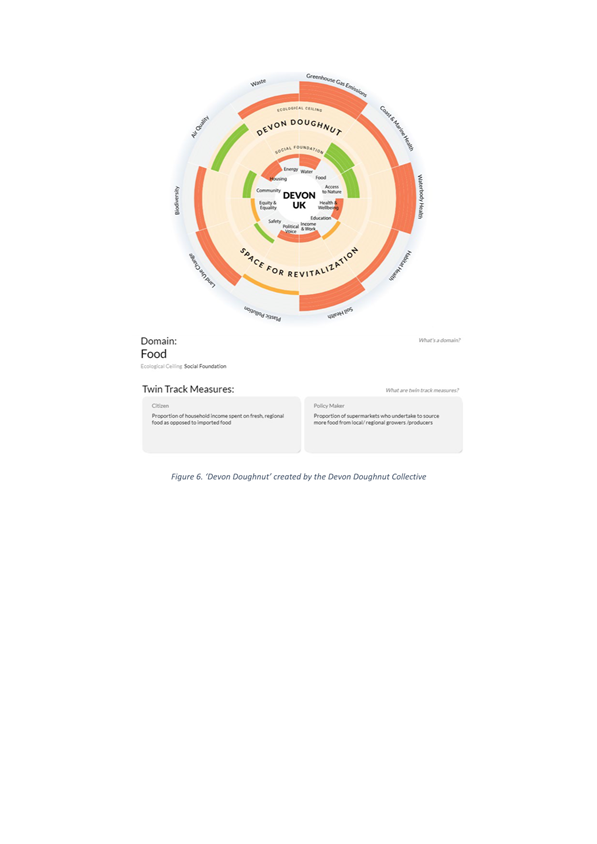
|

|
Council
24 September 2024
|
South Dunedin Future - Risk Assessment Update and Programme
Changes
Department: Climate and City Growth
EXECUTIVE SUMMARY
1 This
report provides an update on technical work relating to the South Dunedin Risk
Assessment, describes constraints faced in finalising this technical report,
and associated implications for the South Dunedin Future programme.
2 A
review of the draft risk assessment for South Dunedin has identified
information gaps and data limitations related to flood modelling and floor
levels, which have prevented finalisation of the technical report. Finalisation
of the risk assessment has been delayed while additional work is undertaken to
fill these gaps, including bringing forward completion of an updated flood
model and collecting building floor level information for South Dunedin.
3 This
additional work is expected to be completed in late October, enabling finalisation
of the risk assessment and spatial adaptation options for South Dunedin by
December 2024. It is now expected these technical reports will be presented to
Councils in February 2025 and, subject to Council decisions, consulted with
affected communities and wider public in March to April 2025.
4 The
South Dunedin risk assessment will now be released at the same time as the spatial
adaptation options report, in line with stakeholder preferences.
RECOMMENDATIONS
That the Council:
a) Notes a review of the
draft risk assessment for South Dunedin has identified information
gaps and data limitations that have prevented finalisation of this
technical report.
b) Notes work underway to
address identified information gaps and data limitations, including bringing
forward completion of an updated flood model and collection of building floor
level information for South Dunedin.
c) Notes the associated
delay in finalising the risk assessment and spatial adaptation options for
South Dunedin, which are now expected to be presented to Councils and released
publicly in February 2025.
d) Notes a copy of this
report will be considered by Otago Regional Councillors on 25 September 2024.
BACKGROUND
5 The
South Dunedin Future (SDF) programme is a joint initiative between the Dunedin
City Council (DCC) and Otago Regional Council (ORC) to develop a climate
adaptation plan for South Dunedin. The programme plan was approved by DCC and
ORC Council Committees in July 2022. A high-level approach for delivering
the SDF programme is at Attachment A.
6 A
previous report to Councils in July 2024 provided an update on the SDF programme,
including a summary of the activities completed during January to June 2024,
foreshadowed key upcoming activities, and signalled potential implications of
this work. This included anticipated delivery of a risk assessment for South
Dunedin in September 2024 and spatial adaptation options in November 2024.
DISCUSSION
South Dunedin Risk Assessment
7 The
risk assessment assesses the extent to which current natural hazards (e.g.
surface flooding, coastal erosion, high ground water) present risk to people,
places and assets in South Dunedin, and how this might be affected by climate
change (e.g. more frequent and severe storm events, higher groundwater, and
rising seas). This work considers exposure to these hazards, areas of
vulnerability, and the direct and indirect consequences.
8 This
is the first time the risks faced by South Dunedin have been formally assessed,
quantified, and collated in a single report including a range of data, maps,
and graphics. The risk assessment sketches out the current trajectory under a
‘business as usual’ approach, and provides a baseline picture of
risk, against which decisions about potential risk mitigation (e.g., climate
adaptation approaches, options, and projects) can be considered.
9 The
risk assessment is based on the best available information at a given time and
is intended to provide a clear and detailed picture of risk in South Dunedin,
in order to inform development of the adaptation options and, outline the
implications of a ‘status quo’ scenario. This will enable
consideration of the case for change.
10 As reported
to Councils in July 2024, it is anticipated the risk assessment could have a range
of implications for council services and infrastructure, as well as for mana
whenua partners, affected communities, and many other stakeholders (such as
schools, public housing, and utilities companies). Further refinement of the
risk assessment may also be required in future as new information becomes
available.
Information
gaps and data limitations
11 A draft of
the risk assessment was received in July 2024, and has been reviewed by council
staff, external technical reviewers, and selected stakeholders. In
addition to informing revisions of the draft risk assessment, that review
process has identified information gaps and data limitations that have
prevented finalisation of the technical report. Specifically, these relate to:
a) Limitations
of the 3 Waters flood model, which currently lacks the capability to produce
modelling outputs at the level of detail and confidence required for the risk
assessment; and
b) A lack of
accurate floor level data for most buildings in South Dunedin, which limits the
degree to which the risk assessment can analyse vulnerability to flooding.
12 These
information gaps and data limitations were identified when the risk assessment
was initially scoped, however, work continued based on the principle of using
the best available information at the time. Following consideration of the
draft risk assessment report in full, these information gaps and data
limitations are now assessed as being material constraints that risk
undermining the accuracy, integrity, and logic of the risk assessment.
13 Finalising
the risk assessment with these gaps risks generating ‘false
positives’ in the results, which could have adverse real-world
implications for stakeholders, and require later redress. Finalisation of the
risk assessment has therefore been delayed until these issues can be resolved
satisfactorily.
Updated 3
Waters network model and collection of floor level data
14 In 2021,
DCC 3 Waters team commenced a project to update a number of the city’s
existing flood and wastewater network models, which were initially developed in
2011. This work included an updated flood model for South Dunedin.
15 The new
model will provide a significant advancement in flood modelling capability and
confidence, including by incorporating 2021 LiDAR information, more accurately
assessing surface flows, accounting for groundwater fluctuations and
infiltration into stormwater and wastewater systems, among other advancements.
16 The new
model was expected to be completed and calibrated by early 2025, however, delivery
has been brought forward to October 2024 to support completion of South Dunedin
Future technical reports.
17 Councils do
not hold detailed floor level information for buildings in South Dunedin. Proxy
floor level information, based on building regulations at time of construction,
was used to develop the draft risk assessment, but has since proved
insufficient in terms of accuracy and confidence. Consequently, council staff
are now undertaking street-based observational assessments of floor levels for
all buildings in South Dunedin, which will be supplemented by professional
surveys of sample of buildings, to confirm accuracy of observational
assessments. This information collection will be completed by the end of
October 2024 and will inform vulnerability analysis in the risk assessment.
18 Completion
of the new flood model and collection of floor level data will address the
material information gaps and data limitations, enabling finalisation of the
risk assessment and spatial adaptation options technical reports by December
2024. It is anticipated that final technical reports and covering papers will
be presented to Councils and released publicly in February 2025.
19 Subject to
Council decisions, community engagement on the risk assessment and spatial
adaptation options would commence in March 2025. Original and revised schedules
are outlined below:
|
Key Deliverable
|
Original
schedule
|
Revised
schedule
|
|
South Dunedin Risk Assessment provided to Council
and release publicly
|
Sep 2024
|
Feb 2025
|
|
Spatial Adaptation Options for South Dunedin
provided to Council and released publicly
|
Nov 2024
|
|
Community engagement on risk assessment and spatial
adaptation options
|
Feb/Mar 2025
|
Mar/Apr 2025
|
Impact of
revised schedule
20 The revised
programme will delay public release of the risk assessment (5 months) and
spatial adaptation options (3 months), however, associated community engagement
will only be delayed by a month. Costs associated with the flood modelling,
floor level data collection, and finalised technical reports are to be
confirmed, and may be partially offset by efficiencies elsewhere in the SDF
programme. It is anticipated that any additional costs can be covered from
within the current SDF programme budget.
Anticipated
stakeholder reactions to revised schedule
21 The changes
to the SDF programme described above have been informally discussed with
selected key stakeholders. While there is some concern around the delay,
stakeholders have the consistently advised it is more important to do this work
well, and to get it right, than to do it quickly. Most stakeholders prefer
aligning public release of the risk assessment with the spatial adaptation
options, so that the problems facing South Dunedin are accompanied by potential
solutions, enabling consideration of all relevant information. This preference
is now reflected in the revised schedule outlined above.
OPTIONS
22 As this is
a noting report, there are no options.
NEXT STEPS
23 The
following key actions are planned for the SDF programme over the next six
months:
a) Finalise
updated three waters flood model for South Dunedin (Sep-Oct 2024)
b) Collect
floor level data for South Dunedin (Aug-Oct 2024)
c) Revise
and finalise risk assessment and spatial adaptation options for South Dunedin
(Nov-Dec 2024)
d) Plan and
design of communications and community engagement risk assessment and spatial adaptation
options for South Dunedin (Dec 2024-Feb 2025)
e) Present risk
assessment and spatial adaptation options for South Dunedin to Councils (Feb
2025)
f) Subject
to Council decisions, issue public communications and undertake community
engagement (Mar-Apr 2025)
Signatories
|
Author:
|
Jonathan Rowe - Programme Manager, South Dunedin Future
|
|
Authoriser:
|
Scott MacLean - General Manager, Climate and City Growth
|
Attachments
|
|
Title
|
Page
|
|
⇩a
|
SDF Programme Overview
A3
|
159
|
|
SUMMARY OF CONSIDERATIONS
|
|
Fit with purpose of Local Government
This decision enables democratic local
decision making and action by, and on behalf of communities.
This decision promotes the social,
economic, environmental and cultural well-being of communities in the present
and for the future.
|
|
Fit with strategic framework
|
|
Contributes
|
Detracts
|
Not applicable
|
|
Social Wellbeing Strategy
|
✔
|
☐
|
☐
|
|
Economic Development Strategy
|
✔
|
☐
|
☐
|
|
Environment Strategy
|
✔
|
☐
|
☐
|
|
Arts and Culture Strategy
|
✔
|
☐
|
☐
|
|
3 Waters Strategy
|
✔
|
☐
|
☐
|
|
Future Development Strategy
|
✔
|
☐
|
☐
|
|
Integrated Transport Strategy
|
✔
|
☐
|
☐
|
|
Parks and Recreation Strategy
|
✔
|
☐
|
☐
|
|
Other strategic projects/policies/plans
|
✔
|
☐
|
☐
|
The SDF Programme is a horizontal initiative, working
across a range of vertical strategies, groups, and budgets in both DCC and
ORC. This horizontal focus is intended to drive greater strategic coherence
across Councils’ strategies and operations regarding South Dunedin,
particularly those with a direct climate change dimension. As such, the
programme has links to a wide range of strategic objectives. These are
described in the paper and attachments, which build on previous advice on
strategy and policy considerations, provided in the following reports:
South Dunedin Future – Programme Update, Item 8, DCC
Council, 23 November 2021
South Dunedin Future – Interim Update, Item 8,
Planning & Environment Committee, 4 April 2022
South Dunedin Future – Programme Plan, Item 9,
Planning & Environment Committee, 6 July 2022
South Dunedin Future – Programme Update, Item 9,
Strategy, Planning & Engagement Committee, 14 August 2023
South Dunedin Future – Programme Strategy Update,
Item 10, DCC Council, 28 November 2023
South Dunedin Future – Risk Assessment &
Adaptation Approaches, Item 6, DCC Council, 5 December 2023
South Dunedin Future – Programme Update (July 2024),
Item 9, DCC Council Meeting, 31 July 2024
|
|
Māori Impact Statement
Accurately reflecting and integrating the principles of
the Treaty of Waitangi, and Crown’s partnership with Māori, is a
central element of the SDF Programme. This is currently envisaged to include
governance arrangements, aligning strategic objectives with te ao Māori,
matauraka Māori, and mana whenua aspirations; providing meaningful
opportunities for all Māori to input their views and values; and
identifying and agreeing Māori-specific programme outputs. These are described
in the papers noted in the strategic framework section above.
|
|
Sustainability
Sustainability will be a central component of the SDF
Programme as it seeks to develop climate change adaptation options for South
Dunedin over short-, medium- and long-term timeframes. This work will be
integrated with the wider climate change work programme, including aligning
with DCC’s Emissions Management and Reduction Plan 2022 and Zero Carbon
Plan 2023.
|
|
LTP/Annual Plan / Financial Strategy /Infrastructure
Strategy
The programme management team and core programme actions
within the SDF Programme have dedicated resourcing in the 2021-2031 10-Year
Plan. Programme activities and projects (i.e. programme-related initiatives
managed by other DCC or ORC teams) are subject to the planning and budgeting
processes of those teams. The expectation is these activities and projects
will be aligned with the infrastructure strategy (if/as appropriate).
Programme planning will be aligned with the development of the 2025-2034
9-Year Plan, including the infrastructure strategy.
|
|
Financial considerations
The DCC’s portion of the SDF Programme budget is
$507,000 per annum, which has been resourced in the 2021-2031 10-Year Plan.
ORC’s portion is $420,000 per annum, which has been resourced in the
2023/24 Annual Plan. Additional grant funding of $1.45 million over two years
(2023/24 and 2024/25) has currently been allocated from the Department of
Internal Affairs’ “Better Off” grant funding allocation.
|
|
Significance
This issue is considered high in terms of the Council’s
Significance and Engagement Policy. Community engagement will be a central
element of the SDF Programme, and extensive engagement is planned in future
stages, in accordance programme plan and with relevance council polices.
|
|
Engagement – external
Extensive external engagement has been undertaken on the
SDF Programme between 2020-23, as outlined in the paper. Regular engagement
is also undertaken with central government, local government, and other
interest groups.
|
|
Engagement - internal
A large number of internal individuals, teams, and
departments across DCC and ORC have been engaged in development of the SDF
programme strategy and related work described in this report. This includes,
but is not limited to, the departments listed in Figure 2 of the Programme
Plan (Page 63, link).
|
|
Risks: Legal / Health and Safety etc.
There are no anticipated legal/health and safety risks
associated with this report. Risks relating to the SDF Programme are
described in the Programme Plan (Page 71, link).
|
|
Conflict of Interest
There are no conflicts of interest to declare with this
report.
|
|
Community Boards
Community boards have not been involved with the
development of this report.
|
|

|
Council
24 September 2024
|
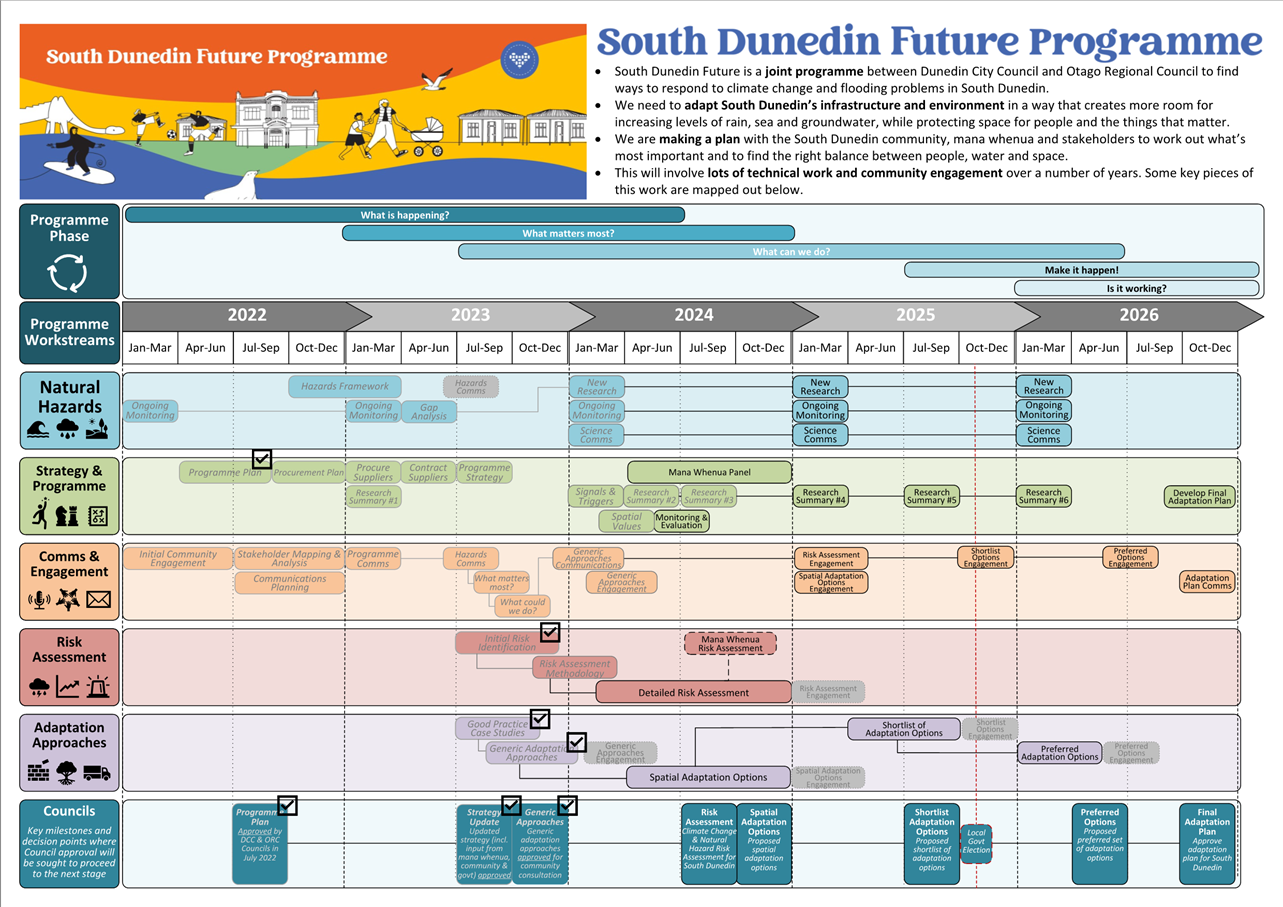
|

|
Council
24 September 2024
|
Submission on A New Strategy to Prevent and Minimise
Gambling Harm
Department: Corporate Policy and Civic
EXECUTIVE SUMMARY
1 This
report seeks approval of a draft Dunedin City Council (DCC) submission
(Attachment A) to the Ministry of Health Manatū Hauora (the Ministry of
Health) on a draft Strategy to Prevent and Minimise Gambling Harm (Attachment B).
2 The
draft Strategy to Prevent and Minimise Gambling Harm 2025/26 to 2027/28 (the
draft Strategy) includes:
· the problem
definition and needs assessment which informs the proposed Strategy
· the strategic plan
and framework with the goals, outcomes, priorities, and actions
· the service plan
for the three years from 2025/26 to 2027/28
· the problem
gambling levy rates and weighting options for the next three years.
3 The
draft DCC submission focuses on the service delivery aspects of the draft
Strategy.
4 Consultation
on the draft Strategy opened on 23 August 2024 and closes on 6 October 2024.
RECOMMENDATIONS
That the Council:
a) Approves the draft
Dunedin City Council submission, with any amendments, to the Ministry of Health
Manatū
Hauora on a New Strategy to Prevent and Minimise Gambling Harm.
b) Authorises the Chief
Executive to make any minor editorial amendments to the submission.
c) Notes that the Mayor
or delegate will speak to any hearings in regard to the submission.
BACKGROUND
DCC’s commitment to
reducing gambling harm
5 The
DCC has shown a long-term and ongoing commitment to reducing gambling harm
through its Gambling and TAB Venue Policy (the Policy) which took effect on 14
April 2021 and takes a sinking lid approach to the number of venues and
gambling machines in Ōtepoti Dunedin. The Policy meets the DCC’s
obligations under the Gambling Act 2003 and the Racing Industry Act 2020.
6 The
Policy was last reviewed and approved by Council in April 2024 and aims to:
· prevent and
minimise the harm caused by gambling to the community; and,
· ensure the views
of the DCC and the community are reflected in the provisions of the policy;
and,
· allow those who
wish to participate in class 4 gambling in the community to do so safely and
responsibly.
7 The
DCC has previously submitted on other gambling consultations on proposals under
development for performance-based class 4 licensing in February 2023 and on
reducing pokies harm in April 2022. Both consultations were undertaken by the
Department of Internal Affairs (DIA).
8 Most
recently, in May 2024, the DCC submitted to the New Zealand Gambling Commission
in support of license renewal for Dunedin Casinos Limited, which operates the
city’s sole casino.
Wider local
context
9 The
DIA collects quarterly statistics on the number of class 4 gambling venues and
machines in each of New Zealand’s Territorial Authorities. As of June
2024, there were 25 venues in Ōtepoti Dunedin, operating a total of 297
electronic gaming machines and 43 jackpot machines.
10 In 2023, a
procurement process undertaken by Health New Zealand (Health NZ) led to
services to prevent and minimise gambling harm being significantly reduced in Ōtepoti
Dunedin. After 31 January 2024, the Salvation Army’s Oasis programme was
closed completely, and the Problem Gambling Foundation now has only one staff
member based in the city.
11 Te Kāika
is the local provider for Multi-Venue Exclusion, which is an intervention tool
that enables gamblers to self-exclude from multiple venues without having to
visit each individual site. This provides one coordinator role which covers Ōtepoti
Dunedin and the rest of Otago.
DISCUSSION
12 DCC staff
attended a webinar on 11 September 2024 held as part of the consultation on the
draft Strategy. The webinar was focused on service provision. In response to a
question from the DCC about how budget and resources would be allocated at a
regional and local level, Health NZ responded that it will be based on
“need’ and “data”.
13 At this
webinar, the DCC also asked if there be any reinstatement of services that
ceased in January 2024, and how any gaps that have arisen between then and the
new Strategy being implemented in July 2025 will be addressed. Health NZ
responded that the new suite of services will continue, and any gaps will be
identified and addressed (for example, face-to-face clinical services).
14 The draft
submission was developed by the Corporate Policy team and the Alcohol,
Psychoactive Drugs and Gambling Advisor.
The draft DCC
Submission
15 The draft DCC
submission is written in the context of reduced gambling harm services in Ōtepoti
Dunedin since February 2024.
16 The draft submission
supports intentions of the draft Strategy, but queries aspects of its implementation,
including how:
· goals in the draft
Strategy will be implemented within the proposed timeframes
· service delivery
capacity and competency will be sufficient to achieve the goals
· local needs and
resourcing are allocated, including the balance between in-person and online
service delivery
· how people with
lived experience will be included, and peer support training delivered, when
based in Ōtepoti Dunedin.
17 In its
draft submission, the DCC requests any information about any future procurement
processes for service delivery, including scope and timeframes.
18 The draft
submission requests that sections of previous strategies regarding the Treaty
of Waitangi, which have been removed from the draft Strategy, are replaced.
19 Through
this consultation process, the Government is socialising its plans to regulate
online casinos through a licensing system expected to come into effect in 2026.
The draft submission supports these plans.
OPTIONS
Option One – Recommended Option – Approve the
draft submission
20 Under this
option, Council approves the draft DCC submission to the Ministry of Health on
its draft Strategy to Prevent and Minimise Gambling Harm, with any agreed
amendments.
Advantages
· Opportunity
to demonstrate the DCC’s commitment to preventing and minimising gambling
harm.
· Opportunity
to demonstrate the DCC’s commitment to the wellbeing of the people of Ōtepoti
Dunedin.
· Opportunity
to advocate for inclusion of the Treaty of Waitangi as a principle.
Disadvantages
· There
are no identified disadvantages for this option.
Option Two – Do not approve the draft submission
21 Under this
option, Council does not approve the draft DCC submission to the Ministry of
Health on its Strategy to Prevent and Minimise Gambling Harm
Advantages
· There
are no identified advantages for this option.
Disadvantages
· Missed
opportunity to demonstrate the DCC’s commitment to preventing and
minimising gambling harm.
· Missed
opportunity to demonstrate the DCC’s commitment to the wellbeing of the
people of Ōtepoti Dunedin.
· Missed
opportunity to advocate for inclusion of the Treaty of Waitangi as a principle.
NEXT STEPS
22 If Council
approves the draft submission, it will be sent to the Ministry of Health for
consideration prior to the closing date of 6 October 2024.
Signatories
|
Author:
|
Danielle Tolson - Policy Analyst
Kevin Mechen - Alcohol, Psychoactive Substances and
Gambling Advisor
|
|
Authoriser:
|
Junichi Sugishita - Senior Policy Analyst
Robert West - General Manager Corporate Services
|
Attachments
|
|
Title
|
Page
|
|
⇩a
|
Draft DCC submission on
the draft Strategy to Prevent and Minimise Gambling Harm
|
167
|
|
⇩b
|
Consultation document-
Strategy to Prevent and Minimise Gambling Harm 2025/26 to 27/28
|
169
|
|
SUMMARY OF CONSIDERATIONS
|
|
Fit with purpose of Local Government
This decision promotes the social
well-being of communities in the present and for the future.
|
|
Fit with strategic framework
|
|
Contributes
|
Detracts
|
Not applicable
|
|
Social Wellbeing Strategy
|
✔
|
☐
|
☐
|
|
Economic Development Strategy
|
☐
|
☐
|
✔
|
|
Environment Strategy
|
☐
|
☐
|
✔
|
|
Arts and Culture Strategy
|
☐
|
☐
|
✔
|
|
3 Waters Strategy
|
☐
|
☐
|
✔
|
|
Future Development Strategy
|
☐
|
☐
|
✔
|
|
Integrated Transport Strategy
|
☐
|
☐
|
✔
|
|
Parks and Recreation Strategy
|
☐
|
☐
|
✔
|
|
Other strategic projects/policies/plans
|
✔
|
☐
|
☐
|
The submission aligns with the DCC’s Gambling and
TAB Venues Policy and Te Taki Haruru — Māori Strategic Framework.
|
|
Māori Impact Statement
Ministry of Health 2024/25 data states Māori were
3.13 times more likely to be moderate-risk or problem gamblers than
non-Māori and non-Pacific peoples. In the Māori adult population,
approximately 3.7 percent were moderate-risk or problem gamblers, and 5.7
percent were low-risk gamblers. By reducing harm from problem gambling, the
Crown is more effectively meeting its obligations under the Treaty of
Waitangi. Article Two of the Treaty of Waitangi guarantees Māori
authority over their taonga, including their hauora (health).
The DCC’s Te Taki Haruru — Māori
Strategic Framework includes the principle of Autaketake and its values of
tapu and noa. Its key directions include: Communities, resources and
customary practices are protected through responsible regulatory measures and
processes, and that we are guides by tikaka and kawa (protocol) for the
wellbeing of whānau and wider community.
The draft Strategy does not
include any reference to the Treaty of Waitangi. The Treaty was included as a
principle in the previous strategy, along with its role in the health and
disability system. The DCC submission requests that these be included in the
draft Strategy.
|
|
Sustainability
There are no implications for sustainability.
|
|
LTP/Annual Plan / Financial Strategy /Infrastructure
Strategy
There are no implications for the LTP, Annual Plan,
Financial Strategy or Infrastructure Strategy.
|
|
Financial considerations
There are no financial implications.
|
|
Significance
This decision is considered of low significance in terms of
the Council’s Significance and Engagement Policy.
|
|
Engagement – external
There has been engagement with the Problem Gambling
Foundation in the preparation of this submission.
|
|
Engagement - internal
This submission was developed by the Corporate Policy team
and the Alcohol, Psychoactive Drugs and Gambling Advisor.
|
|
Risks: Legal / Health and Safety etc.
There are no identified risks.
|
|
Conflict of Interest
There is no conflict of interest.
|
|
Community Boards
There are potential implications for Community Boards as gambling
activities occur in these areas.
|
|

|
Council
24 September 2024
|
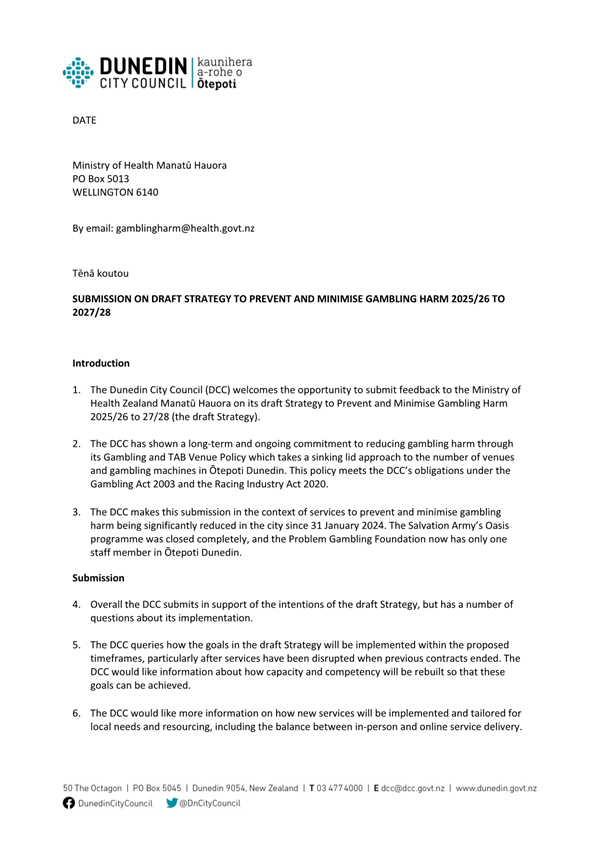
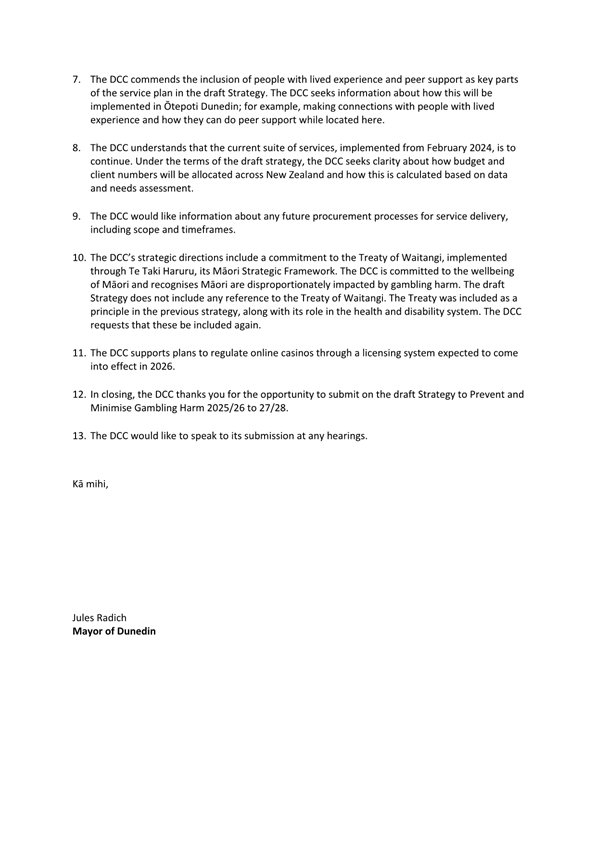
|

|
Council
24 September 2024
|
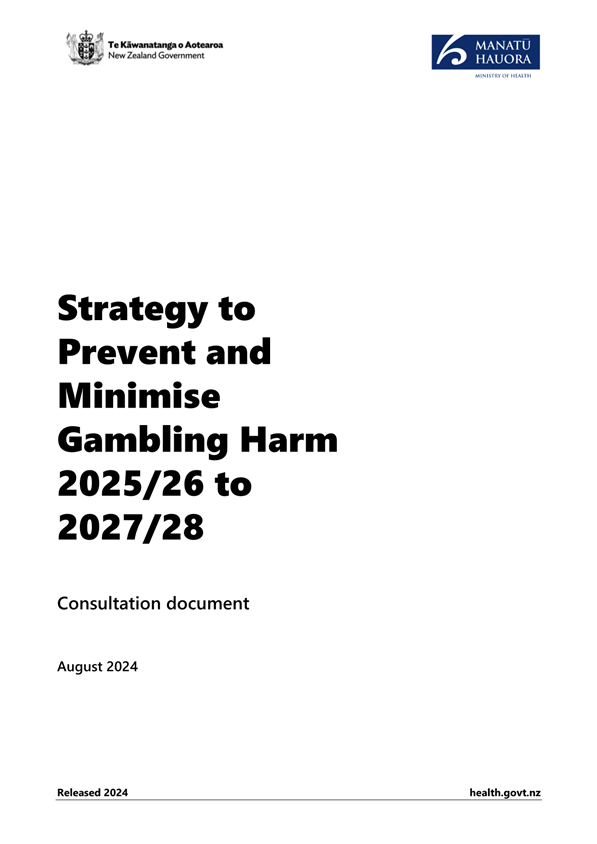
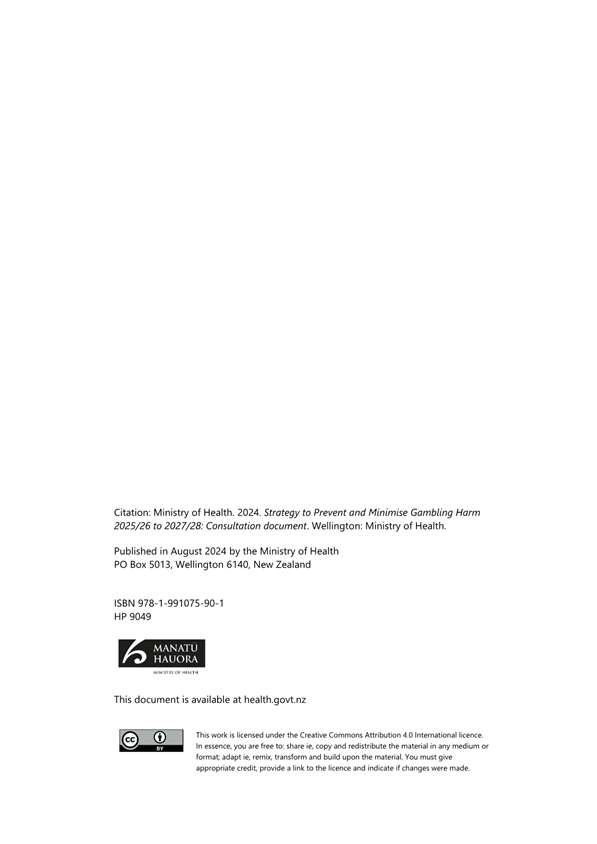
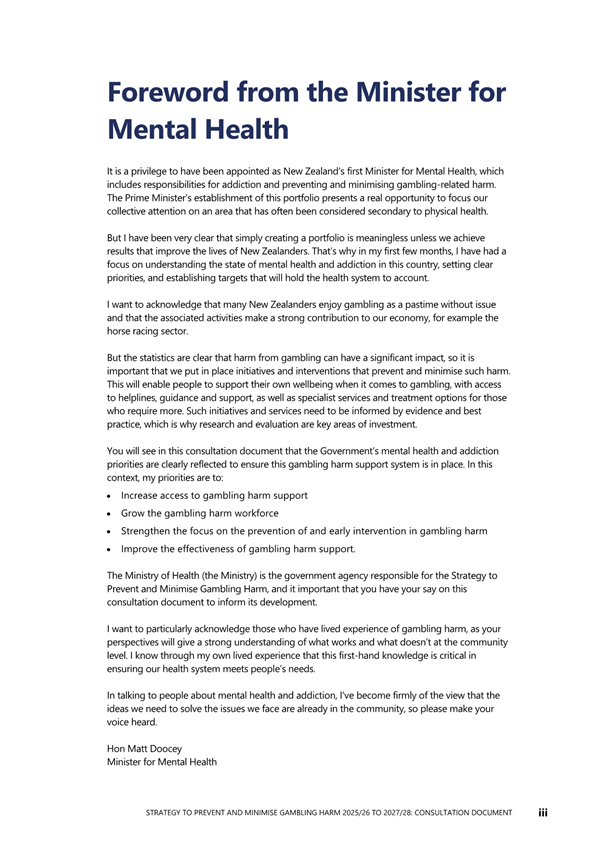
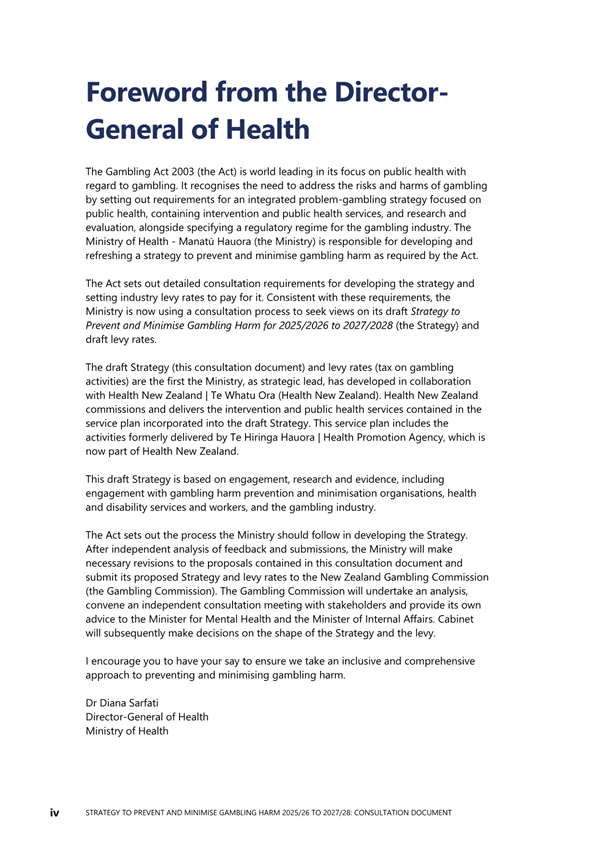
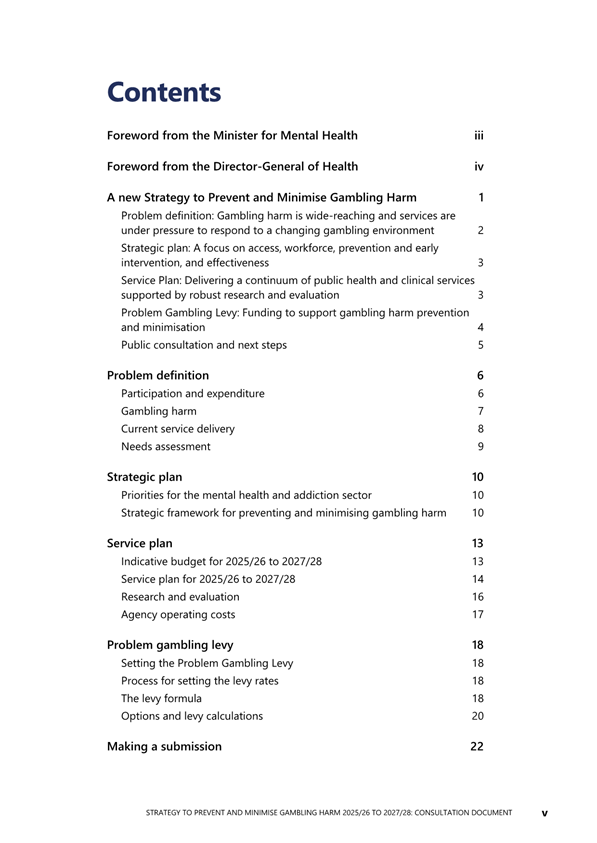
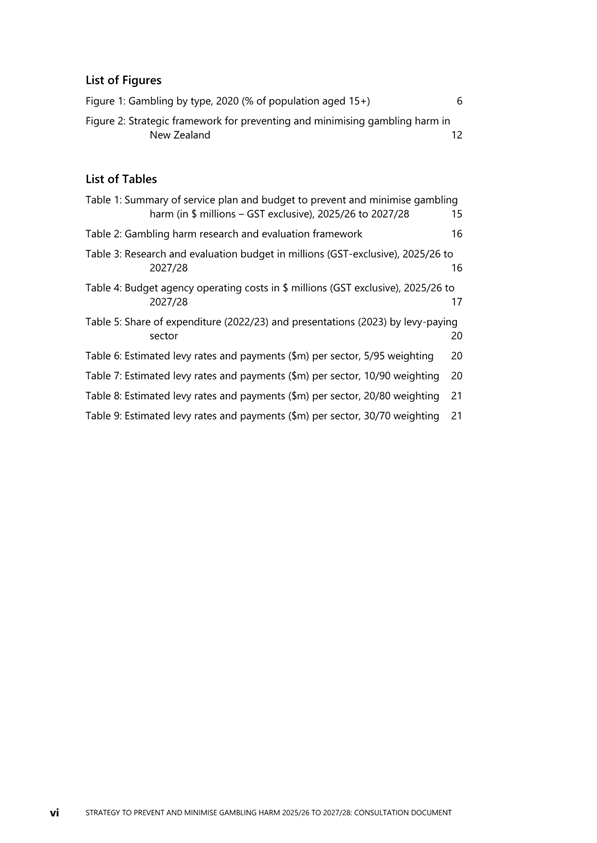
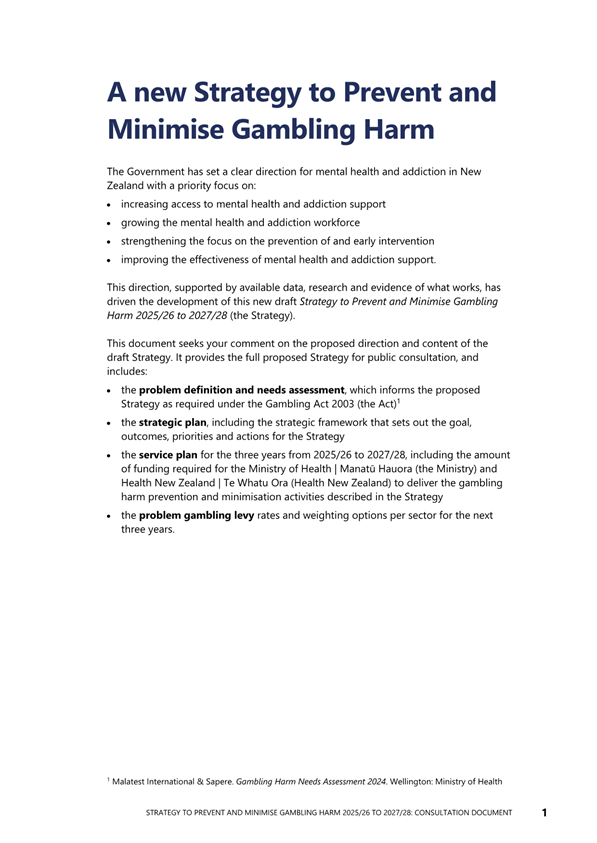

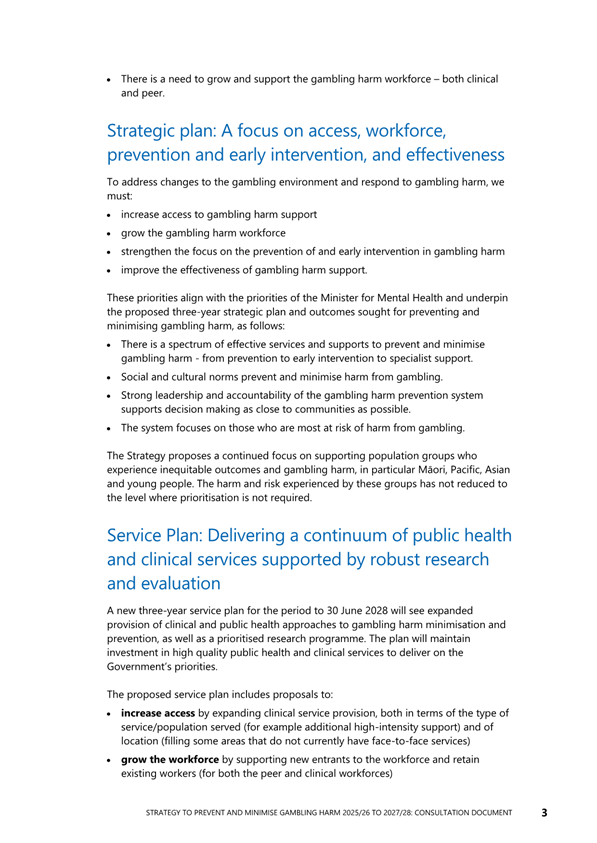

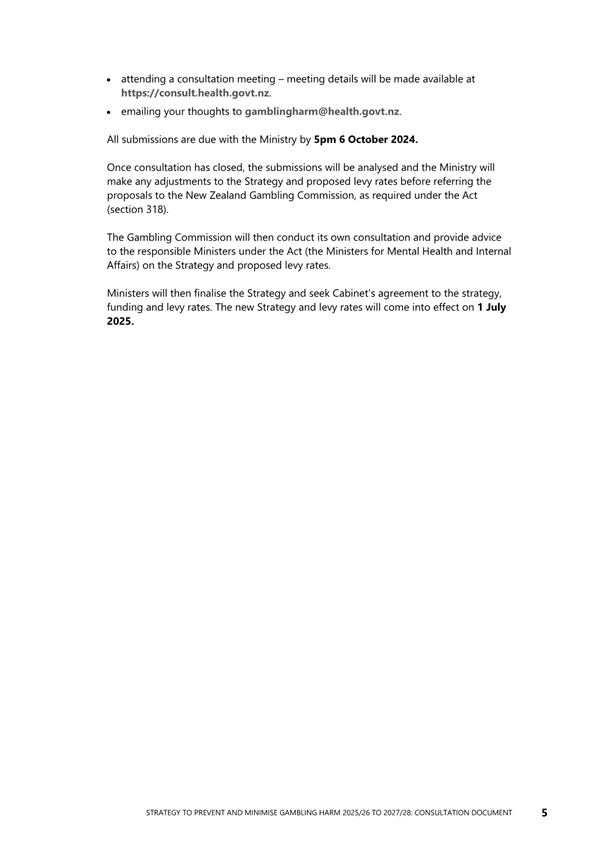
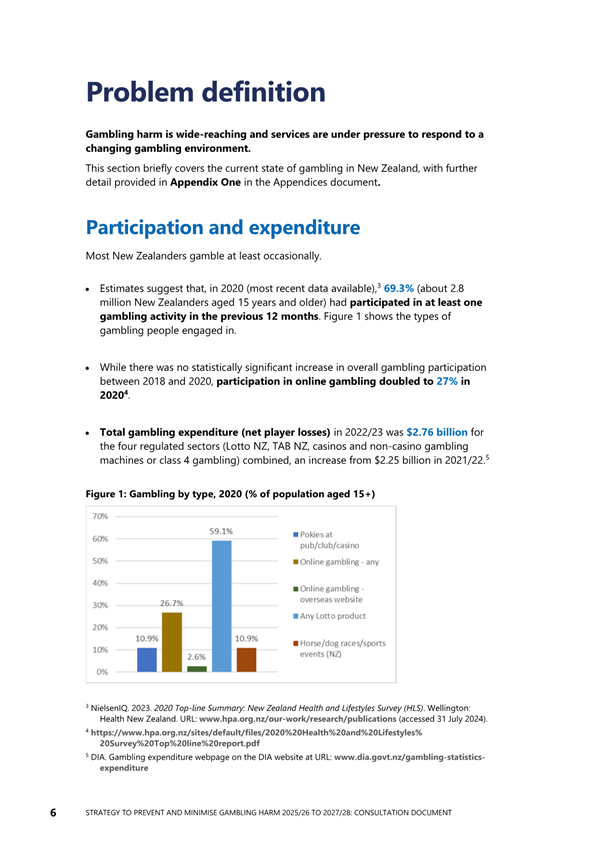


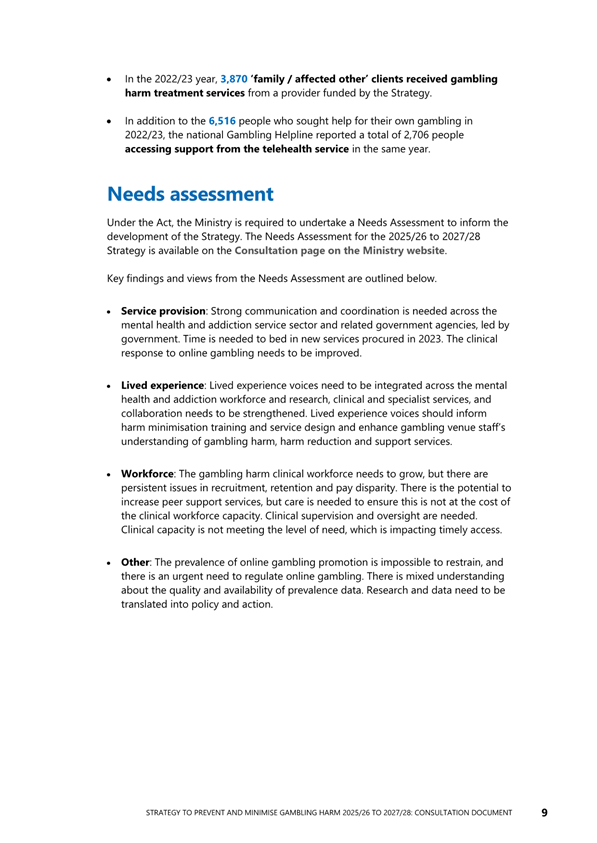

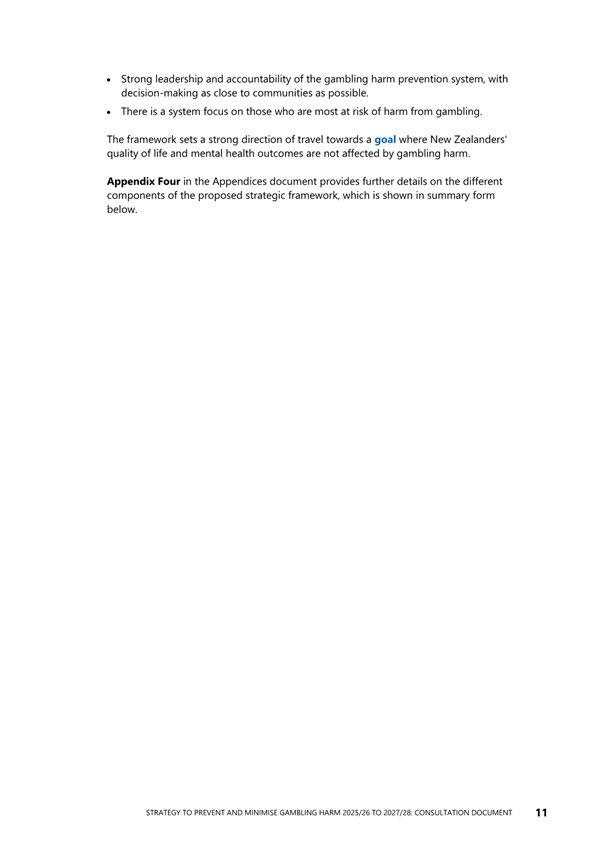
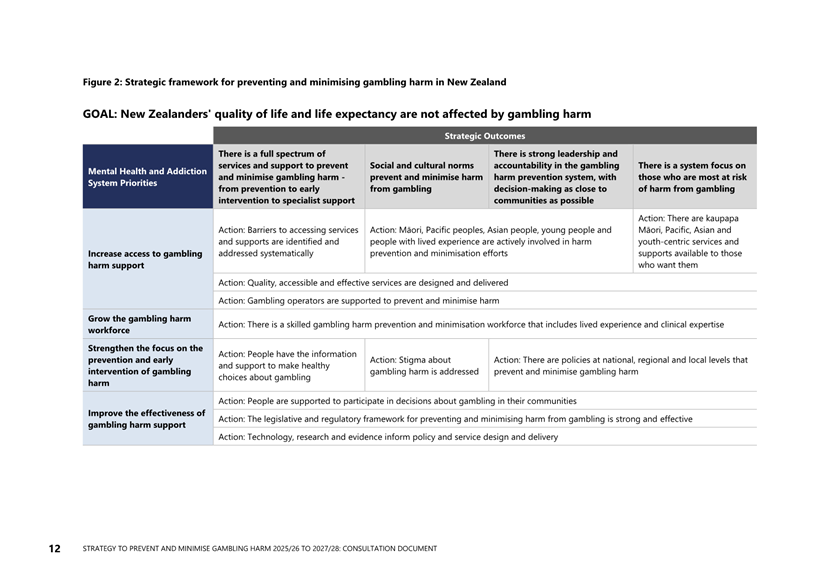
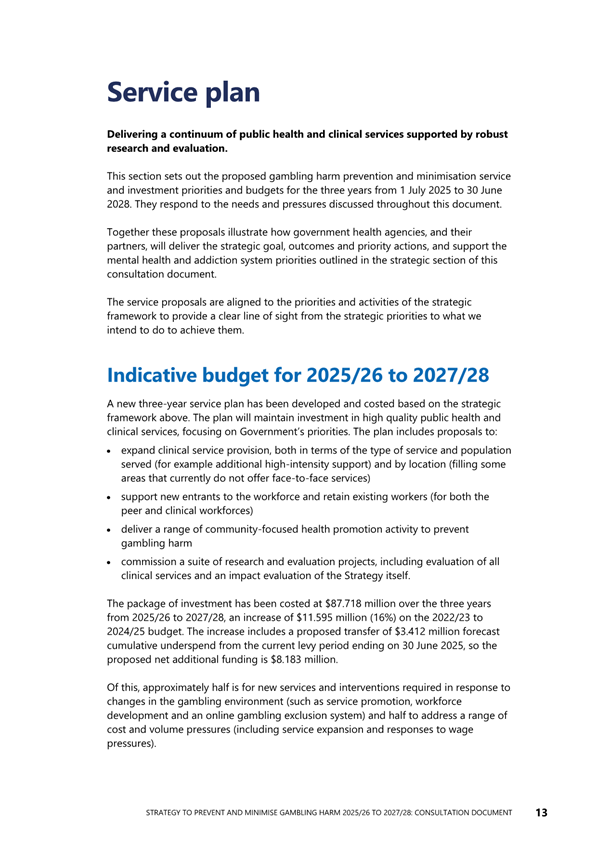

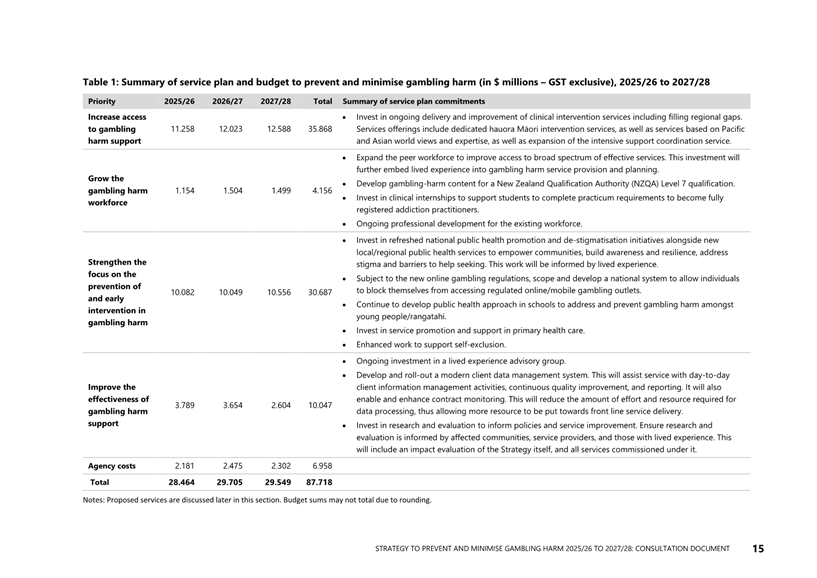
|

|
Council
24 September 2024
|
Litter Compliance Policy 2024
Department: Waste and Environmental Solutions
EXECUTIVE SUMMARY
1 The
Dunedin City Council’s current Litter Compliance Policy was approved on
25 May 2021 and was due for review on 1 July 2024. The review was carried out,
and the resulting draft Litter Compliance Policy 2024 was approved for public
notification on 31 July 2024.
2 Public
notification has been carried out. The draft Litter Compliance Policy 2024 has
been amended according to the feedback received, as presented in this report.
This report is seeking Council approval to adopt the revised Policy.
3 Territorial
authorities can adopt infringement notice provisions (in this instance, in the
form of a Litter Compliance Policy) under the Litter Act 1979. This empowers
the authority to infringe and charge for incidents of litter and illegal
dumping.
4 The
purpose of the Policy is to ensure that Ōtepoti Dunedin residents
wellbeing and environment remains protected from harm by minimising the
negative effects of littering and illegal dumping/fly tipping.
5 The
Policy adopts the penalties and enforcement provisions prescribed by the Litter
Act 1979 (The Act). Since the legislation has remained the same, only minor
changes to the Policy have been made during this review.
6 The
Policy has been updated to reflect the new kerbside collection services, in
line with provisions set out in the Act, and amendments made to remove the
requirement to prove intent in committing some offences which had been
incorrectly referenced in the earlier policy.
7 Further
changes have been made to the Policy to improve details for compliance for
collection services following the public notification period.
RECOMMENDATIONS
That the Council:
a) Revokes the existing
Litter Compliance Policy 2021
b) Adopts the proposed
Litter Compliance Policy 2024
BACKGROUND
1 The
Act provides for a Council to adopt infringement provisions for breaches of the
Act, only after it has given at least 14-days’ notice of its intention to
do so. This public notification period was carried out from 10 August and ended
on 27 August, and the policy has been amended in response to the feedback
received.
2 The
existing Policy needed to be updated to reflect the new kerbside collection
services which began in July 2024.
3 The
draft policy was presented to Council on 31 July 2024 and was approved for
public notification. This public notification period has been completed.
|
|
Moved (Mayor Jules Radich/Cr
Christine Garey):
That the Council:
a) Approves the proposed Litter Compliance Policy
2024 for public notification with intention to adopt.
b) Notes a 14-day public notification period was
required to adopt the infringements set out in the proposed Litter Compliance
Policy 2024.
Motion
carried (CNL/2024/001)
|
DISCUSSION
4 Littering
and illegal dumping incidents cause environmental effects that impact on
communities and ecological systems including the contamination of land,
waterways, and the ocean.
5 The
DCC regularly receives reports of littering and illegal dumping events.
Residents, businesses, and visitors to Dunedin often request that the DCC do
more to address these issues.
6 Rubbish
can escape from properties during high winds and heavy rain, as well as
attracting animal scavengers. In the worst cases rubbish stockpiles can become
potential health hazards.
7 In
recognition of the Council’s ongoing commitment to the Sophia Charter DCC
staff have reviewed the Policy in alignment with the new kerbside collection
services. This supports progress for the Sophia Charter by aligning with the
Charter’s goal:
“Our goal is that North
Dunedin is a strong student neighbourhood where residents take responsibility
for themselves, each other, and the wider community; it will be a place that is
fun, vibrant, safe, and secure and that fosters student success and wellbeing.”
8 The
suggested amendments will assist the DCC in creating a cleaner and safer
environment.
9 The
review offers to ease the issuing of infringement notices and charging for
offenses by removing the requirement to prove intent which had been incorrectly
referenced in the earlier policy.
10 The final
proposed policy is attached to this report (Attachment A: Final Litter
Compliance Policy 2024). Amendments have been made according to feedback
received during the public notification period. These amendments are provided
in orange.
11 It should
be noted that littering or illegal dumping on private land is only an offence
under the Act if it is done without the consent of the occupier. In these
cases, before the DCC could issue an infringement, it would have to contact the
occupier and confirm that the litter or dumped items had been left on their
property without the occupier’s permission. Where an occupier has given
consent, the DCC can issue a Notice to Clear Litter and may pursue enforcement
by issuing an infringement if the occupier fails to comply with the Notice.
12 Since
littering or illegal dumping on private land is only an offence under the Act
if it is done without the consent of the occupier, contamination of recycling
bins is not able to be regulated under this Policy. Regulating against
contamination of recycling or composting would require the authority to adopt a
bylaw under section 56 of the Waste Minimisation Act 2008.
Litter Compliance Policy
Amendments
The proposed Litter Compliance
Policy 2024 includes the amendments described below and new infringement
offences for breaches of the Act. The amendments in italics are the
changes made following the public notification period:
· Altered the
time that rubbish and recycling bins can be left out in the Central Business
District for collection, to suit collection services.
· Altered the
size of cardboard bundles for collection in the Central Business District to
improve safety for the kerbside collection services.
· Removed the
requirement to prove intent of committing an offence (Litter Act 1979 Section
19A).
· Use of containers
other than the official bins for DCC’s or other private companies’
collection services.
· Overfilled, or
bins that weigh too much.
· Any organic
material put out for collection which is not contained by the bins for the
collection service. This is then treated as litter left in public places.
· The infringement
fee for a second or subsequent offence of littering (single item) has been
decreased to $200, to bring it into scale with the infringement fees for larger
quantities of litter.
OPTIONS
Option One – Recommended Option
13 Council
approves the proposed Litter Compliance Policy 2024 for adoption.
Advantages
· Provides
for a clear and transparent process for managing litter offences.
· Provides
a consistent enforcement approach for Council to use in dealing with littering
and illegal dumping events.
· Updates
the existing Litter Compliance Policy 2021 to suit the new kerbside collection
services.
Disadvantages
· Additional
resource may be required to enforce the Policy.
Option Two – Status Quo
14 Council
does not adopt the proposed Litter Compliance Policy 2024.
Advantages
· No
change made to Council policies.
· No
additional resource required to enforce the Policy.
Disadvantages
· Limits
Council’s ability to address litter and illegal dumping of waste.
NEXT STEPS
15 The
existing Policy will be replaced by the new Policy on the Dunedin City Council
website, and communications will be arranged to let the public and key
stakeholders know the new Policy has been adopted.
Signatories
|
Author:
|
Leigh McKenzie - Waste Minimisation Officer, Waste and
Environmental Solutions
|
|
Authoriser:
|
Chris Henderson - Group Manager Waste and Environmental Solutions
Scott MacLean - General Manager, Climate and City Growth
|
Attachments
|
|
Title
|
Page
|
|
⇩a
|
Final Litter Compliance
Policy 2024
|
211
|
|
SUMMARY OF CONSIDERATIONS
|
|
Fit with purpose of Local Government
This decision enables democratic local
decision making and action by, and on behalf of communities, promotes the
social, environmental, and cultural well-being of communities in the present
and for the future.
|
|
Fit with strategic framework
|
|
Contributes
|
Detracts
|
Not applicable
|
|
Social Wellbeing Strategy
|
✔
|
☐
|
☐
|
|
Economic Development Strategy
|
☐
|
☐
|
✔
|
|
Environment Strategy
|
✔
|
☐
|
☐
|
|
Arts and Culture Strategy
|
☐
|
☐
|
✔
|
|
3 Waters Strategy
|
☐
|
☐
|
✔
|
|
Future Development Strategy
|
☐
|
☐
|
✔
|
|
Integrated Transport Strategy
|
☐
|
☐
|
✔
|
|
Parks and Recreation Strategy
|
✔
|
☐
|
☐
|
|
Other strategic projects/policies/plans
|
✔
|
☐
|
☐
|
Waste Management and Minimisation Plan (2020)
|
|
Māori Impact Statement
Through Te Taki Haruru, mana whenua have provided two key
intents that strongly align with the Litter Compliance Policy. The Policy
aims to positively increase the environmental mauri of Ōtepoti Dunedin
by ensuring it is kept clean through litter monitoring and implementing
educational and punitive measures for those liable. Additionally, the
utilisation of tapu and noa aims to make Ōtepoti Dunedin as healthy and
safe as possible by having processes in place for dumped litter that is
hazardous or dangerous.
|
|
Sustainability
Improved regulation of litter and illegal dumping which
harm the environment.
|
|
LTP/Annual Plan / Financial Strategy /Infrastructure
Strategy
No implications.
|
|
Financial considerations
No implications.
|
|
Significance
This report is considered to be low
significance in terms of the Council’s Significance and Engagement
Policy.
|
|
Engagement – external
The Litter Compliance Policy was publicly notified. The
Sustainability Office and Proctor at the University of Otago were
engaged. During the public notification period, feedback was received
from a commercial collection company, and amendments have been made
accordingly.
|
|
Engagement - internal
Engagement meetings were held with Waste and Environmental
Solutions, Corporate Policy, the Legal Team, and the Māori Partnerships
Team to ensure the amended Litter Compliance Policy is correct and
complementary to the DCC’s other work streams. During the public
notification period, further feedback was received from Waste and
Environmental Solutions staff, and amendments have been made accordingly.
|
|
Risks: Legal / Health and Safety etc.
DCC in-house legal counsel were consulted during the
policy review process. No risks have been identified.
|
|
Conflict of Interest
No conflicts have been identified.
|
|
Community Boards
There are no implications for Community Boards.
|
|

|
Council
24 September 2024
|
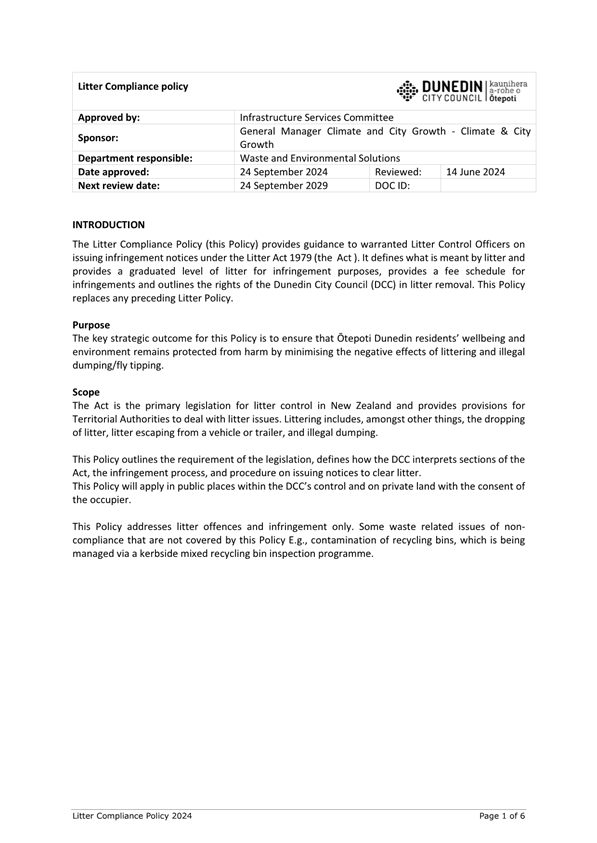
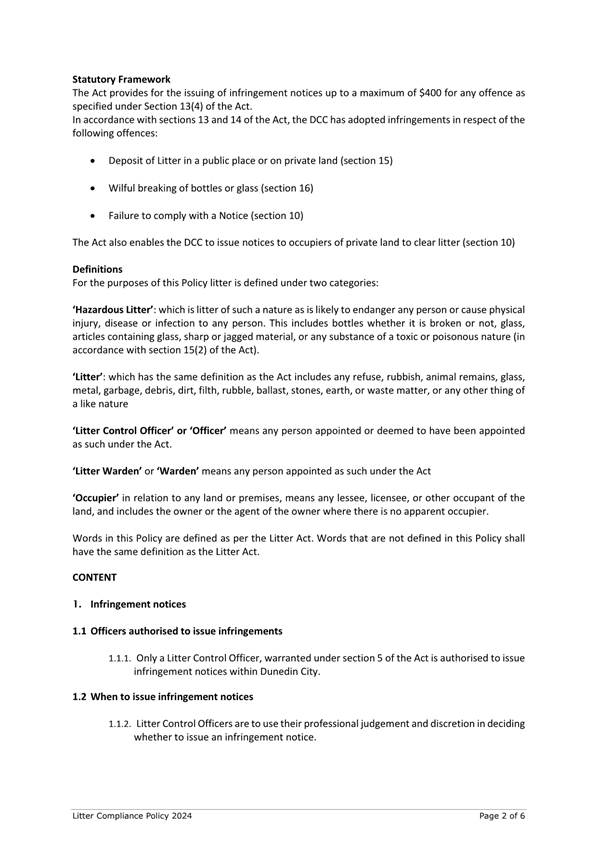
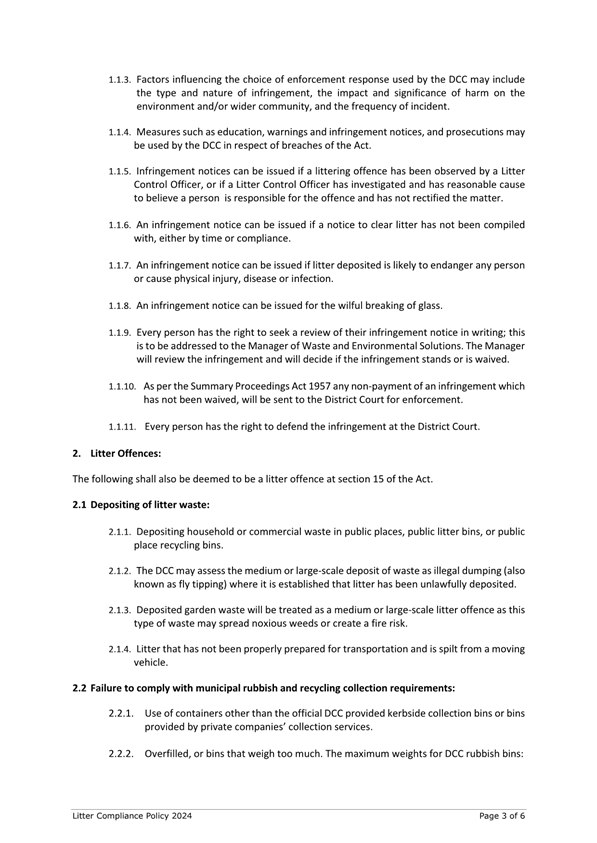
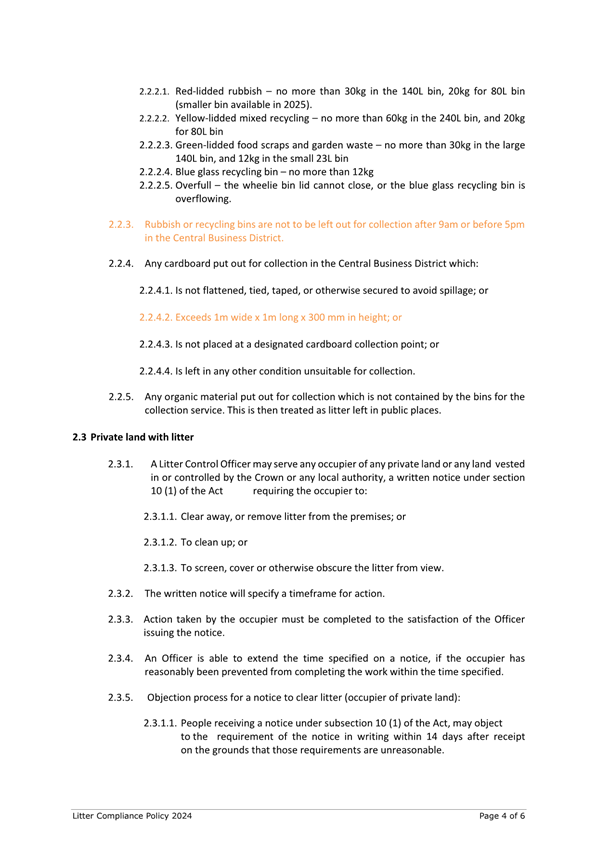
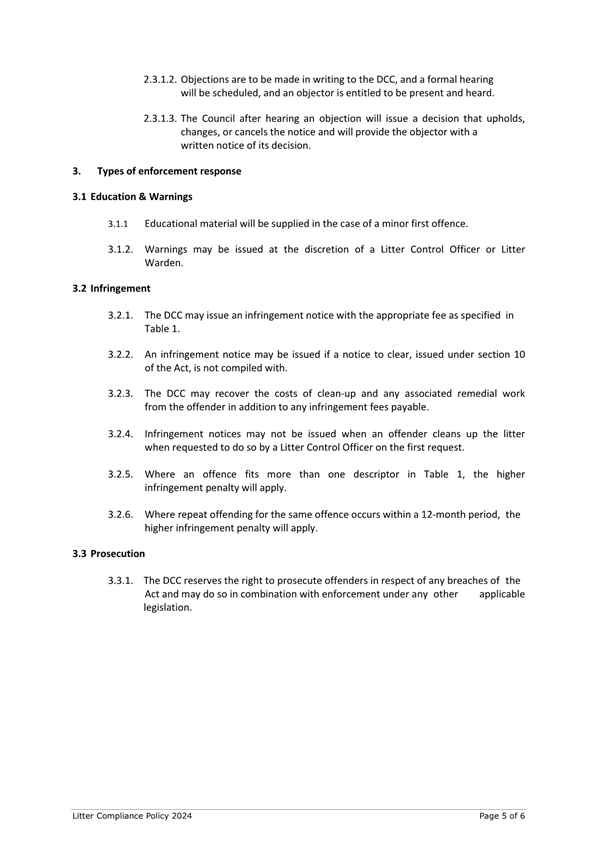

|

|
Council
24 September 2024
|
Submission on the Otago Regional Council Air Quality
Management Review
Department: Corporate Policy
EXECUTIVE SUMMARY
1 This
report seeks Council approval of a draft Dunedin City Council (DCC) submission
(Attachment A) to the Otago Regional Council on the Air Quality Management
Review. The ORC presentation on approaches to improving air quality is attached
as Attachment B.
2 The
ORC is seeking feedback on the four key factors challenging air quality in Otago
as well as identified approach to address these.
3 The
DCC’s draft submission supports the ORC’s general approach and raises
some specific points of attention related to DCC’s commitment to the
Treaty of Waitangi, waste management, home heating and transport.
RECOMMENDATIONS
That the Council:
a) Approves the draft DCC
submission, with any amendments, on the Otago Regional Council on the Air
Quality Management Review.
b) Authorises the Chief
Executive to make any minor editorial changes to the submission if required.
BACKGROUND
Overview of air quality management in Otago and
background of the Review
4 The
Resource Management Act 1991 requires regional councils to manage air quality.
In Otago, the ORC ensures National Environmental Standards for Air Quality 2004
(NESAQ) – which set the limits on pollution for the protection of human
health – are met while also ensuring overall air quality is well managed.
An air quality monitoring network focuses on areas with poor air quality and
areas that require improvement.
5 The
ORC carries out science, monitoring and compliance activities and sets rules
for air quality in the Regional Plan: Air, which is due for review. The ORC
took this opportunity to conduct a more comprehensive review of air quality
management in Otago.
6 DCC
staff were involved in a stakeholder focus group on air quality dedicated to territorial
authorities, held on 2 September as part of the public engagement on the Air
Quality Management Review. The ORC will collate and analyse the information
received, along with feedback from public engagement, and prepare a report to
Council.
7 The
ORC anticipates that this will include a new Air Strategy and Otago Air
Regional Plan, with the plan to be notified in June 2025.
Air quality
challenges and options identified by the ORC
8 In
Otago, the ORC worked with the Southern District Health Board (SDHB) in 2022 to
show that higher matter concentrations in the air increased the risk of
acute respiratory infections, highlighting the risk of even short-term
exposure. Some areas of Otago are not meeting the current NESAQ guidelines. Air
quality can be especially poor because of the unique climate and landscape.
9 Dunedin
city has met the NESAQ for the past five years, and has relatively good air
quality year-round, although emissions can accumulate in some of the valley
areas (Source: Land Air Water Aotearoa).
10 The key
source of air pollution in Otago are listed below, alongside potential
corrective actions proposed by the ORC:
· Home heating:
potential approaches include requiring all new installations of solid fuel
burners to meet ultra-low emission burner criteria, phasing out the burning of
coal for home heating, working with power suppliers to improve the reliability
and affordability of electrical heating appliances, providing financial support
to help Otago homeowners replace higher emitting solid-fuel burners, education
programmes about wood burner best practice.
· Outdoor burning:
potential approaches include preventing outdoor
burning during winter months (April–September), requiring smoke
management plans for large-scale/long-lasting outdoor burning, preventing
outdoor burning on properties smaller than 2 hectares, requiring alternatives
to burning where practicable (e.g., composting, mulching) and education
programmes.
· Vehicle
emissions: potential approaches include creating policies that recognise
the effects of nitrogen dioxide emissions and focus on reducing those
emissions, improving public transport to reduce reliance on private vehicles,
decarbonising ORC’s fleet vehicles and buses, joint education campaigns
with city/district councils.
· Industrial
emissions, odour, dust, and agricultural spraying: potential approaches
include strengthening existing rules, requiring resource consent applications
for discharges to air to use the best practicable option test to avoid or
minimise adverse effects on air quality, ensuring adequate setbacks or buffer
zones, requiring dust or odour management plans (currently used in Canterbury),
providing information about FIDOL (frequency, intensity, duration,
offensiveness, and location) assessments to complainants and emitters
(currently used in Nelson and Canterbury).
DISCUSSION
11 The draft
DCC submission was prepared by Corporate Policy with input from Zero Carbon, Waste
Management, Housing, Māori Partnership, Transport and City Development
teams. Feedback from Councillors have been incorporated into the draft
submission.
12 In the
draft submission:
· Regarding mana whenua engagement: the
DCC notes that te ao Māori informing policies and plans is an
important goal for mana whenua and is relevant with section 7.1 of the current
Plan and Part II of the Resource Management Act 1991.
· Regarding
outdoor burning: the DCC notes that extension of waste collection into rural
areas where most of the outdoor burning occurs would be unrealistic and
uneconomic. The DCC supports education campaigns and alternatives to burning
where practicable (e.g., composting, mulching).
· Regarding
home heating: the DCC supports phasing out of coal burning and replacing
poor performing heat sources and encouraging the use of alternatives. The DCC
also proposes a system of warnings or fines to be
issued if residents continue to use solid fuel burners for which issues have
been identified (e.g. after a complaint) and not fixed.
· Regarding
transport: the DCC supports an increase in reliable
and affordable public transport notably to enable mana whenua to live within
their papakāika/communal Māori land, while staying connected to the
central city without needing to rely on private vehicles. The DCC would also
support measures to reduce vehicle idling.
OPTIONS
Option One – Recommended Option – Approve the
draft submission
13 Under this
option, Council approves the draft DCC submission to ORC on the new approach to
Air Quality Management.
Advantages
· Enables
the DCC to provide input into the ORC’s approach to Air Quality
Management and advocate for quality air in Dunedin.
· Enables
the DCC to demonstrate the DCC’s commitment to the Treaty of Waitangi.
· Enables
the DCC to support approaches that align with its Zero Carbon target.
Disadvantages
· There
are no identified disadvantages to this option.
Option Two – Do not approve the submission
14 Under this
option, Council does not approve the draft DCC submission to ORC on the new
approach to Air Quality Management.
Advantages
· There
are no identified advantages for this option.
Disadvantages
· Missed
opportunity to provide input into the ORC’s approach to Air Quality
Management and advocate for quality air in Dunedin.
· Missed
opportunity to demonstrate the DCC’s commitment to the Treaty of Waitangi.
· Missed
opportunity to support approaches that align with its Zero Carbon target.
NEXT STEPS
15 If Council
approves the draft submission, staff will submit it, with any amendments, to
the ORC.
Signatories
|
Author:
|
Alix de Blic - Senior Policy Analyst
|
|
Authoriser:
|
Scott MacLean - General Manager, Climate and City Growth
|
Attachments
|
|
Title
|
Page
|
|
⇩a
|
Submission on the ORC's
Air Quality Management Review
|
223
|
|
⇩b
|
ORC Air Quality
presentation
|
226
|
|
SUMMARY OF CONSIDERATIONS
|
|
Fit with purpose of Local Government
This decision enables democratic local
decision making and action by, and on behalf of communities.
This decision promotes the environmental
well-being of communities in the present and for the future.
|
|
Fit with strategic framework
|
|
Contributes
|
Detracts
|
Not applicable
|
|
Social Wellbeing Strategy
|
☐
|
☐
|
✔
|
|
Economic Development Strategy
|
☐
|
☐
|
✔
|
|
Environment Strategy
|
✔
|
☐
|
☐
|
|
Arts and Culture Strategy
|
☐
|
☐
|
✔
|
|
3 Waters Strategy
|
☐
|
☐
|
✔
|
|
Future Development Strategy
|
✔
|
☐
|
☐
|
|
Integrated Transport Strategy
|
✔
|
☐
|
☐
|
|
Parks and Recreation Strategy
|
☐
|
☐
|
✔
|
|
Other strategic projects/policies/plans
|
✔
|
☐
|
☐
|
The ORC Air Management Plan and Strategy could have
implications for Treaty of Waitangi obligations and impacts on the
DCC’s ability to achieve its Zero Carbon 2030 Goal.
The submission aligns with the DCC Zero Carbon Plan and Te
Taki Haruru – Māori Strategic Framework.
|
|
Māori Impact Statement
The DCC has a Treaty of Waitangi commitment to working in
partnership to provide opportunities for Māori to contribute to
decision-making processes and to have an active role through Te Taki Haruru.
The submission notes that te ao Māori
informing policies and plans is an important goal for mana whenua and is
relevant with section 7.1 of the current Plan and Part II of the Resource
Management Act 1991. The submission also supports an increase in reliable and affordable public transport
notably to enable mana whenua to live within their papakāika/communal
Māori land.
|
|
Sustainability
The quality of air is an important component of a
sustainable future as bad air quality has impacts on human and animal health
as well as biodiversity in general.
|
|
LTP/Annual Plan / Financial Strategy /Infrastructure
Strategy
The submission has no impact on long term planning.
|
|
Financial considerations
The submission has no financial implications.
|
|
Significance
The decision is considered low in terms of the
Council’s Significance and Engagement Policy.
|
|
Engagement – external
There has been no external engagement in the development
of this submission.
|
|
Engagement - internal
The draft submission has been prepared by the Corporate
Policy team, with input from Waste Management, Housing, Zero Carbon,
Transport and Māori Partnerships teams.
|
|
Risks: Legal / Health and Safety etc.
This submission does not hold any specific risks.
|
|
Conflict of Interest
There are no known conflicts of interest.
|
|
Community Boards
The submission is likely to be of interest to all
communities in Dunedin, including those served by Community Boards, although
there are no direct implications for Community Boards.
|
|

|
Council
24 September 2024
|

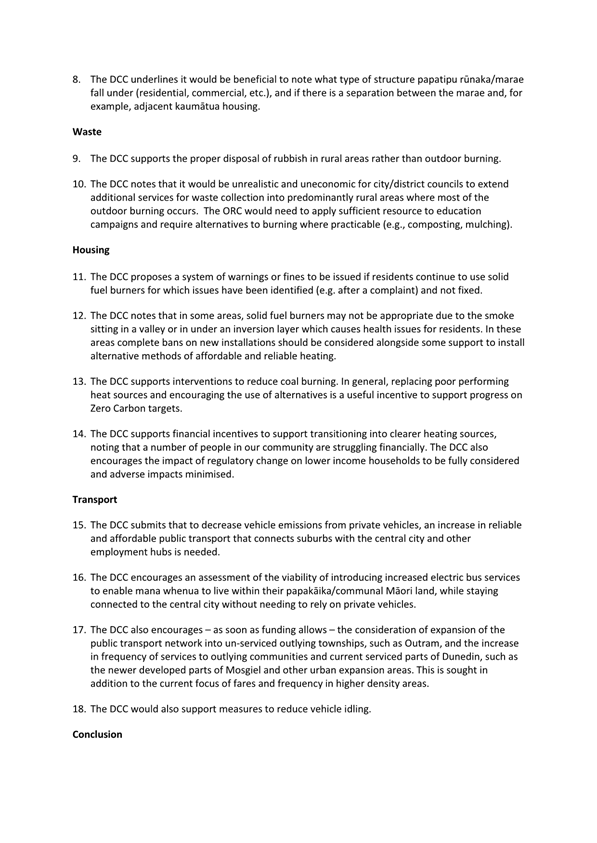
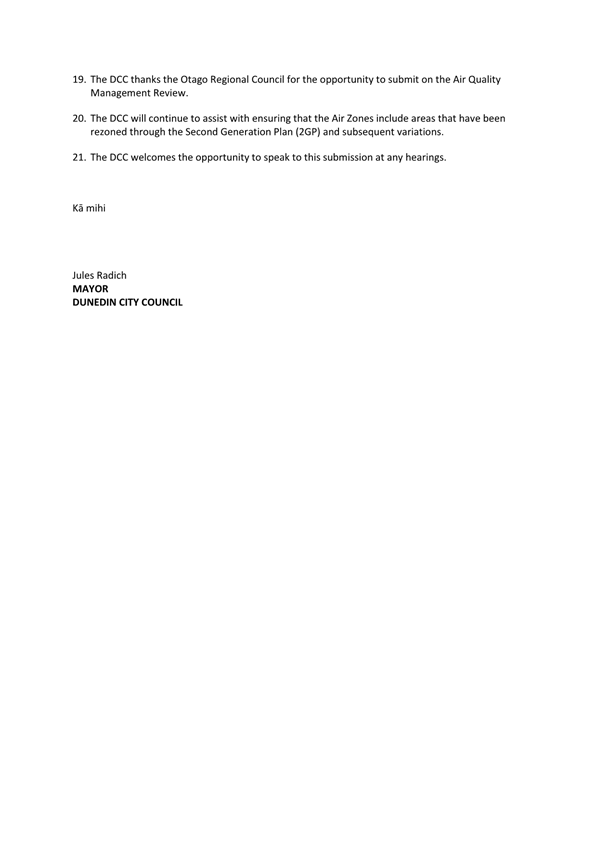
|

|
Council
24 September 2024
|
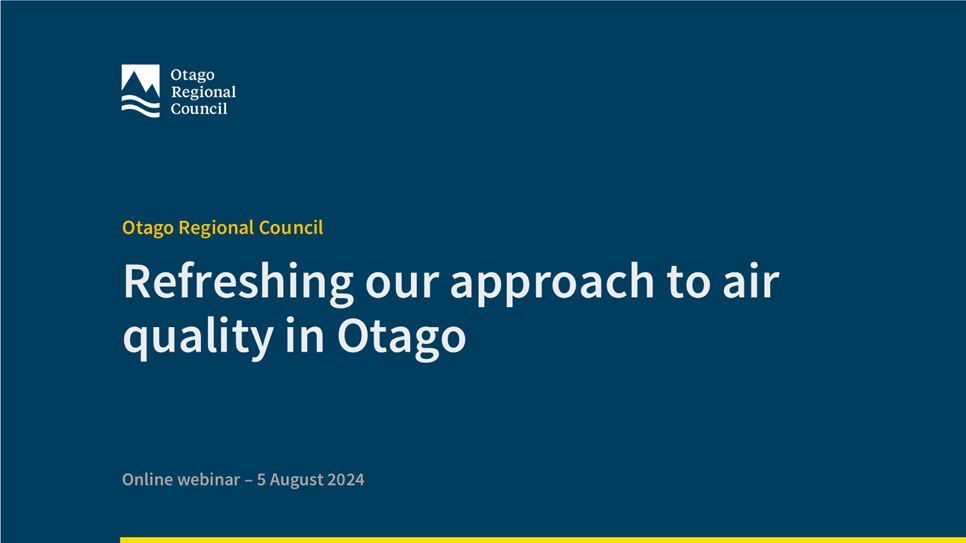
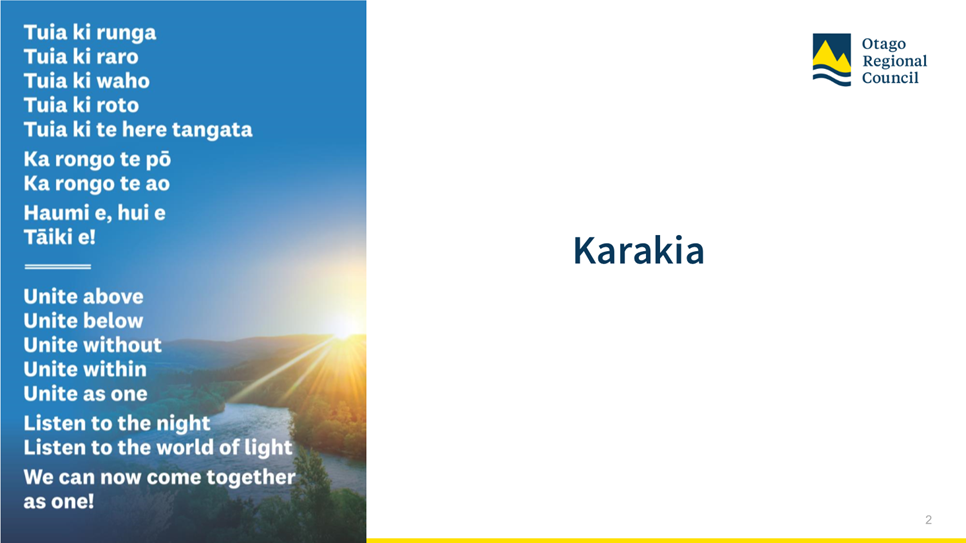
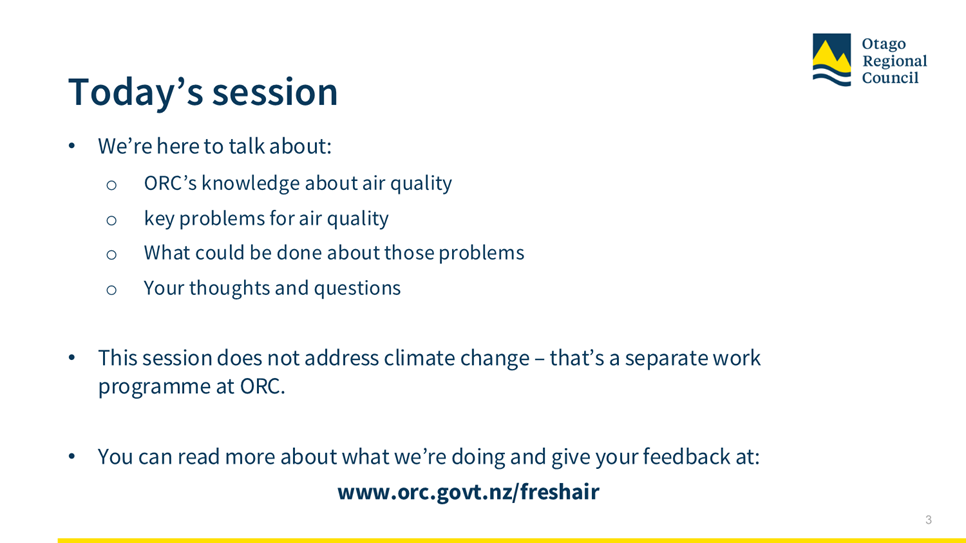
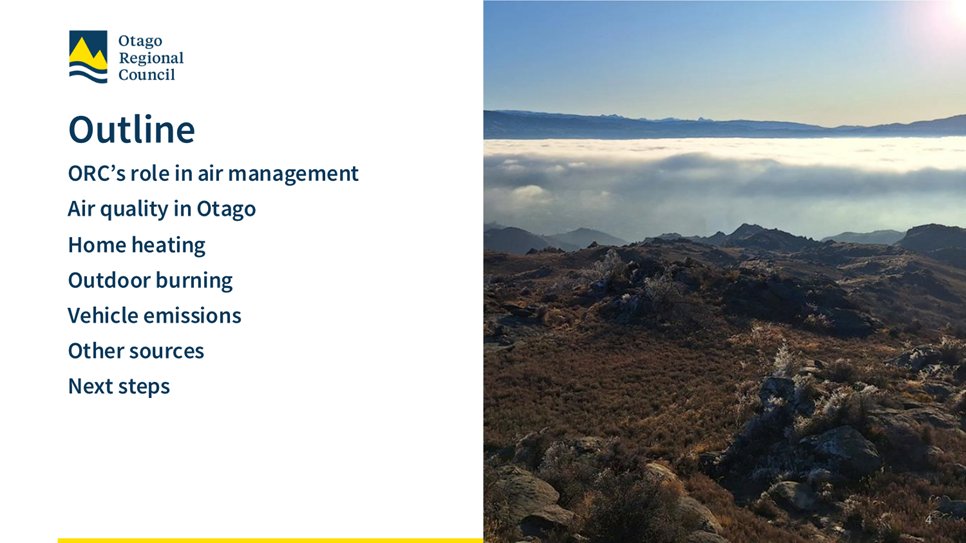
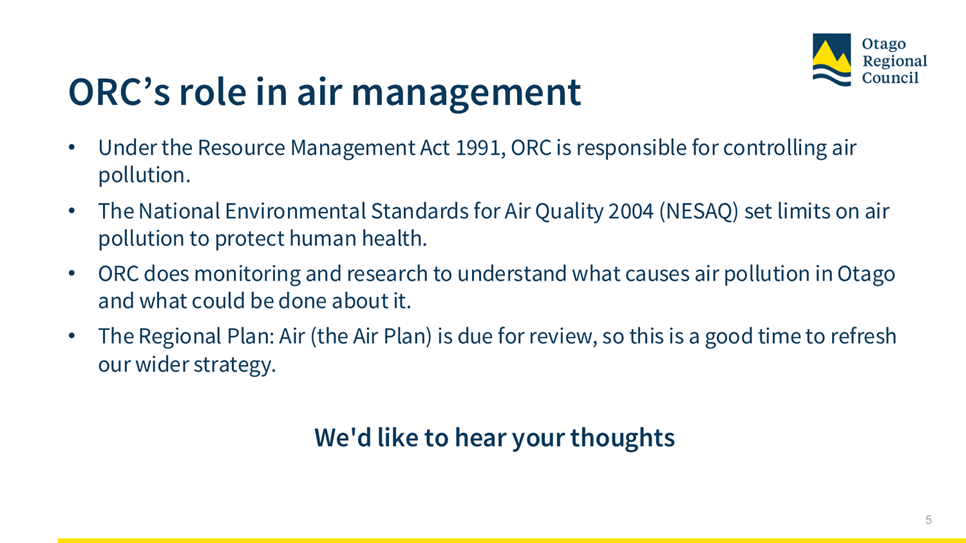
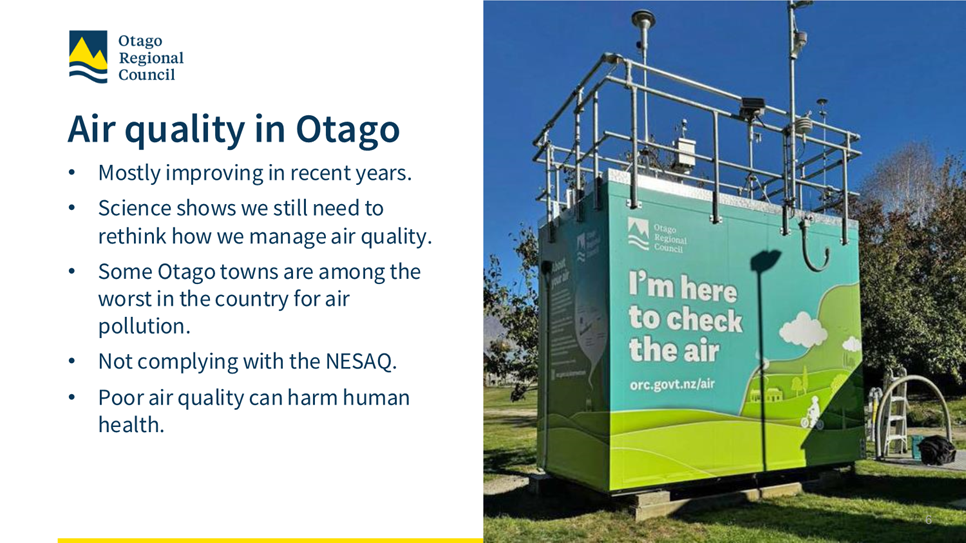
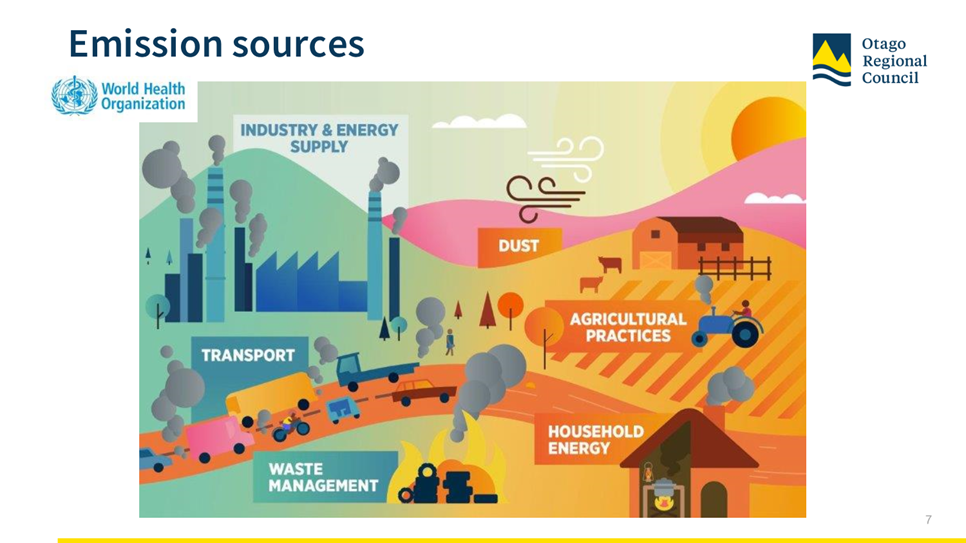


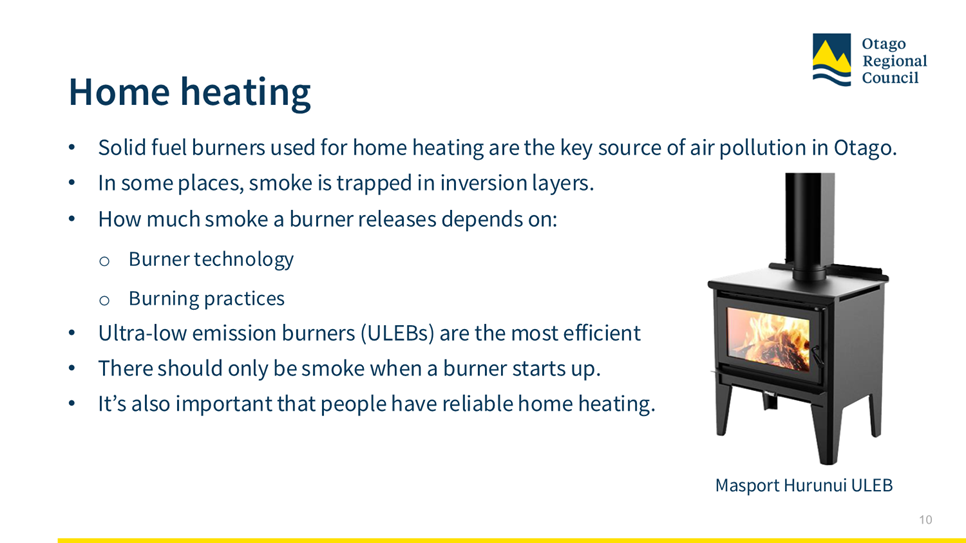
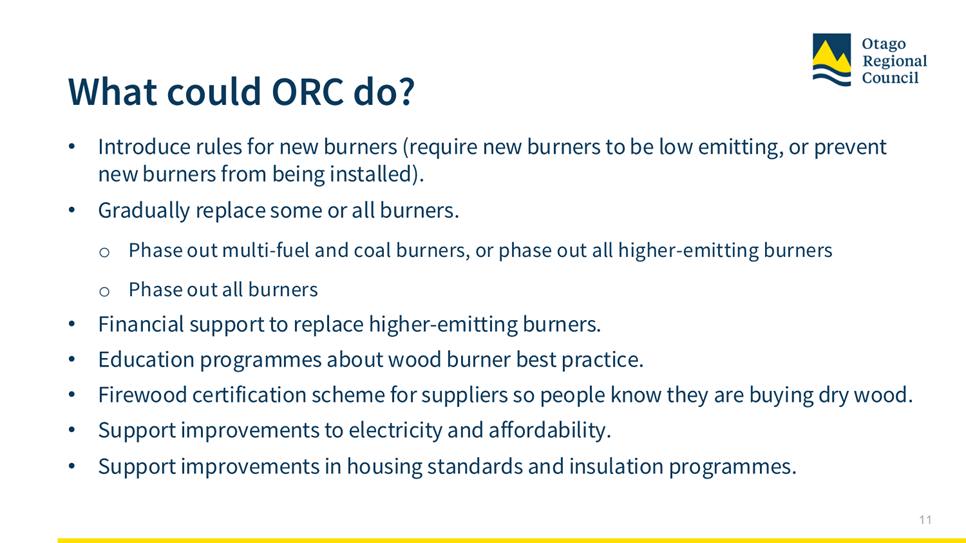
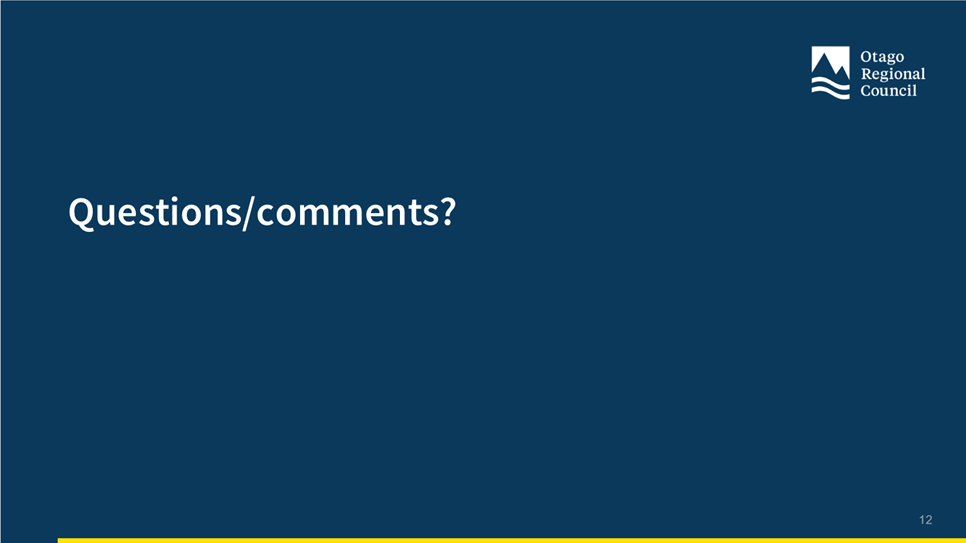
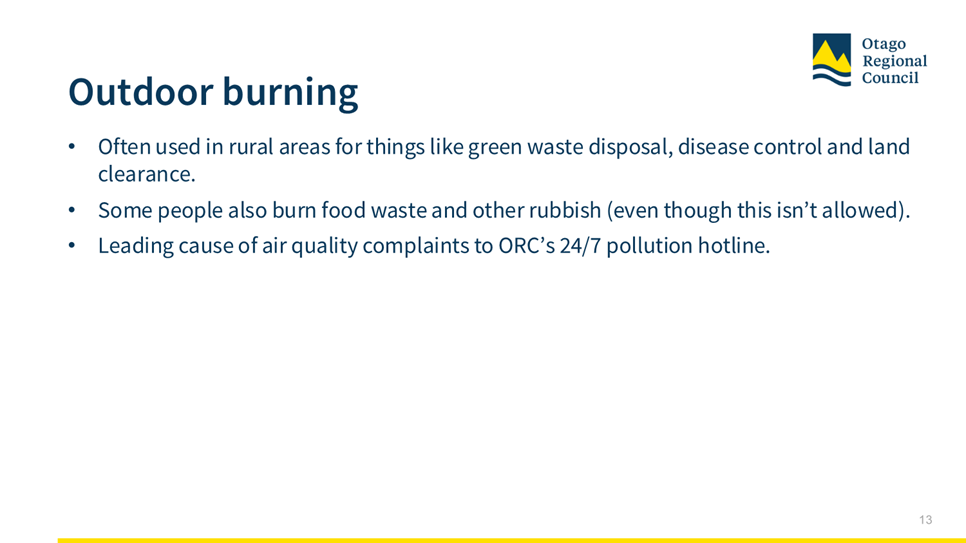

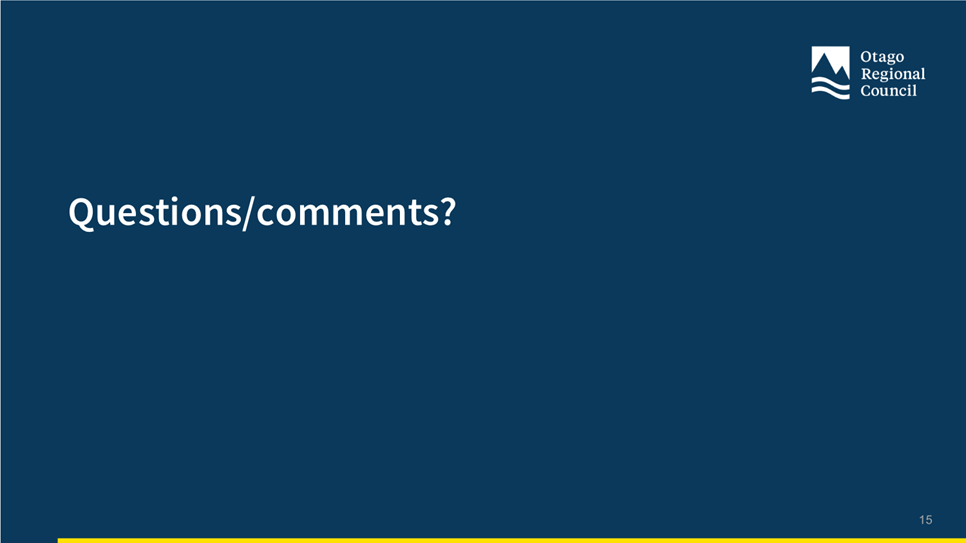
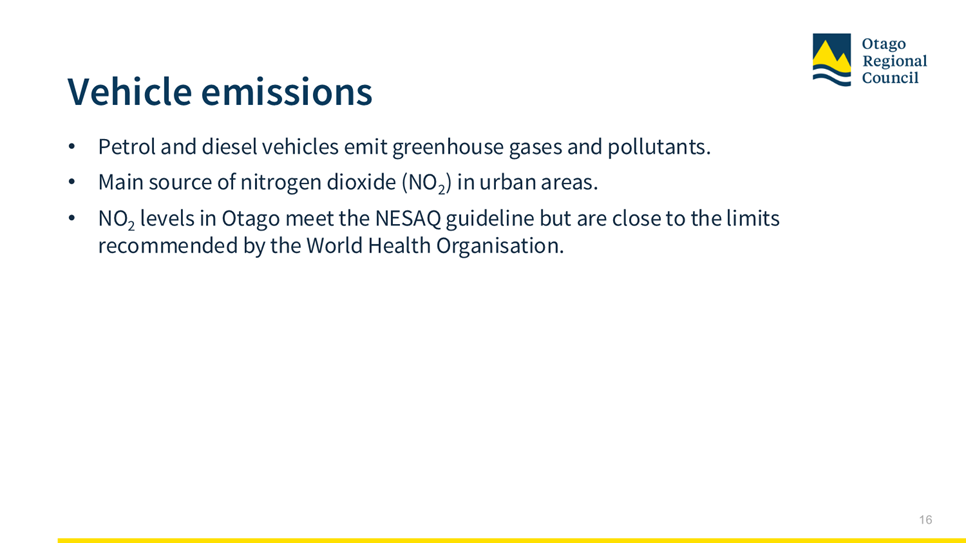
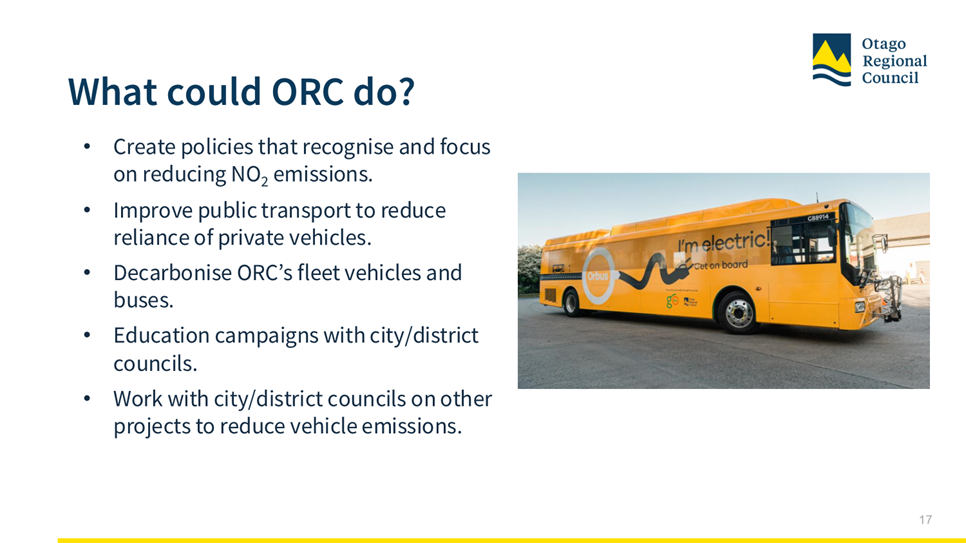
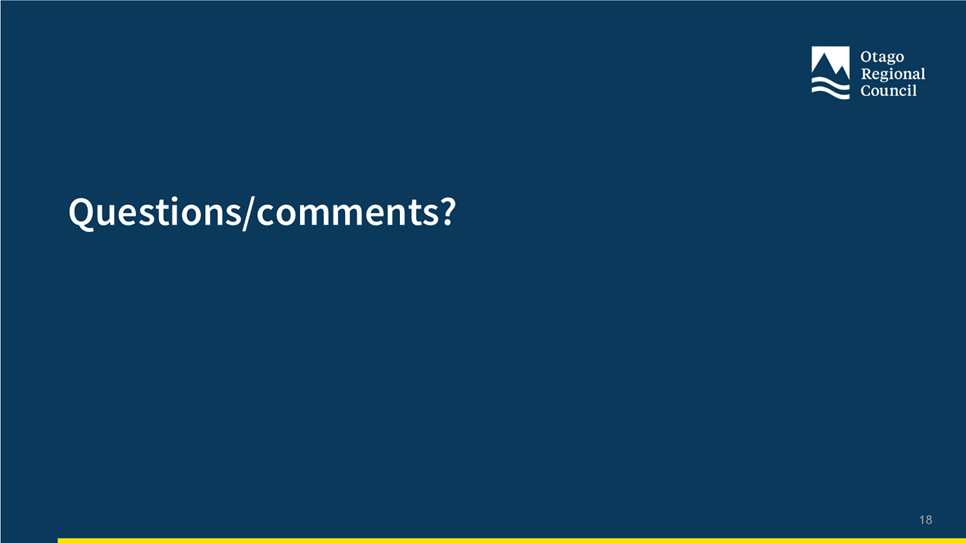
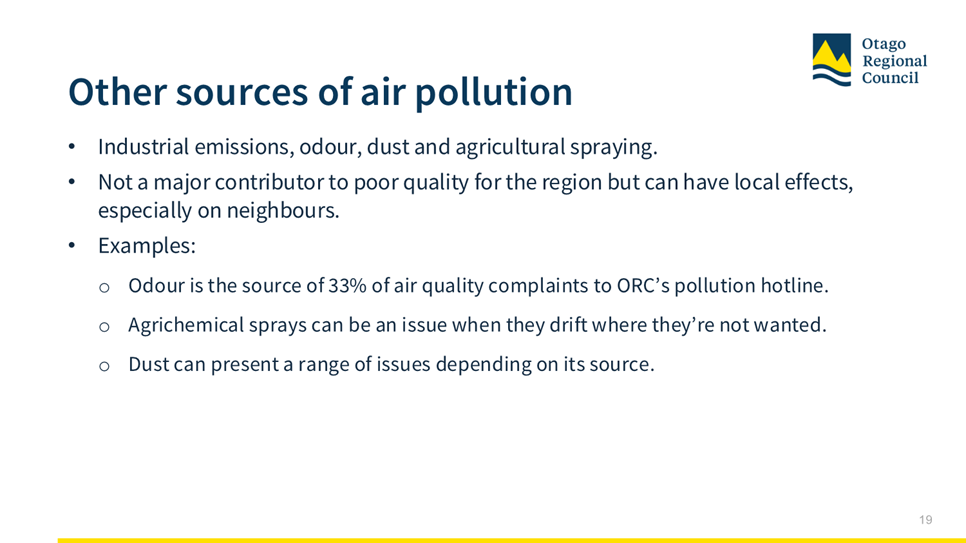
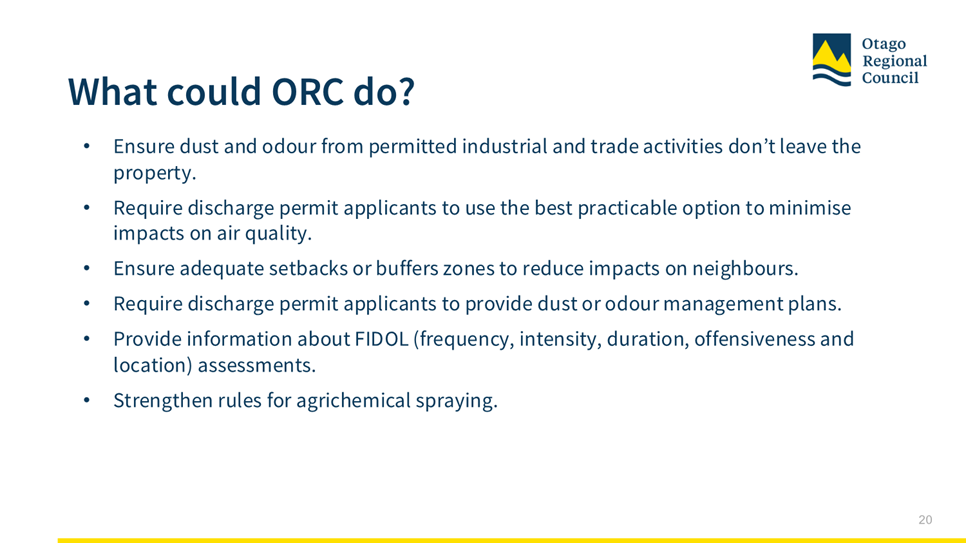
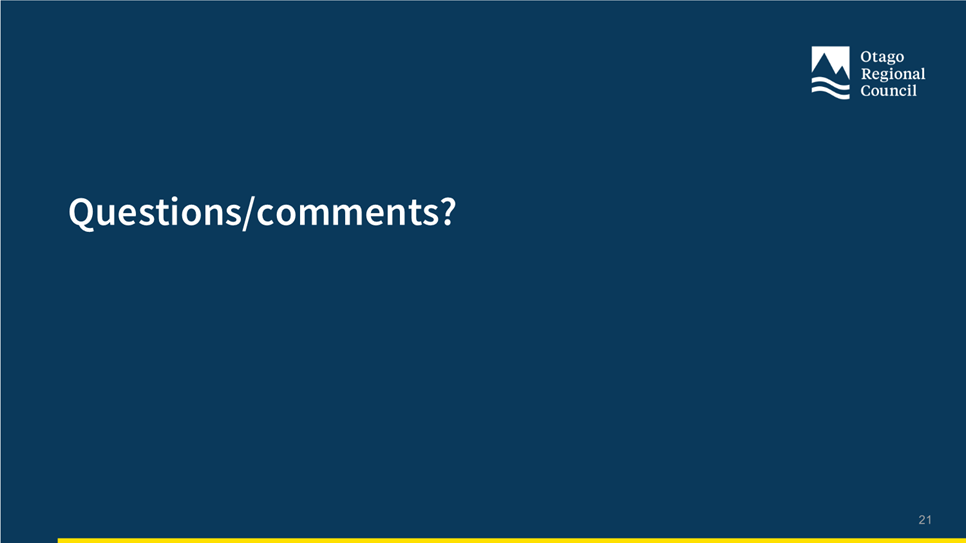
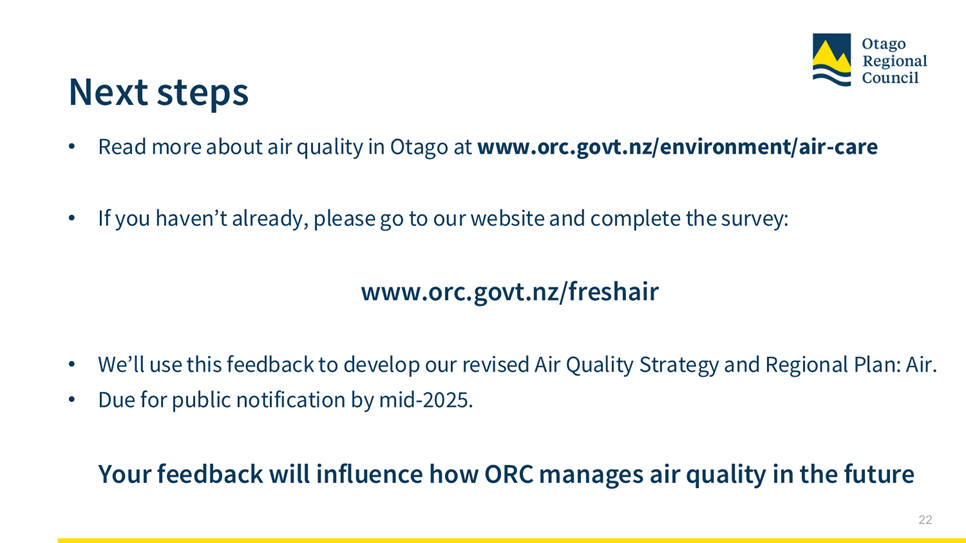
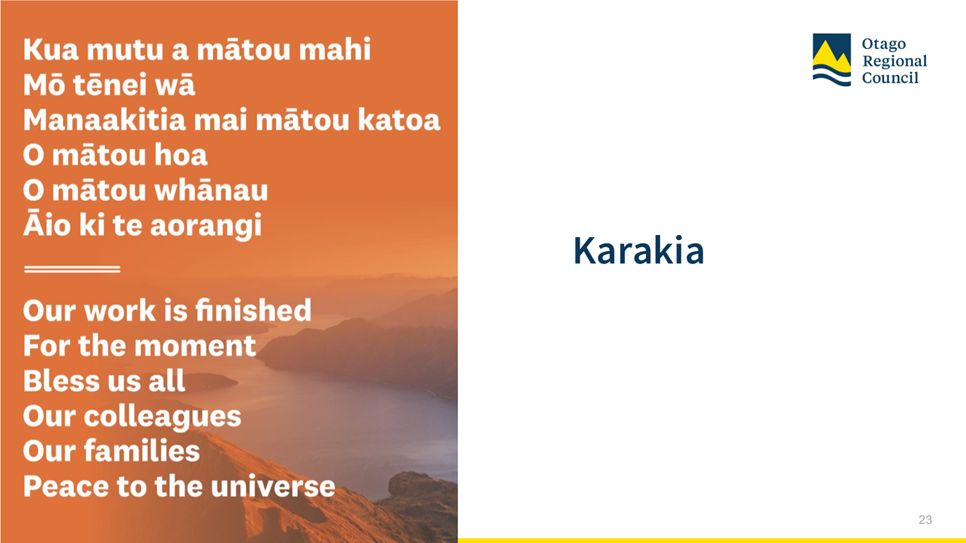

|

|
Council
24 September 2024
|
Proposed Event Road Closures
Department: Transport
EXECUTIVE SUMMARY
1 The
DCC has received temporary road closure applications relating to the following
events:
a) Green
Island Market Day
b) Rainbow Run
c) New
Zealand Track and Field Championships
2 This
report recommends that Council approves the temporary closure of the affected
roads.
RECOMMENDATIONS
That the Council:
a) Resolves to close the
roads detailed below (pursuant to Section 319, Section 342, and Schedule 10
clause 11(e) of the Local Government Act 1974 (LGA 1974)):
i) Green
Island Market Day
|
Saturday,
7 December 2024
|
7.00am to 3.00pm
|
Main South
Road Green Island,
from Howden Street to Church Street.
Jenkins
Street,
from Main South Road to Shand Street.
Parking
restrictions will be in place in Howden and Shand Streets.
|
ii) Rainbow Run
|
Sunday, 20 October
2024
|
11.00am to 12.30pm
|
Logan Park Drive, from Anzac Avenue to Butts
Road.
|
iii) 2025 New Zealand Track and Field Championships
|
Thursday, 6 March 2025
to
Sunday, 9 March 2025
|
7.00am to 8.00pm
|
Logan Park Drive, from Anzac Avenue to
Butts Road.
|
BACKGROUND
3 Council’s
Dunedin Festival and Events Plan supports the goal of a successful city with a
diverse, innovative, and productive economy and a hub for skill and
talent.
4 The
areas proposed to be used for these events are legal roads and can therefore be
temporarily closed to normal traffic if statutory temporary road closure
procedures are followed. The procedures are set out in Section 319 of the LGA
1974 and give Council the power to stop or close any road (or part of a road)
within the parameters of Section 342 and Schedule 10 of the LGA 1974 (Schedule
10 is included as Attachment A).
5 These
procedures include:
· Consultation
with the New Zealand Transport Authority Waka Kotahi and the Police.
· Public
notice being given of the proposal to close any road (or part of a road), and public
notice of a decision to close the road.
· Council
being satisfied that traffic is not likely to be unreasonably impeded.
6 A
resolution of Council is required where a proposal to temporarily close a road
relates to public functions.
7 Council
is required to give public notice of its decision. This notice will be
published after this meeting and prior to the event, if approved.
DISCUSSION
Consultation and Notification
8 The
Police and the New Zealand Transport Authority Waka Kotahi have no objections
to the proposed road closures.
9 On
Saturday, 17 August 2024, the proposed temporary road closures were advertised
in the Otago Daily Times (Attachment B) with a deadline for feedback.
10 The event
organisers contacted those considered affected prior to submitting their
application, and no objections were received.
11 Schedule
10 clause 11(e) states a road cannot be closed more than 31 days in the
aggregate in any one year. This limit will not be exceeded by the
approval of the proposed temporary road closures.
Traffic Impacts
12 The event
locations of these events have had identical road closures for the same, or
similar event(s) in prior years without causing unreasonable delays to the
travelling public.
13 Emergency
services and public transport services will be managed through the temporary
traffic management process.
14 The
Temporary Traffic Management Plan process ensures that other issues such as
temporary relocation of certain parking (e.g. taxi, mobility and Authorised
Vehicles Only) are managed.
OPTIONS
15 Note any
amendment to this report’s recommendations cannot be implemented without
further consultation with the affected parties, New Zealand Transport Agency Waka
Kotahi, the Police, and verifying that traffic impacts are acceptable.
Option One – Recommended Option
16 That the Council
closes the sections of road as recommended in this report.
Advantages
· Roads
can be closed, and the event will be able to proceed.
· The
closures will assist in realising the economic, social, and cultural benefits
associated with the events.
Disadvantages
· There
will be temporary loss of vehicular access through the closed areas. However,
there are detours available, and safety can be assured using temporary traffic
management.
Option Two – Status Quo
17 That the
Council decides not to close the roads in question.
Advantages
· There
would be no detour required for the travelling public, and the roads would be
able to be used as normal.
Disadvantages
· The
events would not be able to go ahead, and the benefits of the events would be
lost.
NEXT STEPS
18 Should the
resolution be made to temporarily close the roads, Council staff will accept
the temporary traffic management plans that have been received for the events
and notify the public of the closures.
Signatories
|
Authoriser:
|
Jeanine Benson - Group Manager Transport
Scott MacLean - General Manager, Climate and City Growth
|
Attachments
|
|
Title
|
Page
|
|
⇩a
|
Local Governement Act
1974, Schedule 10
|
255
|
|
⇩b
|
ODT advertising 17 08
2024
|
260
|
|
SUMMARY
OF CONSIDERATIONS
|
|
Fit with purpose of Local
Government
This decision
promotes the social well-being of communities in the present and for the
future.
|
|
Fit with strategic
framework
|
|
Contributes
|
Detracts
|
Not applicable
|
|
Social Wellbeing Strategy
|
✔
|
☐
|
☐
|
|
Economic Development
Strategy
|
✔
|
☐
|
☐
|
|
Environment Strategy
|
☐
|
☐
|
✔
|
|
Arts and Culture Strategy
|
✔
|
☐
|
☐
|
|
3 Waters Strategy
|
☐
|
☐
|
✔
|
|
Spatial Plan
|
☐
|
☐
|
✔
|
|
Integrated Transport
Strategy
|
☐
|
☐
|
✔
|
|
Parks and Recreation
Strategy
|
☐
|
☐
|
✔
|
|
Other strategic projects/policies/plans
|
✔
|
☐
|
☐
|
Events contribute to the
Strategic Framework. Events contribute to the Economic Development Strategy,
the Social Wellbeing Strategy. There is a Festival and Events Plan 2018-2023.
|
|
Māori Impact
Statement
Mana whenua have not been
directly engaged with in relation to these road closures.
|
|
Sustainability
There are no implications
for sustainability.
|
|
LTP/Annual Plan /
Financial Strategy /Infrastructure Strategy
There are no implications,
as the decision is a regulatory one and there are no direct costs to Council.
|
|
Financial considerations
There are no financial
implications. The cost of the proposed road closure is not a cost to
Council.
|
|
Significance
This decision is considered
low in terms of the Council’s Significance and Engagement Policy.
|
|
Engagement –
external
There has been external
engagement (as required by the LGA 1974), with the Police and New Zealand
Transport Agency Waka Kotahi. Affected parties were notified and provided a
time period for feedback.
|
|
Engagement - internal
There has been engagement
with DCC Events and Transport. There is support for the events to
proceed.
|
|
Risks: Legal / Health and
Safety etc.
There are no identified
risks should the recommended resolution be made.
|
|
Conflict of Interest
There are no known
conflicts of interest.
|
|
Community Boards
There are no implications
for Community Boards.
|
|

|
Council
24 September 2024
|
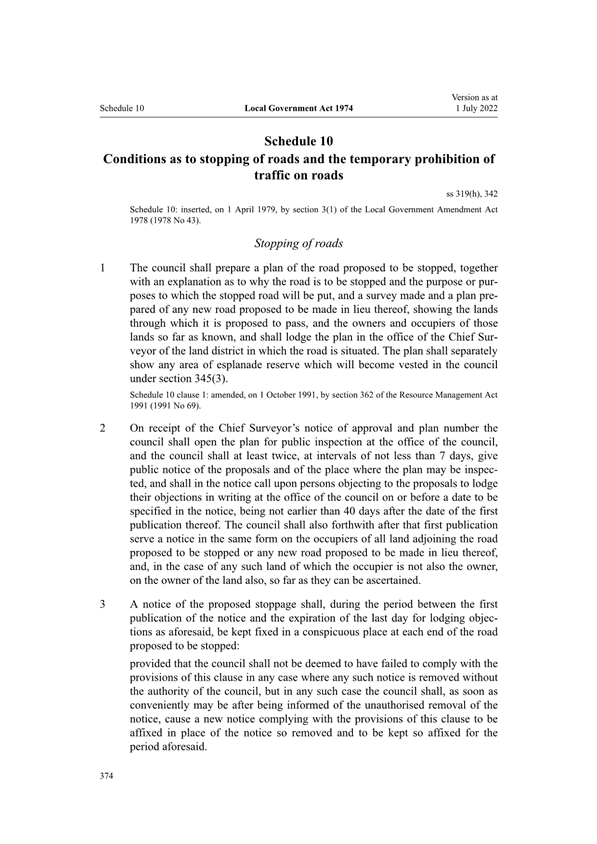
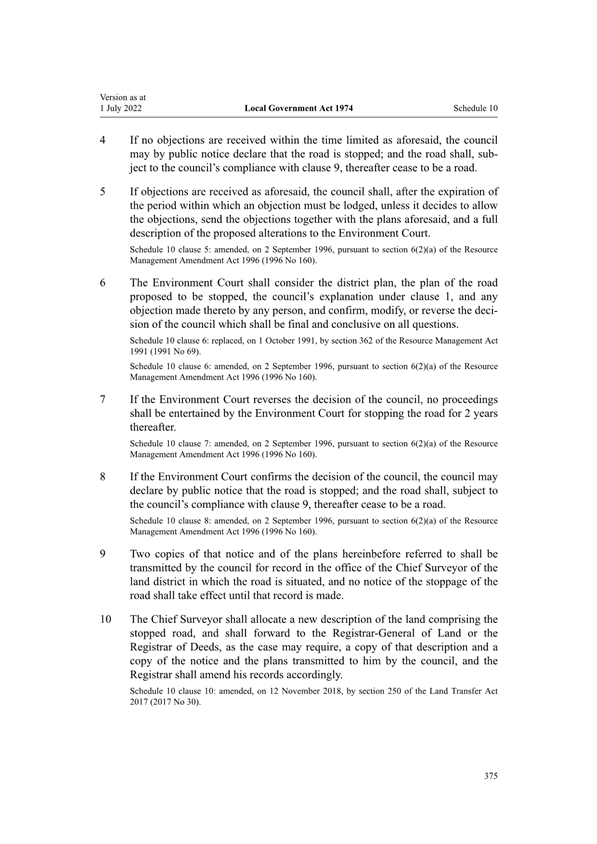
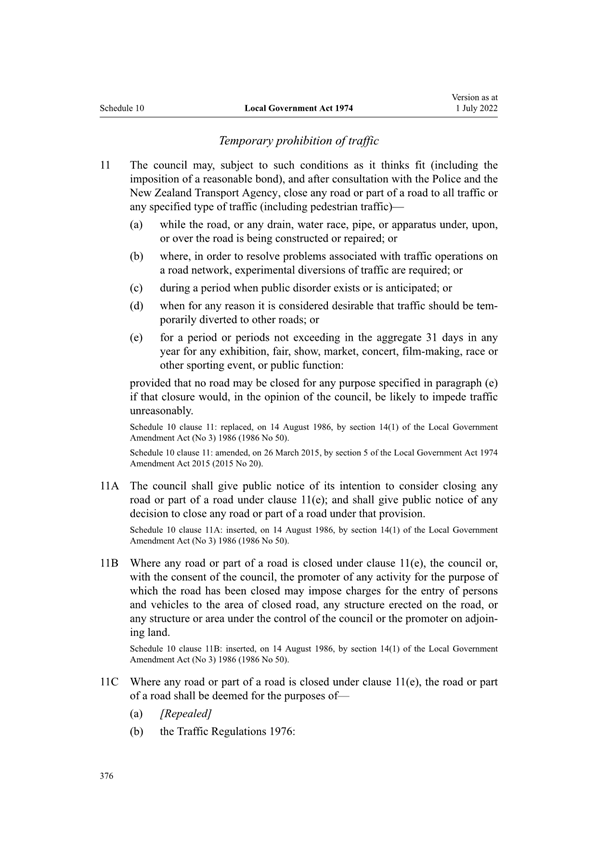

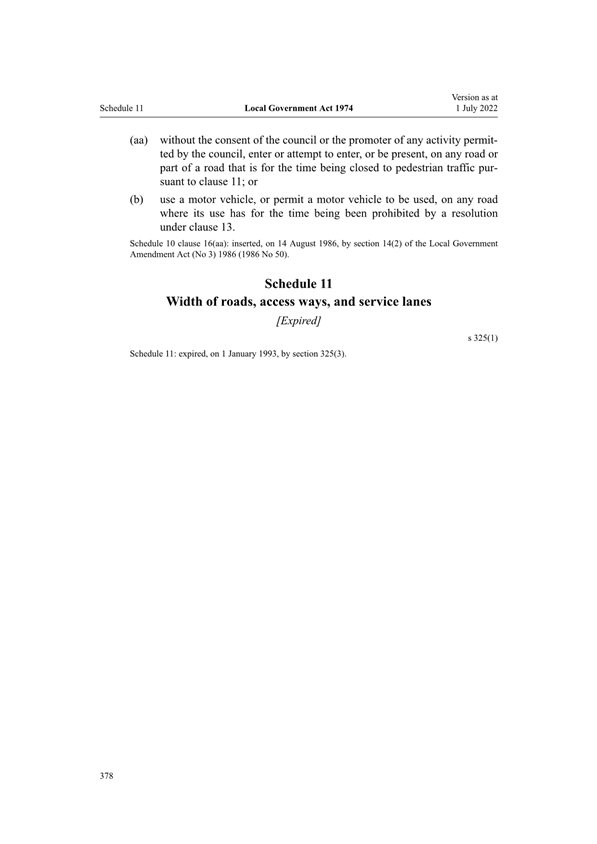
|

|
Council
24 September 2024
|
ODT DCC NOTICEBOARD
Road Closure
Notice – 17th August 2024
__________________________________________________________________________________
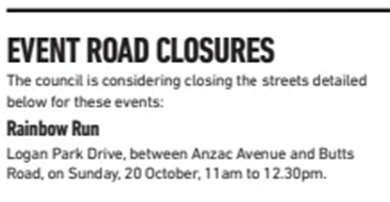
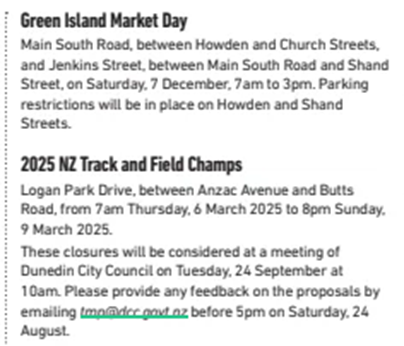
|

|
Council
24 September 2024
|
Resolution to Exclude the
Public
That the Council excludes
the public from the following part of the proceedings of this meeting (pursuant
to the provisions of the Local Government Official Information and Meetings Act
1987) namely:
|
General subject of the matter to be considered
|
Reasons
for passing this resolution in relation to each matter
|
Ground(s) under
section 48(1) for the passing of this resolution
|
Reason for
Confidentiality
|
|
C1
Confirmation of the Confidential Minutes of Ordinary Council meeting -
27 August 2024 - Public Excluded
|
S7(2)(a)
The
withholding of the information is necessary to protect the privacy of natural
persons, including that of a deceased person.
S7(2)(g)
The
withholding of the information is necessary to maintain legal professional
privilege.
S7(2)(h)
The
withholding of the information is necessary to enable the local authority to
carry out, without prejudice or disadvantage, commercial activities.
S7(2)(i)
The
withholding of the information is necessary to enable the local authority to
carry on, without prejudice or disadvantage, negotiations (including
commercial and industrial negotiations).
s48(1)(d)
Check
to make report confidential.
|
.
|
|
|
C2
Confidential Council Actions from Resolutions at Council Meetings
|
S7(2)(a)
The
withholding of the information is necessary to protect the privacy of natural
persons, including that of a deceased person.
S7(2)(g)
The
withholding of the information is necessary to maintain legal professional
privilege.
S7(2)(h)
The
withholding of the information is necessary to enable the local authority to
carry out, without prejudice or disadvantage, commercial activities.
S7(2)(i)
The
withholding of the information is necessary to enable the local authority to
carry on, without prejudice or disadvantage, negotiations (including
commercial and industrial negotiations).
|
S48(1)(a)
The public conduct of
the part of the meeting would be likely to result in the disclosure of
information for which good reason for withholding exists under section 7.
|
|
|
C3
Confidential Council Forward Work Programme - September 2024
|
S7(2)(h)
The
withholding of the information is necessary to enable the local authority to
carry out, without prejudice or disadvantage, commercial activities.
|
S48(1)(a)
The public conduct of
the part of the meeting would be likely to result in the disclosure of
information for which good reason for withholding exists under section 7.
|
|
|
C4
Confidential 9 Year Plan Forward Work Programme - September 2024
|
S7(2)(h)
The
withholding of the information is necessary to enable the local authority to
carry out, without prejudice or disadvantage, commercial activities.
|
S48(1)(a)
The public conduct of
the part of the meeting would be likely to result in the disclosure of
information for which good reason for withholding exists under section 7.
|
|
|
C5
Confidential documents for notification of 2GP Plan Change 1: Minor
improvements
|
S7(2)(j)
The
withholding of the information is necessary to prevent the disclosure or use
of official information for improper gain or improper advantage.
|
S48(1)(a)
The public conduct of
the part of the meeting would be likely to result in the disclosure of
information for which good reason for withholding exists under section 7.
|
|
|
C6
Dunedin City Holdings Group - Director Re-appointments
|
S7(2)(a)
The
withholding of the information is necessary to protect the privacy of natural
persons, including that of a deceased person.
|
S48(1)(a)
The public conduct of
the part of the meeting would be likely to result in the disclosure of
information for which good reason for withholding exists under section 7.
|
|
|
C7
Project Procurement Options
|
S6(a) - The making available of the
information would be likely to prejudice the maintenance of the law,
including the prevention, investigation, and detection of offences and the
right to a fair trial.
S7(2)(h) - The withholding of the information is necessary
to enable the local authority to carry out, without prejudice or
disadvantage, commercial activities
|
S48(1)(a)
The public conduct of
the part of the meeting would be likely to result in the disclosure of
information for which good reason for withholding exists under section 7.
|
|
This resolution is made in
reliance on Section 48(1)(a) of the Local Government Official Information and
Meetings Act 1987, and the particular interest or interests protected by
Section 6 or Section 7 of that Act, or Section 6 or Section 7 or Section 9 of
the Official Information Act 1982, as the case may require, which would be
prejudiced by the holding of the whole or the relevant part of the proceedings
of the meeting in public are as shown above after each item.







































































































